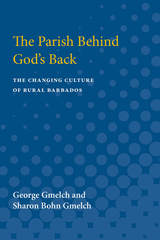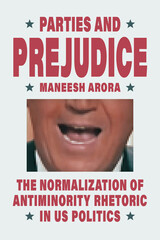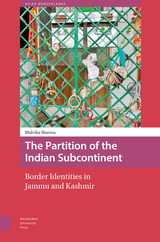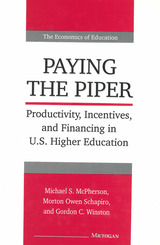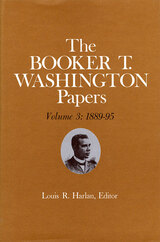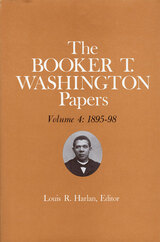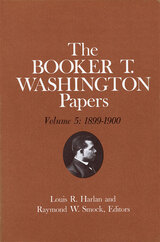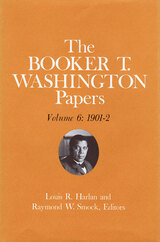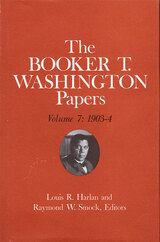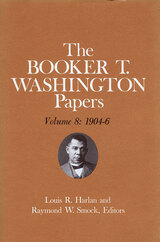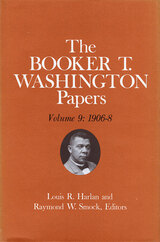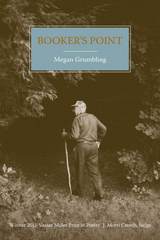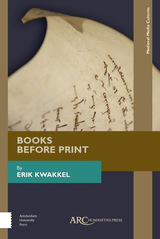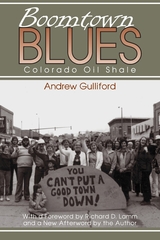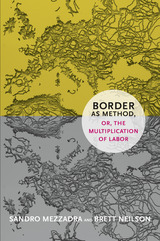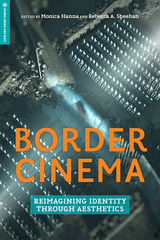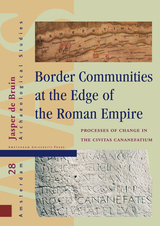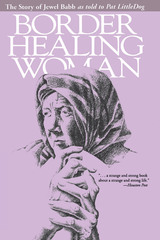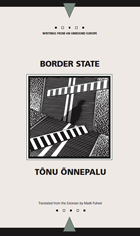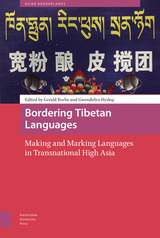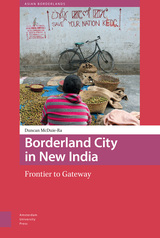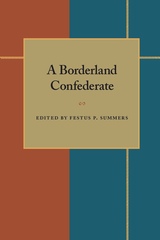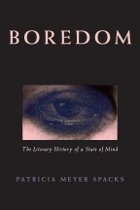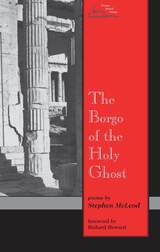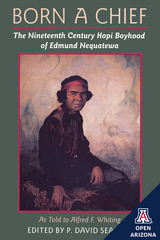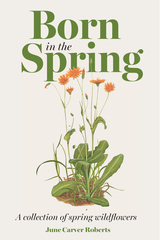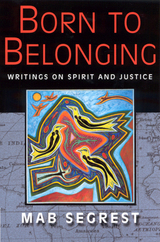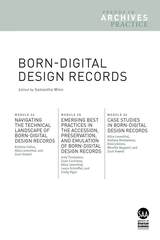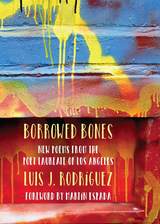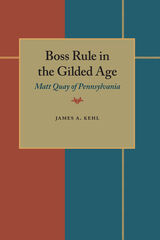Booker T. Washington Papers Volume 3: 1889-95. Assistant editors, Stuart B. Kaufman and Raymond W. Smock
Booker T. Washington. Edited by Louis R. Harlan, Assistant editors, Stuart B. Kaufman and Raymond W. Smock
University of Illinois Press, 1974 Washington's gradual rise to prominence as an educator, race leader, and shrewd political broker is revealed in this volume, which covers his career from May 1889 to September 1895, when he delivered the famous speech often called the Atlanta Compromise address. Much of the volume relates to Washington's role as principal of Tuskegee Institute, where he built a powerful base of operations for his growing influence with white philanthropists in the North, southern white leaders, and the black community.
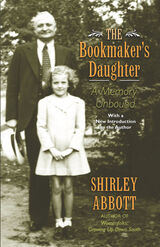 The Bookmaker's Daughter: A Memory Unbound
Shirley Abbott
University of Arkansas Press, 2006 This deeply felt memoir is a journey through family history, feminist insight, and southern mythology. In it a daughter reflects on the complicated and volatile love she and her father shared. Shirley Jean Abbott grew up in Hot Springs, Arkansas, in the 1940s and 50s and was the beloved daughter of Alfred Bemont Abbott, affectionately known as “Hat.” Hat wasn’t a bookmaker in the literary sense, even though he allowed Shirley’s mother to believe as much while they were dating. Rather, his craft was gambling, and his business was horse racing. Despite the corruption, which put food on the table and rabbit coats in the closet, Abbott remembers the kind and attentive father who spent nights reading to her. He alone is responsible for opening the door to a world of language and literature for her. And she ran with it. Against her father’s wishes, after graduation she headed for New York City. In the end, the girl he had nurtured into an independent and intelligent young woman had outgrown the small town where she grew up. The Bookmaker’s Daughter was originally published by Ticknor and Fields in 1992 and was a Book of the Month Club selection.
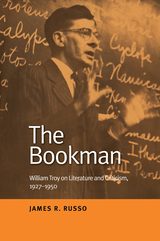 The Bookman: William Troy on Literature and Criticism, 1927–1950
James R. Russo
Sussex Academic Press, 2022 William Troy (1903-1961) was a highly regarded literary critic during the 1930s and 1940s. Among his contemporaries, he ranked with Edmund Wilson, Kenneth Burke, and F. O. Matthiessen. Indeed, in the preface to the posthumous, 1968 publication of his Selected Essays;, which won a National Book Award, Allen Tate placed Troy "among the handful of the best critics of this century." Troy's criticism was informed by an intelligence so balanced that, where many theoreticians took up positions in logical traps, he easily avoided them. At the very moment when scholars and critics were either treating literature like polemics or investigating ideas as if belles-lettres were a sub-category of history or philosophy, Troy acknowledged both the centrality of literary ideas and their distinction from ideas in other forms. When confronted with a text, he analyzed it with a firm sense of its inherent meaning and of its cultural implications, in a style that expresses seriousness of commitment precisely and clearly. The Bookman; presents a selection of Troy's remaining writings on such major literary figures as Henry James, E. E. Cummings, Ernest Hemingway, Edith Wharton, F. Scott Fitzgerald, T. S. Eliot, Andr Gide, William Faulkner, James Joyce, Albert Camus, Jean Cocteau, Willa Cather, W. H. Auden, Virginia Woolf, and mile Zola. Troy produced a body of work that is timeless, permanent, and exemplary—perhaps as much as, if not more so than, the work of such other critical contemporaries of his as the Anglo-Americans Yvor Winters, I. A. Richards, William Empson, George Jean Nathan, and R. P. Blackmur. Published in conjunction with Film Nation: William Troy on the Cinema, 19331935; (ISBN 978-1-78976-173-3), The Bookman; is clear evidence of Troy's role as one of the foremost critics of his age. Inclusion of a substantive index makes the work an essential and accessible gateway to a wide range of literary criticism.
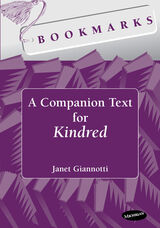 Bookmarks: A Companion Text for Kindred
Janet Giannotti
University of Michigan Press, 1999 Bookmarks: Fluency through Novels is a series of companion textbooks to novels that provide teachers with creative exercises and activities to supplement the teaching of a novel. Bookmarks: A Companion Text forKindred is an integrated reading-writing skills text that addresses each of the seven intelligences identified by Howard Gardner: there are tasks and activities for the linguistically, logically/mathematically, kinesthetically, spatially, musically, interpersonally, and intrapersonally intelligent students.
The textbook is designed to be used along with Kindred, a novel by Octavia Butler (published by Beacon Press), which tells the story of a young black woman who disappears from her home in 1970s California to save the life of her white slave-owner ancestor in the early nineteenth century. Through the novel and textbook, students learn about nineteenth-century American life, the origins of slavery in America, the conditions under which slaves lived, the Underground Railroad, important historical figures (like Harriet Tubman and Frederick Douglass), and the civil rights movement of the twentieth century.
Each of the six units begins with a preview of the reading and free writing topics, followed by exercises that improve comprehension and vocabulary building. Students use response journals to think about their personal connection with the novel. They are encouraged to discuss different topics and then write about what they've discussed. The Beyond the Novel section in each unit introduces factual background information in which students learn about slavery and other material mentioned in the novel. Puzzles and out-of-class activities are also included at the end of each unit.
 Bookmarks: A Companion Text for Like Water for Chocolate
Janet Giannotti
University of Michigan Press, 1999 A Companion Text forLike Water for Chocolate provides exercises and activities for ESL students who are reading the English translation of the novel by Laura Esquivel (published by Doubleday). Set during the late nineteenth and early twentieth centuries, Like Water for Chocolate is a story about an extended Mexican family and what happens when one daughter is not permitted to marry the man she loves. Cooking and food are central to the story line and help thread the story together.
A Companion TextforLike Water for Chocolate is made up of six units, each covering two chapters in the novel. Every unit contains a preview section, free writing exercises, a short glossary (to help with Spanish words), comprehension quizzes, vocabulary exercises and summarizing exercises, a section devoted to response journals, and topics for discussion. The "Beyond the Novel" section includes facts about U.S. and Mexican history and folk tales. Illustrations throughout the book help to engage students and offer visual support for reading comprehension.
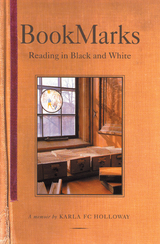 Bookmarks: Reading in Black and White, First Paperback Edition
Karla F. Holloway
Rutgers University Press, 2006 "BookMarks is a moving and revelatory memoir... a work of fiercely intelligent scholarship." - Susan Larson,
"Erudite and emotional in turns, [BookMarks] is full of truths that appeal to the head and the heart." - Charlotte News Observer"
What are you reading? What books have been important to you? Whether you are interviewing for a job, chatting with a friend or colleague, or making small talk, these questions arise almost unfailingly. Some of us have stock responses, which may or may not be a fiction of our own making. Others gauge their answers according to who is asking the question. Either way, the replies that we give are thoughtfully crafted to suggest the intelligence, worldliness, political agenda, or good humor that we are hoping to convey. We form our answers carefully because we know that our responses say a lot.
But what exactly do our answers say? In BookMarks, Karla FC Holloway explores the public side of reading, and specifically how books and booklists form a public image of African Americans. Revealing her own love of books and her quirky passion for their locations in libraries and on bookshelves, Holloway reflects on the ways that her parents guided her reading when she was young and her bittersweet memories of reading to her children. She takes us on a personal and candid journey that considers the histories of reading in children’s rooms, prison libraries, and “Negro” libraries of the early twentieth century, and that finally reveals how her identity as a scholar, a parent, and an African American woman has been subject to judgments that public cultures make about race and our habits of reading.
Holloway is the first to call our attention to a remarkable trend of many prominent African American writers—including Maya Angelou, W.E.B. Du Bois, Henry Louis Gates, Malcolm X, and Zora Neale Hurston. Their autobiographies and memoirs are consistently marked with booklists—records of their own habits of reading. She examines these lists, along with the trends of selection in Oprah Winfrey’s popular book club, raising the questions: What does it mean for prominent African Americans to associate themselves with European learning and culture? How do books by black authors fare in the inevitable hierarchy of a booklist?
BookMarks provides a unique window into the ways that African Americans negotiate between black and white cultures. This compelling rumination on reading is a book that everyone should add to their personal collections and proudly carry “cover out.”
Books against Tyranny: Catalan Publishers under Franco
Laura Vilardell
Vanderbilt University Press, 2022 Catalan-language publishers were under constant threat during the dictatorship of Francisco Franco (1939–75). Both the Catalan language and the introduction of foreign ideas were banned by the regime, preoccupied as it was with creating a "one, great, and free Spain." Books against Tyranny compiles, for the first time, the strategies Catalan publishers used to resist the censorship imposed by Franco's regime.
Author Laura Vilardell examines documents including firsthand witness accounts, correspondence, memoirs, censorship files, newspapers, original interviews, and unpublished material housed in various Spanish archives. As such, Books against Tyranny opens up the field and serves as an informative tool for scholars of Franco's Spain, Catalan social movements, and censorship more generally.
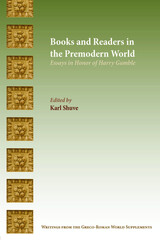 Books and Readers in the Premodern World: Essays in Honor of Harry Gamble
Karl Shuve
SBL Press, 2018 A book about the role of books in shaping the ancient religious landscape
This collection of essays by leading scholars from a variety of academic disciplines explores the ongoing relevance of Harry Gamble’s Books and Readers in the Early Church (1995) for the study of premodern book cultures. Contributors expand the conversation of book culture to examine the role the Hebrew Bible, the New Testament, and the Qur’an played in shaping the Jewish, Christian, and Muslim religions in the ancient and medieval world. By considering books as material objects rather than as repositories for stories and texts, the essays examine how new technologies, new materials, and new cultural encounters contributed to these holy books spreading throughout territories, becoming authoritative, and profoundly shaping three global religions.
Features:
- Comparative analysis of book culture in Roman, Jewish, Christian, and Islamic contexts
- Art-historical, papyrological, philological, and historical modes of analysis
- Essays that demonstrate the vibrant, ongoing legacy of Gamble’s seminal work
 Books Are Made Out of Books: A Guide to Cormac McCarthy's Literary Influences
By Michael Lynn Crews
University of Texas Press, 2017 Cormac McCarthy told an interviewer for the New York Times Magazine that “books are made out of books,” but he has been famously unwilling to discuss how his own writing draws on the works of other writers. Yet his novels and plays masterfully appropriate and allude to an extensive range of literary works, demonstrating that McCarthy is well aware of literary tradition, respectful of the canon, and deliberately situating himself in a knowing relationship to precursors.
The Wittliff Collection at Texas State University acquired McCarthy’s literary archive in 2007. In Books Are Made Out of Books, Michael Lynn Crews thoroughly mines the archive to identify nearly 150 writers and thinkers that McCarthy himself references in early drafts, marginalia, notes, and correspondence. Crews organizes the references into chapters devoted to McCarthy’s published works, the unpublished screenplay Whales and Men, and McCarthy’s correspondence. For each work, Crews identifies the authors, artists, or other cultural figures that McCarthy references; gives the source of the reference in McCarthy’s papers; provides context for the reference as it appears in the archives; and explains the significance of the reference to the novel or play that McCarthy was working on. This groundbreaking exploration of McCarthy’s literary influences—impossible to undertake before the opening of the archive—vastly expands our understanding of how one of America’s foremost authors has engaged with the ideas, images, metaphors, and language of other thinkers and made them his own.
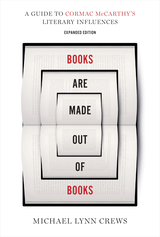 Books Are Made Out of Books: A Guide to Cormac McCarthy's Literary Influences
Michael Lynn Crews
University of Texas Press, 2024 Cormac McCarthy told an interviewer for the New York Times Magazine that “books are made out of books,” but he was famously unwilling to discuss how his own writing draws on the works of other writers. Yet his novels and plays masterfully appropriate and allude to an extensive range of literary works, demonstrating that McCarthy was well aware of literary tradition and deliberately situating himself in a knowing relationship to precursors. In Books Are Made Out of Books, Michael Lynn Crews thoroughly mines McCarthy’s literary archive to identify over 150 writers and thinkers that McCarthy referenced in early drafts, marginalia, notes, and correspondence. Crews organizes the references into chapters devoted to McCarthy’s published works, the unpublished screenplay Whales and Men, and McCarthy’s correspondence. This updated edition now examines McCarthy’s final publications: the novel The Passenger and its play-like coda Stella Maris. For each work, Crews identifies authors, artists, or other cultural figures that McCarthy referenced; gives the source of the reference in McCarthy’s papers; provides context for the reference as it appears in the archives; and explains the significance of the reference to the novel or play that McCarthy was working on. This groundbreaking exploration of McCarthy’s literary influences vastly expands our understanding of how one of America’s foremost authors engaged with the ideas, images, metaphors, and language of other thinkers and made them his own.
 Books Are Weapons: The Polish Opposition Press and the Overthrow of Communism
Siobhan Doucette
University of Pittsburgh Press, 2017 Much attention has been given to the role of intellectual dissidents, labor, and religion in the historic overthrow of communism in Poland during the 1980s. Books Are Weapons presents the first English-language study of that which connected them—the press. Siobhan Doucette provides a comprehensive examination of the Polish opposition’s independent, often underground, press and its crucial role in the events leading to the historic Round Table and popular elections of 1989. While other studies have emphasized the role that the Solidarity movement played in bringing about civil society in 1980-1981, Doucette instead argues that the independent press was the essential binding element in the establishment of a true civil society during the mid- to late-1980s.
Based on a thorough investigation of underground publications and interviews with important activists of the period from 1976-1989, Doucette shows how the independent press, rooted in the long Polish tradition of well-organized resistance to foreign occupation, reshaped this tradition to embrace nonviolent civil resistance while creating a network that evolved from a small group of dissidents into a broad opposition movement with cross-national ties and millions of sympathizers. It was the galvanizing force in the resistance to communism and the rebuilding of Poland’s democratic society.
Books Before Print
Erik Kwakkel
Arc Humanities Press, 2018 <div>This beautifully illustrated book provides an accessible introduction to the medieval manuscript and what it can tell us about the world in which it was made and used. <i>Books Before Print</i> explores how manuscripts can act as a vibrant and versatile tool to understand the deep historical roots of human interaction with written information. It highlights extraordinary continuities between medieval book culture and modern-world communication, as witnessed in medieval pop-up books, posters, speech bubbles, book advertisements, and even sticky notes.</div>
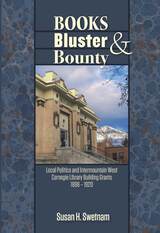 Books, Bluster, and Bounty: Local Politics and Carnegie Library Building Grants in the Intermountain West, 1890-1920
Susan H. Swetnam
Utah State University Press, 2012 Books, Bluster, and Bounty examines a cross-section of Carnegie library applications to determine how local support was mustered for cultural institutions in the late nineteenth and early twentieth century West. This comparative study considers the entire region between the Rockies and the Cascades/Sierras, including all of Idaho, Utah, Nevada, and Arizona; western Montana, Wyoming, and Colorado; eastern Oregon and Washington; and small parts of California and New Mexico. The author's purpose is to address not only the how of the process but also the variable why. Although virtually all citizens and communities in the West who sought Carnegie libraries expected tangible benefits for themselves that were only tangentially related to books, what they specifically wanted varied in correlation with the diverse nature of western communities. By looking at the detailed records of the Carnegie library campaigns, the author is able to provide an alternative lens through which to perceive and map the social-cultural makeup and town building of western communities at the turn of the century.
 Books Do Furnish a Room: Book 10 of A Dance to the Music of Time
Anthony Powell
University of Chicago Press, 1995 Anthony Powell’s universally acclaimed epic A Dance to the Music of Time offers a matchless panorama of twentieth-century London. Now, for the first time in decades, readers in the United States can read the books of Dance as they were originally published—as twelve individual novels—but with a twenty-first-century twist: they’re available only as e-books.
The tenth volume, Books Do Furnish a Room (1971), finds Nick Jenkins and his circle beginning to re-establish their lives and careers in the wake of the war. Nick dives into work on a study of Robert Burton; Widmerpool grapples with the increasingly difficult and cruel Pamela Flitton—now his wife; and we are introduced to the series’ next great character, the dissolute Bohemian novelist X. Trapnel, a man who exudes in equal measure mystery, talent, and an air of self-destruction.
"Anthony Powell is the best living English novelist by far. His admirers are addicts, let us face it, held in thrall by a magician."--Chicago Tribune
"A book which creates a world and explores it in depth, which ponders changing relationships and values, which creates brilliantly living and diverse characters and then watches them grow and change in their milieu. . . . Powell's world is as large and as complex as Proust's."--Elizabeth Janeway, New York Times
"One of the most important works of fiction since the Second World War. . . . The novel looked, as it began, something like a comedy of manners; then, for a while, like a tragedy of manners; now like a vastly entertaining, deeply melancholy, yet somehow courageous statement about human experience."--Naomi Bliven, New Yorker
“The most brilliant and penetrating novelist we have.”--Kingsley Amis
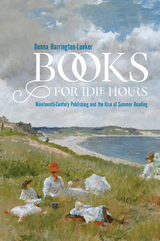 Books for Idle Hours: Nineteenth-Century Publishing and the Rise of Summer Reading
Donna Harrington-Lueker
University of Massachusetts Press, 2019 The publishing phenomenon of summer reading, often focused on novels set in vacation destinations, started in the nineteenth century, as both print culture and tourist culture expanded in the United States. As an emerging middle class increasingly embraced summer leisure as a marker of social status, book publishers sought new market opportunities, authors discovered a growing readership, and more readers indulged in lighter fare.
Drawing on publishing records, book reviews, readers' diaries, and popular novels of the period, Donna Harrington-Lueker explores the beginning of summer reading and the backlash against it. Countering fears about the dangers of leisurely reading—especially for young women—publishers framed summer reading not as a disreputable habit but as a respectable pastime and welcome respite. Books for Idle Hours sheds new light on an ongoing seasonal publishing tradition.
 Books Like Sapphires: From the Library of Congress Judaica Collection
Ann Brener
Brandeis University Press, 2024 Illustrated highlights from the Judaica Collection of the Library of Congress.
Books Like Sapphires showcases a wide range of Hebraic treasures from the storied collection at the Library of Congress, many of them for the first time. Tracing the history of Judaica collecting in the twentieth-century United States, the book illuminates varied works, telling their stories alongside vibrant color images. These include a unique manuscript about a betrothal scandal in Renaissance Crete, an illustrated Esther Scroll, a poem from 1477 celebrating the new technology of printing, amusing rhymed couplets in sixteenth-century Padua, and the Washington Haggadah. This book also tells the story of the patrons and collectors, first among them Jacob Schiff, as well as archivists and curators, who made the storied Judaica archive at the Library of Congress the precious resource that it is today.
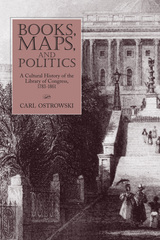 Books, Maps, and Politics: A Cultural History of the Library of Congress, 1783-1861
Carl Ostrowski
University of Massachusetts Press, 2004 Delving into the origins and development of the Library of Congress, this volume ranges from the first attempt to establish a national legislative library in 1783 to the advent of the Civil War. Carl Ostrowski shows how the growing and changing Library was influenced by—and in turn affected—major intellectual, social, historical, and political trends that occupied the sphere of public discourse in late eighteenth- and early nineteenth-century America.
The author explores the relationship between the Library and the period's expanding print culture. He identifies the books that legislators required to be placed in the Library and establishes how these volumes were used. His analysis of the earliest printed catalogs of the Library reveals that law, politics, economics, geography, and history were the subjects most assiduously collected. These books provided government officials with practical guidance in domestic legislation and foreign affairs, including disputes with European powers over territorial boundaries.
Ostrowski also discusses a number of secondary functions of the Library, one of which was to provide reading material for the entertainment and instruction of government officials and their families. As a result, the richness of America's burgeoning literary culture from the 1830s to the 1860s was amply represented on the Library's shelves. For those with access to its Capitol rooms, the Library served an important social function, providing a space for interaction and the display and appreciation of American works of art.
Ostrowski skillfully demonstrates that the history of the Library of Congress offers a lens through which we can view changing American attitudes toward books, literature, and the relationship between the federal government and the world of arts and letters.
Books of Secrets: Natural Philosophy in England, 1550-1600
Allison Kavey
University of Illinois Press, 2007 How cultural categories shaped--and were shaped by--new ideas about controlling nature Ranging from alchemy to necromancy, "books of secrets" offered medieval readers an affordable and accessible collection of knowledge about the natural world. Allison Kavey's study traces the cultural relevance of these books and also charts their influence on the people who read them. Citing the importance of printers in choosing the books' contents, she points out how these books legitimized manipulating nature, thereby expanding cultural categories, such as masculinity, femininity, gentleman, lady, and midwife, to include the willful command of the natural world.
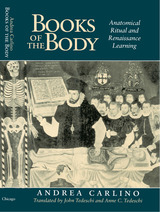 Books of the Body: Anatomical Ritual and Renaissance Learning
Andrea Carlino
University of Chicago Press, 1999 We usually see the Renaissance as a marked departure from older traditions, but Renaissance scholars often continued to cling to the teachings of the past. For instance, despite the evidence of their own dissections, which contradicted ancient and medieval texts, Renaissance anatomists continued to teach those outdated views for nearly two centuries.
In Books of the Body, Andrea Carlino explores the nature and causes of this intellectual inertia. On the one hand, anatomical practice was constrained by a reverence for classical texts and the belief that the study of anatomy was more properly part of natural philosophy than of medicine. On the other hand, cultural resistance to dissection and dismemberment of the human body, as well as moral and social norms that governed access to cadavers and the ritual of their public display in the anatomy theater, also delayed anatomy's development.
A fascinating history of both Renaissance anatomists and the bodies they dissected, this book will interest anyone studying Renaissance science, medicine, art, religion, and society.
 Books, Readers and Libraries in Fiction
Edited by Karen Attar and Andrew Nash
University of London Press, 2024 A chronological account of the depiction of books, libraries, and reading in fiction from the medieval period to the present.
Books and libraries appear in fiction from the earliest times onwards, in works for all age groups, in canonical literature, and in books that form part of popular culture. Fiction enables writers to teach readers how to read, but it can also portray subversive acts of reading that engage with contemporary cultural anxieties or moral debates. The reading material of fictional personae is part of their characterization; we are often reading readers.
Drawing on approaches from literary studies, book history, library history, and theories and histories of reading, Books, Readers and Libraries in Fiction examines what fictional representations of reading tell us about changing cultural attitudes to different reading practices, and the use (and abuse) of books beyond actual reading, both in the context of specific works and about the reception of books more widely. Through detailed case studies from primarily British fiction that address common themes such as gender, genre, and the relation between reading and writing itself, this collection catalogs the ways in which authors of fiction mediate and interpret books, libraries, and the act of reading to their own readers.
 Books Under Fire: A Hit List of Banned and Challenged Children's Books
Pat R. Scales
American Library Association, 2021 In our polarized environment, the censorship and outright banning of children’s books which some deem to be controversial or objectionable remains a major concern for libraries. Intellectual freedom champion Scales returns to the fray with a new edition of her matchless guide, updating the focus to titles published since 2015 which have been the target of challenges. School and public librarians, LIS students, and classroom educators will find the assistance and support they need to defend these challenged books with an informed response while ensuring access to young book lovers. For each of the dozens of titles covered, readers will find - a book summary;
- a report of the specific challenges;
- quotes from reviews, plus a list of awards and accolades;
- talking points for discussing the book's issues and themes;
- links to the book's website, additional resources about the book, and suggested further reading; and
- read-alikes that have been challenged for similar reasons.
 Books under Suspicion: Censorship and Tolerance of Revelatory Writing in Late Medieval England
Kathryn Kerby-Fulton
University of Notre Dame Press, 2006
"Now and again a study appears that in its particular combination of authorial talents, new materials, and fresh approach dramatically moves our shared scholarly enterprise forward. Kathryn Kerby-Fulton's Books Under Suspicion is precisely such an achievement. Kerby-Fulton is at once a careful and sensitive literary reader, a learned and rigorous intellectual historian, and an able writer of crisp English prose. The subject of Books Under Suspicion is the anxious world of late medieval English readers and writers. Censorship arises only when people believe that books matter. Kerby-Fulton shows us with admirable learning just how passionately the arbiters of religious orthodoxy and social order thought they mattered in late medieval England. The book is, among other things, an important new chapter in the history of ideas and the passionate contest for their control." —John V. Fleming, Princeton University
"In her monumentalBooks Under Suspicion, Kathryn Kerby-Fulton offers a brilliantly nuanced, sharply revisionist account of intellectual freedom in the fourteenth and fifteenth centuries. She presents us with a far less insular England than we are used to seeing–-an England swept by fierce, invigorating, often stormy theological winds from across the Channel. In this narrative Lollards rub shoulders with Joachite prophets, Free Spirit mystics, Continental visionaries, and radical Ockhamists, and the most threatening targets of censure or censorship are not necessarily the ones we would have guessed. Kerby-Fulton brings unparalleled precision to her study of tolerance and repression directed at 'the left wing of orthodoxy.' " —Barbara Newman, Northwestern University
"In this ambitious study of the circulation and censorship of visionary theologies in later medieval England, Kathryn Kerby-Fulton undertakes a thorough overhaul of what we think we know about many aspects of English religious thought and offers a reproof to the habit of treating it in splendid isolation from wider European developments. Learned, impassioned, and rich in new insights, arguments, and evidences, there is enough material here to keep scholars busy for years. A remarkable achievement." —Nicholas Watson, Harvard University
Books under Suspicion: Censorship and Tolerance of Revelatory Writing in Late Medieval England examines the censorship issues that propelled the major writers of the period toward their massive use of visionary genres. Kathryn Kerby-Fulton suggests that writers and translators as different as Chaucer, Langland, Julian of Norwich, “M.N.,” and Margery Kempe positioned their work to take advantage of the tacit toleration that both religious and secular authorities extended to revelatory theology. The book examines controversial ideas as diverse as the early experimental humanism of Chaucer, censured beatific vision theology and the breakdown of Langland's A Text, the English reception of M.N.'s translation of Marguerite Porete's condemned book, Julian's authorial suppression of her gender, and the impact of suspect Continental women's activism on Kempe.
Kerby-Fulton also narrates success stories of intellectual freedom, tracing evidence of ecclesiastical tolerance of revelation, the impossibility of official censorship in a manuscript culture, and the powerful, protected reading circles for radical apocalypticism and mysticism, such as those of the Austins and the Carthusians. Until now, Wycliffism has been seen as the only significant unorthodox or radical body of writings in late medieval England. Books under Suspicion is the first comprehensive study of banned non-Wycliffite materials in Insular writing during the period of the Avignon and Great Schism papacies.
This weighty, complex, and rewarding book makes use of neglected material in manuscripts and archives to reconstruct new aspects of the history of religious thought and vernacular writing in Ricardian and early Lancastrian England. As such it will interest scholars of late medieval religious history and Middle English literary history.
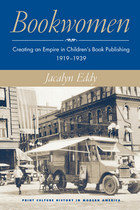 Bookwomen: Creating an Empire in Children’s Book Publishing, 1919–1939
Jacalyn Eddy
University of Wisconsin Press, 2006 The most comprehensive account of the women who, as librarians, editors, and founders of the Horn Book, shaped the modern children's book industry between 1919 and 1939. The lives of Anne Carroll Moore, Alice Jordan, Louise Seaman Bechtel, May Massee, Bertha Mahony Miller, and Elinor Whitney Field open up for readers the world of female professionalization. What emerges is a vivid illustration of some of the cultural debates of the time, including concerns about "good reading" for children and about women's negotiations between domesticity and participation in the paid labor force and the costs and payoffs of professional life.
Published in collaboration among the University of Wisconsin Press, the Center for the History of Print Culture in Modern America (a joint program of the University of Wisconsin–Madison and the Wisconsin Historical Society), and the University of Wisconsin–Madison General Library System Office of Scholarly Communication.
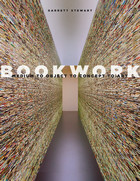 Bookwork: Medium to Object to Concept to Art
Garrett Stewart
University of Chicago Press, 2011 “There they rest, inert, impertinent, in gallery space—those book forms either imitated or mutilated, replicas of reading matter or its vestiges. Strange, after its long and robust career, for the book to take early retirement in a museum, not as rare manuscript but as functionless sculpture. Readymade or constructed, such book shapes are canceled as text when deposited as gallery objects, shut off from their normal reading when not, in some yet more drastic way, dismembered or reassembled.” So begins Bookwork, which follows our passion for books to its logical extreme in artists who employ found or simulated books as a sculptural medium. Investigating the conceptual labor behind this proliferating international art practice, Garrett Stewart looks at hundreds of book-like objects, alone or as part of gallery installations, in this original account of works that force attention upon a book’s material identity and cultural resonance. Less an inquiry into the artist’s book than an exploration of the book form’s contemporary objecthood, Stewart’s interdisciplinary approach traces the lineage of these aggressive artifacts from the 1919 Unhappy Readymade of Marcel Duchamp down to the current crisis of paper-based media in the digital era. Bookwork surveys and illustrates a stunning variety of appropriated and fabricated books alike, ranging from hacksawed discards to the giant lead folios of Anselm Kiefer. The unreadable books Stewart engages with in this timely study are found, again and again, to generate graphic metaphors for the textual experience they preclude, becoming in this sense legible after all.
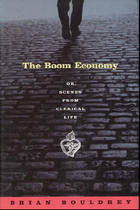 The Boom Economy: Or, Scenes from Clerical Life
Brian Bouldrey
University of Wisconsin Press, 2003 Dennis Bacchus is a man who has outlived himself. HIV-positive and prepared to die at any minute, he finds himself in the late 1990s blessed with life-giving drugs, supportive friends, a boom economy, and an era of never-ending celebration—and he doesn’t know what to do with himself.
For ten years he has traveled and celebrated a curtailed life with the similarly infected Jimmy and, though Dennis was never that close to Jimmy, he decided to let the friendship run its course to the end. Now there’s no end in sight. Stuck with leftover friendships, careers, and commitments, what can a man do but become a priest? The Boom Economy covers what was supposed to be the last decade of Dennis Bacchus’ life, but turns out to be the first decade of the rest of it.
The Boom Economy is a novel about conversion—not just seroconversion or religious conversion, but all of the social, spiritual, and emotional problems of changing from one life to another. At once raucous and serious, pagan and saintly, it’s a look at the way we live now. Again.
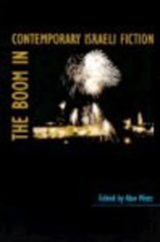 The Boom in Contemporary Israeli Fiction
Edited by Alan Mintz
Brandeis University Press, 1997 A critical introduction to contemporary Israeli literature that places works and writers in their cultural and social context. Five essays explore facets of what Mintz calls the complexity of cultural reverberations in Israeli fiction of the past two decades, a period during which "literature and the institutions of literary culture became the principal mode of encountering and mediating modernity." Among the major concerns addressed are the emergence of female writers, characterization of redefined gender roles, re-imagining the Holocaust, de-marginalization of Sephardic writing, and adoption of innovative techniques like magic realism and experimental narrative strategies. The collection shows how contemporary Israeli literature both chronicles and confronts cultural and societal dichotomies -- collectivism vs. individualism, native Israelis vs. Holocaust survivors, male vs. female, religion vs. secular, Ashkenazic vs. Sephardic -- that characterize a nation whose self-conception has been shaped by its complex and conflicted history. CONTRIBUTORS: Robert Alter, Nancy Berg, Yael S. Feldman, Anne Golomb Hoffman, Alan Mintz, Gilead Morahg
 Boomer Girls: Poems by Women from the Baby Boom Generation
Pamela Gemin
University of Iowa Press, 1999 Where were you between Betty Crocker and Gloria Steinem? With that question in mind poets Pamela Gemin and Paula Sergi began collecting the poems in Boomer Girls, an anthology of coming-of-age poems written by women born between 1945 and 1964, give or take a few years on either side. The answers to that question fill this volume with the energy, passion, heartbreak, and giddiness of women's lives from childhood to adolescence to middle age. The poems in Boomer Girls are by unknown, emerging, and established writers, women who participated in the second wave of feminism. From Sandra Cisneros' "My Wicked Wicked Ways" to Barbara Crooker's "Nearing Menopause, I Run into Elvis at Shoprite," from Wendy Mnookin's "Polio Summer" to Kyoko Mori's "Barbie Says Math Is Hard," these poems call for us to celebrate (in the words of poet Diane Seuss-Brakeman) "glances, romances, beauty and guilt, regret, remorse, rebates and rejuvenations." Boomer Girls share a common culture, bound by their generation's political history, by pop icons like Barbie—that pedestaled Boomer Girl who's just turned forty—and by the music that's never stopped playing: Janis Joplin, Marvin Gaye, Jimi Hendrix, the Ronettes, Van Morrison, Patsy Cline, John Lennon. The Boomer poets in this feisty anthology speak with diverse voices and embody a wide range of experiences, yet their generation's universal images—the hula hoops, TV shows, finned automobiles, and other household gods of their youth—unite them in ways both hilarious and tender.
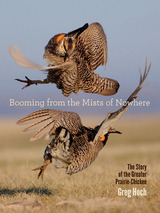 Booming from the Mists of Nowhere: The Story of the Greater Prairie-Chicken
Greg Hoch
University of Iowa Press, 2015 For ten months of the year, the prairie-chicken’s drab colors allow it to disappear into the landscape. However, in April and May this grouse is one of the most outrageously flamboyant birds in North America. Competing with each other for the attention of females, males gather before dawn in an explosion of sights and sounds—“booming from the mists of nowhere,” as Aldo Leopold wrote decades ago. There’s nothing else like it, and it is perilously close to being lost. In this book, ecologist Greg Hoch shows that we can ensure that this iconic bird flourishes once again.
Skillfully interweaving lyrical accounts from early settlers, hunters, and pioneer naturalists with recent scientific research on the grouse and its favored grasslands, Hoch reveals that the prairie-chicken played a key role in the American settlement of the Midwest. Many hungry pioneers regularly shot and ate the bird, as well as trapping hundreds of thousands, shipping them eastward by the trainload for coastal suppers. As a result of both hunting and habitat loss, the bird’s numbers plummeted to extinction across 90 percent of its original habitat. Iowa, whose tallgrass prairies formed the very center of the greater prairie-chicken’s range, no longer supports a native population of the bird most symbolic of prairie habitat.
The steep decline in the prairie-chicken population is one of the great tragedies of twentieth-century wildlife management and agricultural practices. However, Hoch gives us reason for optimism. These birds can thrive in agriculturally productive grasslands. Careful grazing, reduced use of pesticides, well-placed wildlife corridors, planned burning, higher plant, animal, and insect diversity: these are the keys. If enough blocks of healthy grasslands are scattered over the midwestern landscape, there will be prairie-chickens—and many of their fellow creatures of the tall grasses. Farmers, ranchers, conservationists, and citizens can reverse the decline of grassland birds and insure that future generations will hear the booming of the prairie-chicken.
Boomtown Blues: Colorado Oil Shale, Revised Edition
Andrew Gulliford
University Press of Colorado, 2011 Boomtown Blues examines the remarkable 100-year history of oil shale development and chronicles the social, environmental, and financial havoc created by the industry's continual cycles of boom and bust.
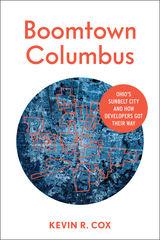 Boomtown Columbus: Ohio’s Sunbelt City and How Developers Got Their Way
Kevin R. Cox
Ohio State University Press, 2021 Columbus, Ohio, and its ample cloud cover may be on the eastern edge of the Midwest, but the city’s unfettered suburbanization and rapid postwar expansion recall its Sunbelt peers. To understand why—and the social and economic stakes of this all-too-common model of urban growth—pioneering geographer Kevin R. Cox takes us through the postwar history of development in Columbus, a city that has often welcomed corporate influence at the expense of livability and equal opportunity for its residents.
How have development interests become entwined with government? How has a policy of annexation reformed the city’s map? Why have airline service and major league prestige lagged behind its status as a regional center? And what, if anything, makes this city with a reputation for being average stand apart? In Boomtown Columbus, Cox applies both scholarly expertise and his personal experience as a long-time resident of the city to look at the real-life costs of policy. The resulting narrative will fascinate not only locals but anyone with a stake in understanding American cities and a path toward urban livability for all.
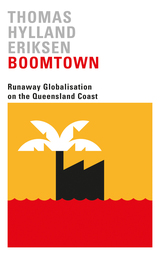 Boomtown: Runaway Globalisation on the Queensland Coast
Thomas Hylland Eriksen
Pluto Press, 2018 Sitting next to the Great Barrier Reef, steeped in coal and gas, the industrial boomtown of Gladstone, Australia embodies many of the contradictions of the “overheated” world: prosperous yet polluted, growing and developing, yet always on the precipice of crisis.
Capturing Gladstone at the peak of its accelerated growth in 2013–14, Thomas Hylland Eriksen dissects here the boomtown phenomenon in all its profound ambivalence. Based on ethnographic fieldwork, the book examines local identity, family life, infrastructure, and local services and explores the tensions and resentments surrounding migrant workers.
Writ large in Boomtown are the clashes of scale at the heart of the town’s contradictions, where the logic of big industry and the state compete with those of the individual and the local community and ecology, crystallizing the current crisis of political legitimacy that is unfurling all over the world.
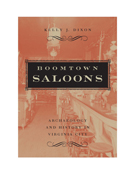 Boomtown Saloons: Archaeology And History In Virginia City
Kelly J. Dixon
University of Nevada Press, 2006 The image of Old West saloons as sites of violence and raucous entertainment has been perpetuated by film and legend, but the true story of such establishments is far more complex. In Boomtown Saloons, archaeologist Kelly J. Dixon recounts the excavation of four historic saloon sites in Nevada’s Virginia City, one of the West’s most important boomtowns, and shows how the physical traces of this handful of disparate drinking places offer a new perspective on authentic life in the mining West. During the second half of the nineteenth century, the Comstock Lode’s mineral wealth attracted people from all over the world. At its peak, Virginia City had a cosmopolitan population of over 20,000 people. Like people everywhere, they sought to pass their leisure time in congenial company, often in one or another of the four saloons studied here. Dixon’s account of the role these four establishments played in the social and economic life of Virginia City offers keen insight into the businesses and people who made up the backdrop of a mining boomtown. The saloons in this study were quieter than legend would have us believe; they served relatively distinct groups and offered their customers a place of refuge, solidarity, and social contact with peers in a city where few people had longtime ties or initially any close contacts. Boomtown Saloons also offers an equally vivid portrait of the modern historical archaeologist who combines time-honored digging, reconstruction, and analysis methods with such cutting-edge technology as DNA analysis of saliva traces on a 150-year-old pipestem and chemical analysis of the residue in discarded condiment bottles. The book is illustrated with historical photographs and maps, as well as photographs of artifacts uncovered during the excavations of the four sites. Dixon’s sparkling text and thoughtful interpretation of evidence reveal an unknown aspect of daily life in one of the West’s most storied boomtowns and demonstrate that, contrary to legend, the traditional western saloon served an vital and complex social role in its community.Available in hardcover and paperback.
 Boone, Black Hawk, and Crockett in 1833: Unsettling the Mythic West
Michael A. Lofaro
University of Tennessee Press, 2019 Although name such as Daniel Boone, Black Hawk, and “Davy” Crockett are familiar to most Americans, the historical, political, and literary contexts that produced the mythical images of these figures are unfamiliar to most outside academia. In Boone, Black Hawk, and Crockett in 1833, Michael A. Lofaro compiles, annotates, and analyzes three (auto)biographical writings published in Cincinnati, Ohio, in 1833-The Biographical Memoir of Daniel Boone; Life of Ma-ka-tai-me-she-kia-kiak, or Black Hawk; and The Life and Col. David Crockett of West Tennessee-to reveal how the portrayals of Boone, Black Hawk, and Crockett revised the idea of the “frontier hero.” By placing them together in dialogue through the scholarly reediting of their texts, Lofaro demonstrates that these works exemplify, typify, and epitomize masculinity, burgeoning capitalism, and Jacksonian democracy, probe beliefs in race and class, and provide nothing short of a deep dissection of the frontier mentality of the antebellum period. Additionally, the reception of these works influenced the ways in which nineteenth-century Americans understood and perceived manifest destiny, the removal of Native Americans from their homelands, to the west of the Mississippi River, and the waning concept of “American frontier.” With its great scope and insight, this publication creates connections among many academic disciplines, including colonial America, Jacksonian America, Native American studies, as well as literary and folklore studies.
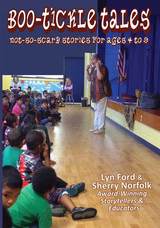 Boo-Tickle Tales: Not-So-Scary Stories for Ages 4-9
Lynette Ford & Sherry Norfolk
Parkhurst Brothers, Inc., 2016 The attraction of scary stories begins very early in childhood, but the fortitude to be truly scared comes later. So where are the scary stories for young children? Educators and storytellers, Ford and Norfolk deliver a silly and gently spooky collection of jumps, laughs, interactive moments, and mostly happy endings to satisfy the curious-for-creepy Pre-K through Grade 4 set. Their weirdly funny and gently scary collection of adapted folktales, original stories, and verses will delight those who enjoy being surprised more than being scared. This book is for: Parents, grandparents, and other mentors who work with children developmentally aged 4 to 9 Educators, librarians and others serving young listeners, who like silly and creepy stories, but may not like very scary material Audiences ages 4-9, who like creepy but not-too-scary stories. Twelve pen-and-ink drawings based on folktale motifs complement the fanciful tone of the book.
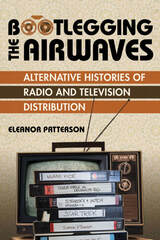 Bootlegging the Airwaves: Alternative Histories of Radio and Television Distribution
Eleanor Patterson
University of Illinois Press, 2024 How fan passion and technology merged into a new subculture Long before internet archives and the anytime, anywhere convenience of streaming, people collected, traded, and shared radio and television content via informal networks that crisscrossed transnational boundaries. Eleanor Patterson’s fascinating cultural history explores the distribution of radio and TV tapes from the 1960s through the 1980s. Looking at bootlegging against the backdrop of mass media’s formative years, Patterson delves into some of the major subcultures of the era. Old-time radio aficionados felt the impact of inexpensive audio recording equipment and the controversies surrounding programs like Amos ‘n’ Andy. Bootlegging communities devoted to buddy cop TV shows like Starsky and Hutch allowed women to articulate female pleasure and sexuality while Star Trek videos in Australia inspired a grassroots subculture built around community viewings of episodes. Tape trading also had a profound influence on creating an intellectual pro wrestling fandom that aided wrestling’s growth into an international sports entertainment industry.
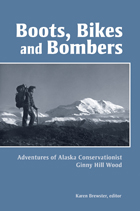 Boots, Bikes, and Bombers: Adventures of Alaska Conservationist Ginny Hill Wood
Edited by Karen Brewster
University of Alaska Press, 2012 Boots, Bikes, and Bombers presents an intimate oral history of Ginny Hill Wood, a pioneering Alaska conservationist and outdoorswoman. Born in Washington in 1917, Wood served as a Women’s Airforce Service Pilot in World War II, and flew a military surplus airplane to Alaska in 1946. Settling in Fairbanks, she went on to co-found Camp Denali, Alaska’s first wilderness ecotourism lodge; helped start the Alaska Conservation Society, the state’s first environmental organization; and applied her love of the outdoors to her work as a backcountry guide and an advocate for trail construction and preservation. An innovative and collaborative life history, Boots, Bikes, and Bombers, incorporates the story of friendship between the author and subject. The resulting book is a valuable contribution to the history of Alaska as well as a testament to the joys of living a life full of passion and adventure.
 The Bop Apocalypse: The Religious Visions of Kerouac, Ginsberg, and Burroughs
John Lardas
University of Illinois Press, 2000 Blending biography, cultural history, and literary criticism, The Bop Apocalypse explores the religious concerns, metaphysical realities, and spiritual pursuits that undergirded the early friendship and literary collaborations of Jack Kerouac, Allen Ginsberg, and William S. Burroughs.
Presenting a religious biography of the Beats from the mid-1940s to the late 1950s, John Lardas shows that in rejecting many of the cultural tenets of postwar America, Kerouac, Ginsberg, and Burroughs created new visions of both self and country, visions they articulated through distinctive literary forms. Lardas examines how the Beat writers distilled a theology of experience--a religious vision that animated their everyday existence as well as their art--from a flurry of disparate influences that included the saxophone wails of Charlie Parker and Lester Young, the psychology of Wilhelm Reich, the linguistic theories of Alfred Korzybski, the hipster dialects of New York City, and especially the prophecies of Oswald Spengler. Revisiting the major works the Beats produced in the 1950s in terms of critical content, Lardas considers how their lived religion was incorporated into the way they wrote.
The first sustained treatment of Beat religiosity, The Bop Apocalypse takes a sophisticated look beyond the cartoonish reductions of the Beat counterculture. The Bop Apocalypse takes the Beats at face value, interpreting their sexual openness, drug use, criminality, compulsion to travel, and madness as the logical, physical enactments of a religious representation of the world. Far from dallying irrelevantly on the fringes of society, Lardas asserts, the Beats engaged America on moral grounds through the discourse of public religion.
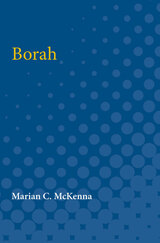 Borah
Marian C. McKenna
University of Michigan Press, 1961 Borah of Idaho focuses on William Borah: an all-time giant of the Senate and one of the most enigmatic of American statesmen. He was the nonconformist par excellence: a Republican by inheritance, a Democrat by inclination, "just plain Bill" to his constituents, an intellectual recluse to his colleagues; a staunch Progressive, and an opponent of the New Deal; a relentless enemy of the League of Nations, yet sponsor of the Foundation for the Outlawry of War; an isolationist who fought for recognition of the Soviet Union; a moralist who opposed the Child Labor Amendment.This, his first full-length biography, makes use of a vast collection of Borah's unpublished papers, and with fresh material at her disposal author Marian C. McKenna provides a colorful and convincing interpretation of his career. It was unmistakably American, filled with the vigor of Western frontier life and the rough and tumble of politics, local and national. Borah was that rare flower of an earlier America: the practical man governed by almost mystic loyalties to the American dream. Few men have been so eminently expressive of their time, yet throughout his six terms in the Senate he preserved an amazing freedom of thought and action. Many of the abuses he fought—monopoly, bureaucracy, secret diplomacy, federal extravagance—are perennial problems of the Republic, more pervasive now than they were in his day.The pages of this book are crowded with the notables of every administration from Theodore Roosevelt to Franklin Delano Roosevelt: LaFollette, Bryan, Wilson, Lodge, Knox, Stimson, Coolidge, Hoover—the men at the helm when the United States was achieving maturity and taking her place as a world power.
 Borchert Field: Stories from Milwaukee’s Legendary Ballpark
Bob Buege
Wisconsin Historical Society Press, 2017 Someone lucky enough to live on Milwaukee’s near north side between 1888 and 1952 could experience the world without ever leaving the neighborhood. Nestled between North Seventh and Eighth Streets and West Chambers and Burleigh, Borchert Field was Milwaukee’s major sports venue for 64 years. In this rickety wooden stadium (originally called Athletic Park), Wisconsin residents had a close-up view of sports history in the making, along with rodeos, thrill shows, and even multiple eruptions of Mount Vesuvius. In Borchert Field, baseball historian Bob Buege introduces the famous and fascinating athletes who dazzled audiences in Milwaukee’s venerable ballpark. All the legendary baseball figures—the Bambino, Satchel Paige, Ty Cobb, Joltin’ Joe, Jackie Robinson, the Say Hey Kid—played there. Olympic heroes Jim Thorpe, Babe Didrikson, and Jesse Owens displayed their amazing talents in Borchert. Knute Rockne’s Fighting Irish competed there, and Curly Lambeau’s Green Bay Packers took the field 10 times. Buege tells stories of other monumental moments at Borchert as well, including a presidential visit, women ballplayers, the arrival of television broadcasting, the 1922 national balloon race, and an appearance by scat-singing bandleader Cab Calloway. Borchert Field is long gone, but every page of this book takes readers back to the sights, sounds, and spectacle of its heyday.
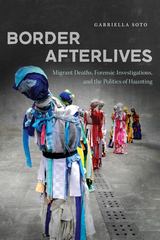 Border Afterlives: Migrant Deaths, Forensic Investigations, and the Politics of Haunting
Gabriella Soto
University of Arizona Press, 2026 Border Afterlives begins with the undocumented individuals who die crossing the U.S.-Mexico border—deaths that are both preventable and politically produced.
Drawing on over a decade of ethnographic, participatory, and community-engaged research, author Gabriella Soto examines the postmortem journeys of these migrants through the fragmented infrastructure of medicolegal death investigation in the U.S. Southwest. She reveals how the state’s deterrence-based border policies not only generate death but also fail to provide adequate care for the dead. Soto argues that these deaths should be understood as structural homicides and that the forensic neglect they face is a form of ongoing violence.
Moving between the practical and the philosophical, Soto asks what it means to care for the dead and what society owes to those who die in its name. Through the lens of haunting, she explores how the dead continue to shape the living, not as objects of horror but as moral agents whose presence demands justice. Border Afterlives offers a border-scale comparative account of forensic practices, critiques the limits of “best practices” in under-resourced systems, and calls for a reimagining of forensic humanitarianism grounded in reciprocity and dignity, beyond human rights. This is a book that insists on remembering the dead.
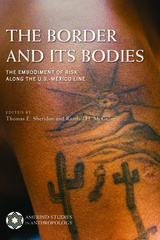 The Border and Its Bodies: The Embodiment of Risk Along the U.S.-México Line
Edited by Thomas E. Sheridan and Randall H. McGuire
University of Arizona Press, 2019 The Border and Its Bodies examines the impact of migration from Central America and México to the United States on the most basic social unit possible: the human body. It explores the terrible toll migration takes on the bodies of migrants—those who cross the border and those who die along the way—and discusses the treatment of those bodies after their remains are discovered in the desert. The increasingly militarized U.S.-México border is an intensely physical place, affecting the bodies of all who encounter it. The essays in this volume explore how crossing becomes embodied in individuals, how that embodiment transcends the crossing of the line, and how it varies depending on subject positions and identity categories, especially race, class, and citizenship. Timely and wide-ranging, this book brings into focus the traumatic and real impact the border can have on those who attempt to cross it, and it offers new perspectives on the effects for rural communities and ranchers. An intimate and profoundly human look at migration, The Border and Its Bodies reminds us of the elemental fact that the border touches us all.
Contributors
Bruce E. Anderson
Jared Beatrice
Rebecca Crocker
Jason De León
Linda Green
Randall H. McGuire
Shaylih Muehlmann
Robin Reineke
Olivia T. Ruiz Marrujo
David Seibert
Thomas E. Sheridan
Angela Soler
Ruth M. Van Dyke
Border as Method, or, the Multiplication of Labor
Sandro Mezzadra and Brett Neilson
Duke University Press, 2013 Far from creating a borderless world, contemporary globalization has generated a proliferation of borders. In Border as Method, Sandro Mezzadra and Brett Neilson chart this proliferation, investigating its implications for migratory movements, capitalist transformations, and political life. They explore the atmospheric violence that surrounds borderlands and border struggles across various geographical scales, illustrating their theoretical arguments with illuminating case studies drawn from Europe, Asia, the Pacific, the Americas, and elsewhere. Mezzadra and Neilson approach the border not only as a research object but also as an epistemic framework. Their use of the border as method enables new perspectives on the crisis and transformations of the nation-state, as well as powerful reassessments of political concepts such as citizenship and sovereignty.
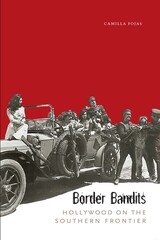 Border Bandits: Hollywood on the Southern Frontier
By Camilla Fojas
University of Texas Press, 2008 The southern frontier is one of the most emotionally charged zones in the United States, second only to its historical predecessor and partner, the western frontier. Though they span many genres, border films share common themes, trace the mood swings of public policy, and shape our cultural agenda. In this examination, Camilla Fojas studies how major Hollywood films exploit the border between Mexico and the United States to tell a story about U.S. dominance in the American hemisphere. She charts the shift from the mythos of the open western frontier to that of the embattled southern frontier by offering in-depth analyses of particular border films, from post-World War II Westerns to drug-trafficking films to contemporary Latino/a cinema, within their historical and political contexts. Fojas argues that Hollywood border films do important social work by offering a cinematic space through which viewers can manage traumatic and undesirable histories and ultimately reaffirm core "American" values. At the same time, these border narratives delineate opposing values and ideas. Latino border films offer a critical vantage onto these topics; they challenge the presumptions of U.S. nationalism and subsequent cultural attitudes about immigrants and immigration, and often critically reconstruct their Hollywood kin. By analyzing films such as Duel in the Sun, The Wild Bunch, El Norte, The Border, Traffic, and Brokeback Mountain, Fojas demands that we reexamine the powerful mythology of the Hollywood borderlands. This detailed scrutiny recognizes that these films are part of a national narrative comprised of many texts and symbols that create the myth of the United States as capital of the Americas.
Border Beagles: A Tale of Mississippi
William Gilmore Simms
University of Arkansas Press, 1996 With its rich variety of major and minor characters, speaking the language and reflecting the mores of the frontier, Border Beagles emerged upon the American literary scene in 1840 with a freshness and a vitality that mark the best of the realistic and humorous Southern tradition.
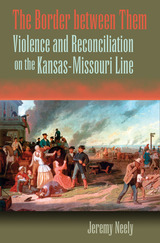 The Border between Them: Violence and Reconciliation on the Kansas-Missouri Line
Jeremy Neely
University of Missouri Press, 2007 The most bitter guerrilla conflict in American history raged along the Kansas-Missouri border from 1856 to 1865, making that frontier the first battleground in the struggle over slavery. That fiercely contested boundary represented the most explosive political fault line in the United States, and its bitter divisions foreshadowed an entire nation torn asunder. Jeremy Neely now examines the significance of the border war on both sides of the Kansas-Missouri line and offers a comparative, cross-border analysis of its origins, meanings, and consequences. A narrative history of the border war and its impact on citizens of both states, The Border between Them recounts the exploits of John Brown, William Quantrill, and other notorious guerrillas, but it also uncovers the stories of everyday people who lived through that conflict. Examining the frontier period to the close of the nineteenth century, Neely frames the guerrilla conflict within the larger story of the developing West and squares that violent period with the more peaceful—though never tranquil—periods that preceded and followed it. Focusing on the countryside south of the big bend in the Missouri River, an area where there was no natural boundary separating the states, Neely examines three border counties in each state that together illustrate both sectional division and national reunion. He draws on the letters and diaries of ordinary citizens—as well as newspaper accounts, election results, and census data—to illuminate the complex strands that helped bind Kansas and Missouri together in post–Civil War America. He shows how people on both sides of the line were already linked by common racial attitudes, farming practices, and ambivalence toward railroad expansion; he then tells how emancipation, industrialization, and immigration eventually eroded wartime divisions and facilitated the reconciliation of old foes from each state. Today the “border war” survives in the form of interstate rivalries between collegiate Tigers and Jayhawks, allowing Neely to consider the limits of that reconciliation and the enduring power of identities forged in wartime. The Border between Them is a compelling account of the terrible first act of the American Civil War and its enduring legacy for the conflict’s veterans, victims, and survivors, as well as subsequent generations.
 Border Biomes: Ecological Imaginaries of Mexico's Edges
Emily Celeste Vázquez Enríquez
Vanderbilt University Press, 2025 What effect do heavily fortified national borders have on the natural environments that surround them? In Border Biomes, Emily Celeste Vázquez Enríquez explores this question by analyzing contemporary Mexican, Latinx, and Indigenous literature that has tried to highlight the human and ecological toll of Mexico’s borders with the United States and Guatemala. By challenging the very premise of borders as permanent, immovable boundaries, she shows how novelists and poets in Mexico and the United States have tried to represent and understand the vast social, political, and ecological harm caused by these constructions. She argues that the environmental destruction that borders create is inseparable from state‑sanctioned, anti‑immigrant racial violence. To do this, she structures the book around three main biomes: rivers, deserts, and forests. Within each chapter, Vázquez Enríquez considers how authors such as Dolores Dorantes, Natalie Diaz, and Ofelia Zepeda have drawn upon alternative Indigenous epistemologies and forms of representation to register the sweeping damage of bordering regimes on the Colorado River, the Southwest Desert, and the Selva El Petén, and other biomes. By critically analyzing the work of these US and Mexican writers, she contests traditional interpretations of Mexican literature as nationally bounded and instead proposes an expansive view of “Mexican literature.” More fundamentally, Border Biomes suggests literature's potential to create new ecological realities and challenge the naturalization of borders and the ecological violence that they provoke.
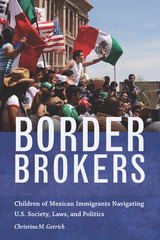 Border Brokers: Children of Mexican Immigrants Navigating U.S. Society, Laws, and Politics
Christina M. Getrich
University of Arizona Press, 2019 Some 16.6 million people nationwide live in mixed-status families, containing a combination of U.S. citizens, residents, and undocumented immigrants. U.S. immigration governance has become an almost daily news headline. Yet even in the absence of federal immigration reform over the last twenty years, existing policies and practices have already been profoundly impacting these family units.
Based on ethnographic fieldwork in San Diego over more than a decade, Border Brokers documents the continuing deleterious effects of U.S. immigration policies and enforcement practices on a group of now young adults and their families. In the first book-length longitudinal study of mixed-status families, Christina M. Getrich provides an on-the-ground portrayal of these young adults’ lives from their own perspectives and in their own words.
More importantly, Getrich identifies how these individuals have developed resiliency and agency beginning in their teens to improve circumstances for immigrant communities. Despite the significant constraints their families face, these children have emerged into adulthood as grounded and skilled brokers who effectively use their local knowledge bases, life skills honed in their families, and transborder competencies. Refuting the notion of their failure to assimilate, she highlights the mature, engaged citizenship they model as they transition to adulthood to be perhaps their most enduring contribution to creating a better U.S. society.
An accessible ethnography rooted in the everyday, this book portrays the complexity of life in the U.S.-Mexico borderlands. It offers important insights for anthropologists, educators, policy-makers, and activists working on immigration and social justice issues.
Border Cinema: Reimagining Identity through Aesthetics
Edited by Monica Hanna and Rebecca A. Sheehan
Rutgers University Press, 2019 The rise of digital media and globalization’s intensification since the 1990s have significantly refigured global cinema’s form and content. The coincidence of digitalization and globalization has produced what this book helps to define and describe as a flourishing border cinema whose aesthetics reflect, construct, intervene in, denature, and reconfigure geopolitical borders. This collection demonstrates how border cinema resists contemporary border fortification processes, showing how cinematic media have functioned technologically and aesthetically to engender contemporary shifts in national and individual identities while proposing alternative conceptions of these identities to those promulgated by the often restrictive current political rhetoric and ideologies that represent a backlash to globalization.
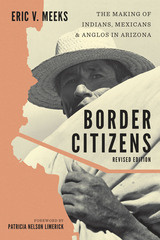 Border Citizens: The Making of Indians, Mexicans, and Anglos in Arizona
By Eric V. Meeks; foreword by Patricia Nelson Limerick
University of Texas Press, 2007 In Border Citizens, historian Eric V. Meeks explores how the racial classification and identities of the diverse indigenous, mestizo, and Euro-American residents of Arizona’s borderlands evolved as the region was politically and economically incorporated into the United States. First published in 2007, the book examines the complex relationship between racial subordination and resistance over the course of a century. On the one hand, Meeks links the construction of multiple racial categories to the process of nation-state building and capitalist integration. On the other, he explores how the region’s diverse communities altered the blueprint drawn up by government officials and members of the Anglo majority for their assimilation or exclusion while redefining citizenship and national belonging. The revised edition of this highly praised and influential study features dozens of new images, an introductory essay by historian Patricia Nelson Limerick, and a chapter-length afterword by the author. In his afterword, Meeks details and contextualizes Arizona’s aggressive response to undocumented immigration and ethnic studies in the decade after Border Citizens was first published, demonstrating that the broad-based movement against these measures had ramifications well beyond Arizona. He also revisits the Yaqui and Tohono O’odham nations on both sides of the Sonora-Arizona border, focusing on their efforts to retain, extend, and enrich their connections to one another in the face of increasingly stringent border enforcement.
Border Communities at the Edge of the Roman Empire: Processes of Change in the Civitas Cananefatium
Jasper de Bruin
Amsterdam University Press, 2019 In Roman times, the area between the Lower Rhine and the Meuse in the present day province of South Holland in the Netherlands, was known as the administrative district of the community of the Cananefates (the civitas Cananefatium). The formation of this community, as well as the changes that took place within this group, were researched by means of a systematic analysis of the archaeological remains. In order to understand the role of the Roman state in these processes, the urban and military communities were also studied. In this way an overview was created of an administrative region in which aspects such as the interaction between the different groups, the character of the rural community and the differences with other rural groups along the borders of the Roman Empire could be studied.
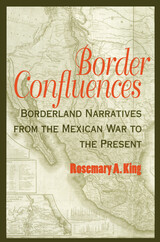 Border Confluences: Borderland Narratives from the Mexican War to the Present
Rosemary A. King
University of Arizona Press, 2004 Writers focusing on the U.S.-Mexico border are keen observers of cultural interaction, and their work offers a key to understanding the region and its most important issues. For more than 150 years, novelists from both the United States and Mexico have spun stories about the borderlands in which characters react to cultural differences in the region, and this has become a dominant theme in border fiction. Authors such as Helen Hunt Jackson, Carlos Fuentes, Cormac McCarthy, and Leslie Marmon Silko have not only created important literature; in so doing, they have also helped define the border. Writers who are drawn to the borderlands owe the narrative power of their work to compelling relationships between literary constructions of space and artistic expressions of cultural encounter. Rosemary King now offers a new way of understanding the conflicts these writers portray by analyzing their representations of geography and genre. Border Confluences examines how the theme of cultural difference influences the ways that writers construct narrative space and the ways their characters negotiate those spaces, from domestic sphere to national territory, public school to utopia. King shows how fictional characters' various responses to cultural encounters—adapting, resisting, challenging, sympathizing—depend on the artistic rendering of spaces and places around them, and she examines the connection between writers' evocation of place and the presence of cultural interaction along the border as expressed in novels written since the mid-nineteenth century. Drawing on historical romances, Hispanic coming-of-age novels, travel narratives, and utopian literature, King offers plot summaries of such key works as Ramona, All the Pretty Horses, and Almanac of the Dead as she analyzes representations of both the spaces in which characters function and the places they inhabit relative to the border. Border Confluences is a provocative study that offers insight into the ways words and space combine and recombine over time to create representations of the borderlands as a site where places and cultures continue to generate powerful narrative. Through it, scholars and students in such disciplines as ethnic studies, sociology, and women's studies will find that novels centered on the border are not merely works of literature but also keys to understanding the region and its most important issues.
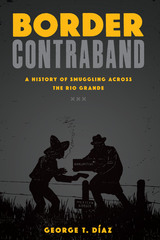 Border Contraband: A History of Smuggling across the Rio Grande
By George T. Díaz
University of Texas Press, 2015 Present-day smuggling across the U.S.-Mexico border is a professional, often violent, criminal activity. However, it is only the latest chapter in a history of illicit business dealings that stretches back to 1848, when attempts by Mexico and the United States to tax commerce across the Rio Grande upset local trade and caused popular resentment. Rather than acquiesce to what they regarded as arbitrary trade regulations, borderlanders continued to cross goods and accepted many forms of smuggling as just. In Border Contraband, George T. Díaz provides the first history of the common, yet little studied, practice of smuggling across the U.S.-Mexico border. In Part I, he examines the period between 1848 and 1910, when the United States’ and Mexico’s trade concerns focused on tariff collection and on borderlanders’ attempts to avoid paying tariffs by smuggling. Part II begins with the onset of the Mexican Revolution in 1910, when national customs and other security forces on the border shifted their emphasis to the interdiction of prohibited items (particularly guns and drugs) that threatened the state. Díaz’s pioneering research explains how greater restrictions have transformed smuggling from a low-level mundane activity, widely accepted and still routinely practiced, into a highly profitable professional criminal enterprise.
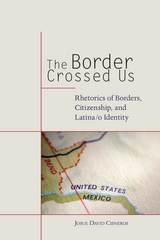 The Border Crossed Us: Rhetorics of Borders, Citizenship, and Latina/o Identity
Josue David Cisneros
University of Alabama Press, 2013 Explores efforts to restrict and expand notions of US citizenship as they relate specifically to the US-Mexico border and Latina/o identity
Borders and citizenship go hand in hand. Borders define a nation as a territorial entity and create the parameters for national belonging. But the relationship between borders and citizenship breeds perpetual anxiety over the purported sanctity of the border, the security of a nation, and the integrity of civic identity.
In The Border Crossed Us, Josue David Cisneros addresses these themes as they relate to the US-Mexico border, arguing that issues ranging from the Mexican-American War of 1846–1848 to contemporary debates about Latina/o immigration and border security are negotiated rhetorically through public discourse. He explores these rhetorical battles through case studies of specific Latina/o struggles for civil rights and citizenship, including debates about Mexican American citizenship in the 1849 California Constitutional Convention, 1960s Chicana/o civil rights movements, and modern-day immigrant activism.
Cisneros posits that borders—both geographic and civic—have crossed and recrossed Latina/o communities throughout history (the book’s title derives from the popular activist chant, “We didn’t cross the border; the border crossed us!”) and that Latina/os in the United States have long contributed to, struggled with, and sought to cross or challenge the borders of belonging, including race, culture, language, and gender.
The Border Crossed Us illuminates the enduring significance and evolution of US borders and citizenship, and provides programmatic and theoretical suggestions for the continued study of these critical issues.
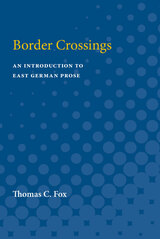 Border Crossings: An Introduction to East German Prose
Thomas C. Fox
University of Michigan Press, 1993 Border Crossings is an accessible and comprehensive overview of the work of prose fiction writers in what was the German Democratic Republic. Thomas C. Fox introduces readers to the best and most important East German writers—among them Christa Wolf, Jurek Becker, Anna Seghers, Stefan Heym, and Franz Fühmann—restricting his study to work that is available in English translation so that readers who do not know German will be able to read for themselves the literature he discusses.During a period of forty years, writers in the German Democratic Republic struggled with increasing success to free themselves from a smothering and paternalistic governmental embrace, thus anticipating, and helping to constitute, the events of 1989. In its relentless interrogation of the status quo, in its persistent ability to create alternatives, and in its call for more openness, literature in East Germany served as an outlet for energies and ideas that might have been channeled, in the West, into politics, philosophy, or journalism. In addition to discussing the role that literature played in shaping historical events, Fox shows that it can be appreciated simply as literature, outside of its political contexts.
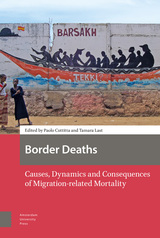 Border Deaths: Causes, Dynamics and Consequences of Migration-related Mortality
Paolo Cuttitta
Amsterdam University Press, 2020 Border deaths are a result of dynamics involving diverse actors, and can be interpreted and represented in various ways. Critical voices from civil society (including academia) hold states responsible for making safe journeys impossible for large parts of the world population. Meanwhile, policy-makers argue that border deaths demonstrate the need for restrictive border policies. Statistics are widely (mis)used to support different readings of border deaths. However, the way data is collected, analysed, and disseminated remains largely unquestioned. Similarly, little is known about how bodies are treated, and about the different ways in which the dead - also including the missing and the unidentified - are mourned by familiars and strangers. New concepts and perspectives contribute to highlighting the political nature of border deaths and finding ways to move forward. The chapters of this collection, co-authored by researchers and practitioners, provide the first interdisciplinary overview of this contested field.
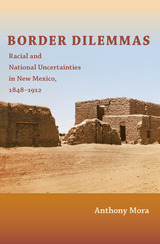 Border Dilemmas: Racial and National Uncertainties in New Mexico, 1848–1912
Anthony Mora
Duke University Press, 2011 The U.S.-Mexican War officially ended in 1848 with the signing of the Treaty of Guadalupe Hidalgo, which called for Mexico to surrender more than one-third of its land. The treaty offered Mexicans living in the conquered territory a choice between staying there or returning to Mexico by moving south of the newly drawn borderline. In this fascinating history, Anthony Mora analyzes contrasting responses to the treaty’s provisions. The town of Las Cruces was built north of the border by Mexicans who decided to take their chances in the United States. La Mesilla was established just south of the border by men and women who did not want to live in a country that had waged war against the Mexican republic; nevertheless, it was incorporated into the United States in 1854, when the border was redrawn once again. Mora traces the trajectory of each town from its founding until New Mexico became a U.S. state in 1912. La Mesilla thrived initially, but then fell into decay and was surpassed by Las Cruces as a pro-U.S. regional discourse developed. Border Dilemmas explains how two towns, less than five miles apart, were deeply divided by conflicting ideas about the relations between race and nation, and how these ideas continue to inform discussion about what it means to “be Mexican” in the United States.
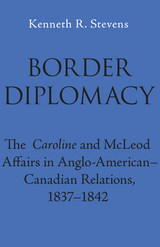 Border Diplomacy: The Caroline and McLeod Affairs in Anglo-American-Canadian Relations, 1837-1842
Kenneth R. Stevens
University of Alabama Press, 1989 How the United States began to mature and establish itself as a nation contributing to international law
Long after Americans and Britons signed treaties ending the Revolutionary War and the War of 1812, ill will between the two nations simmered under the surface of their relations and periodically boiled over. In the mid-nineteenth century, Americans, the British, and British subjects in Canada continued to dispute borders, sovereign rights and responsibilities, and the American republican experiment.
Some of the antagonism arose from a fundamental difference in attitude toward democracy. Britons believed that democratic government was inadequate to control the baser elements of a population. Further, they disliked the aggressiveness and arrogance of their former colonists. Americans sensed and resented this contempt; in turn, they regarded British aristocratic pretensions with scorn and believed that country sought world domination. In view of such attitudes, even relatively minor incidents threatened to erupt into violence between the two nations. Such was the case in 1837, when British troops set fire to the American steamer Caroline in American waters, killing a United States citizen, and in 1840, when the state of New York arrested a Canadian, Alexander McLeod, for the murder.
These events, taken together, are not simply examples of diplomatic relations or political problems for particular administrations. The dash of attitudes and loyalties along the American-Canadian frontier also demonstrates the instability of the border region, socially as well as politically, and conflicting motives of patriotism and political opportunism in both the American and British governments. Thus, the Caroline and McLeod affairs, occurring as they did at a pivotal moment in American history, reveal how the republic began to mature in its relations with its long-established forebear, refined its own definitions of state and federal powers, and established itself as a nation contributing to, as well as influenced by, international law.
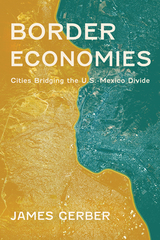 Border Economies: Cities Bridging the U.S.-Mexico Divide
James Gerber
University of Arizona Press, 2024 The border between the United States and Mexico is one of the most unique and complex regions of the world. The asymmetry of the border region, together with the profound cultural differences of the two countries, create national controversies around migration, security, and illegal flows of drugs and weapons. The national narratives miss the fact that the 15 million or more people living in the border regions of Mexico and the United States are highly interactive and responsive to conditions on the other side.
Enormous legal cross-border flows of people, goods, and finance are embedded in the region’s history and prompted by the need to respond to new opportunities and challenges that originate on the other side. In Border Economies James Gerber examines how the interactivity and sensitivity of communities to conditions across the border differentiates them from communities in the interiors of Mexico and the United States. Gerber explains what makes the region not only unique but uniquely interesting.
In Border Economies readers who want to understand the conditions that make the border controversial but also want to go beyond shallow political narratives will find an in-depth exploration of the economic forces shaping the region and an antidote to common prejudices and misunderstandings.
Border Healing Woman: The Story of Jewel Babb as told to Pat LittleDog (second edition)
By Jewel Babb as told to Pat Littledog
University of Texas Press, 1994 The story of Jewel Babb, from her early years as a tenderfoot ranch wife to her elder years as a desert healing woman, has enthralled readers since Border Healing Woman was first published in 1981. In this second edition, Pat LittleDog adds an epilogue to conclude the story, describing the mixed blessings that publicity brought to Jewel Babb before her death in 1991.
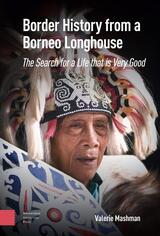 Border History from a Borneo Longhouse: The Search for a Life that is Very Good
Valerie Mashman
Amsterdam University Press, 2024 A headman of a remote Kelabit longhouse in Borneo is wrestling with recent changes caused by logging and roadbuilding. During this time of tension, he tells three historical narratives defining what makes the good life. His stories of history celebrate pioneering heroes who led through warfare and migrations, who interact with the Brooke state and initiate peace-making, and who journey to seek local Christian missionaries. This microhistory highlights the resilience of values in the face of transformative change, values providing a cultural structure for the Kelabit to redefine and adapt whilst maintaining their identity as a community.
This work is relevant to Austronesian studies, Southeast Asian history, oral history, the anthropology of value, sociality and ethnic identity, Christian conversion, and issues of borderlands, decolonization, and indigeneity. It is of interest to readers concerned with the history of transnational peoples of Borneo, including the Kelabit, Sa’ban, Kenyah, Ngurek, Penan, and the Lun Dayeh.
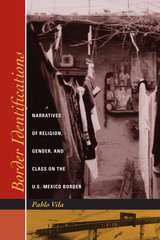 Border Identifications: Narratives of Religion, Gender, and Class on the U.S.-Mexico Border
By Pablo Vila
University of Texas Press, 2005 From poets to sociologists, many people who write about life on the U.S.-Mexico border use terms such as "border crossing" and "hybridity" which suggest that a unified culture—neither Mexican nor American, but an amalgamation of both—has arisen in the borderlands. But talking to people who actually live on either side of the border reveals no single commonly shared sense of identity, as Pablo Vila demonstrated in his book Crossing Borders, Reinforcing Borders: Social Categories, Metaphors, and Narrative Identities on the U.S.-Mexico Frontier. Instead, people living near the border, like people everywhere, base their sense of identity on a constellation of interacting factors that includes regional identity, but also nationality, ethnicity, and race. In this book, Vila continues the exploration of identities he began in Crossing Borders, Reinforcing Borders by looking at how religion, gender, and class also affect people's identifications of self and "others" among Mexican nationals, Mexican immigrants, Mexican Americans, Anglos, and African Americans in the Cuidad Juárez-El Paso area. Among the many fascinating issues he raises are how the perception that "all Mexicans are Catholic" affects Mexican Protestants and Pentecostals; how the discourse about proper gender roles may feed the violence against women that has made Juárez the "women's murder capital of the world"; and why class consciousness is paradoxically absent in a region with great disparities of wealth. His research underscores the complexity of the process of social identification and confirms that the idealized notion of "hybridity" is only partially adequate to define people's identity on the U.S.-Mexico border.
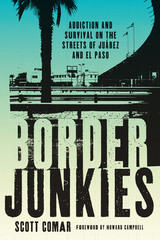 Border Junkies: Addiction and Survival on the Streets of Juárez and El Paso
By Scott Comar
University of Texas Press, 2011 The drug war that has turned Juárez, Mexico, into a killing field that has claimed more than 7,000 lives since 2008 captures headlines almost daily. But few accounts go all the way down to the streets to investigate the lives of individual drug users. One of those users, Scott Comar, survived years of heroin addiction and failed attempts at detox and finally cleaned up in 2003. Now a graduate student at the University of Texas at El Paso in the history department's borderlands doctoral program, Comar has written Border Junkies, a searingly honest account of his spiraling descent into heroin addiction, surrender, change, and recovery on the U.S.-Mexico border. Border Junkies is the first book ever written about the lifestyle of active addiction on the streets of Juárez. Comar vividly describes living between the disparate Mexican and American cultures and among the fellow junkies, drug dealers, hookers, coyote smugglers, thieves, and killers who were his friends and neighbors in addiction—and the social workers, missionaries, shelter workers, and doctors who tried to help him escape. With the perspective of his anthropological training, he shows how homelessness, poverty, and addiction all fuel the use of narcotics and the rise in their consumption on the streets of Juárez and contribute to the societal decay of this Mexican urban landscape. Comar also offers significant insights into the U.S.-Mexico borderland's underground and peripheral economy and the ways in which the region's inhabitants adapt to the local economic terrain.
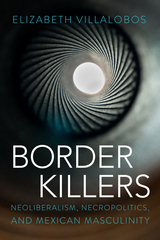 Border Killers: Neoliberalism, Necropolitics, and Mexican Masculinity
Elizabeth Villalobos
University of Arizona Press, 2024 Border Killers delves into how recent Mexican creators have reported, analyzed, distended, and refracted the increasingly violent world of neoliberal Mexico, especially its versions of masculinity. By looking to the insights of artists, writers, and filmmakers, Elizabeth Villalobos offers a path for making sense and critiquing very real border violence in contemporary Mexico.
Villalobos focuses on representations of “border killers” in literature, film, and theater. The author develops a metaphor of “maquilization” to describe the mass-production of masculine violence as a result of neoliberalism. The author demonstrates that the killer is an interchangeable cog in a societal factory of violence whose work is to produce dead bodies. By turning to cultural narratives, Villalobos seeks to counter the sensationalistic and stereotyped media depictions of border residents as criminals. The cultural works she examines instead indict the Mexican state and the global economic system for producing agents of violence.
Focusing on both Mexico’s northern and southern borders, Border Killers uses Achille Mbembe’s concept of necropolitics and various theories of masculinity to argue that contemporary Mexico is home to a form of necropolitical masculinity that has flourished in the neoliberal era and made the exercise of death both profitable and necessary for the functioning of Mexico’s state-cartel-corporate governance matrix.
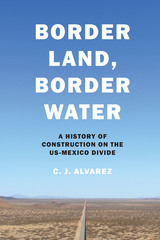 Border Land, Border Water: A History of Construction on the US-Mexico Divide
By C. J. Alvarez
University of Texas Press, 2019 Winner, Abbott Lowell Cummings Award, Vernacular Architecture Forum, 2020
Winner, Elisabeth Blair MacDougall Book Award, Society of Architectural Historians, 2021 From the boundary surveys of the 1850s to the ever-expanding fences and highway networks of the twenty-first century, Border Land, Border Water examines the history of the construction projects that have shaped the region where the United States and Mexico meet. Tracing the accretion of ports of entry, boundary markers, transportation networks, fences and barriers, surveillance infrastructure, and dams and other river engineering projects, C. J. Alvarez advances a broad chronological narrative that captures the full life cycle of border building. He explains how initial groundbreaking in the nineteenth century transitioned to unbridled faith in the capacity to control the movement of people, goods, and water through the use of physical structures. By the 1960s, however, the built environment of the border began to display increasingly obvious systemic flaws. More often than not, Alvarez shows, federal agencies in both countries responded with more construction—“compensatory building” designed to mitigate unsustainable policies relating to immigration, black markets, and the natural world. Border Land, Border Water reframes our understanding of how the border has come to look and function as it does and is essential to current debates about the future of the US-Mexico divide.
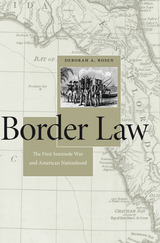 Border Law: The First Seminole War and American Nationhood
Deborah A. Rosen
Harvard University Press, 2015 The First Seminole War of 1816–1818 played a critical role in shaping how the United States demarcated its spatial and legal boundaries during the early years of the republic. Rooted in notions of American exceptionalism, manifest destiny, and racism, the legal framework that emerged from the war laid the groundwork for the Monroe Doctrine, the Dred Scott decision, and U.S. westward expansion over the course of the nineteenth century, as Deborah Rosen explains in Border Law.
When General Andrew Jackson’s troops invaded Spanish-ruled Florida in the late 1810s, they seized forts, destroyed towns, and captured or killed Spaniards, Britons, Creeks, Seminoles, and African-descended people. As Rosen shows, Americans vigorously debated these aggressive actions and raised pressing questions about the rights of wartime prisoners, the use of military tribunals, the nature of sovereignty, the rules for operating across territorial borders, the validity of preemptive strikes, and the role of race in determining legal rights. Proponents of Jackson’s Florida campaigns claimed a place for the United States as a member of the European diplomatic community while at the same time asserting a regional sphere of influence and new rules regarding the application of international law.
American justifications for the incursions, which allocated rights along racial lines and allowed broad leeway for extraterritorial action, forged a more unified national identity and set a precedent for an assertive foreign policy.
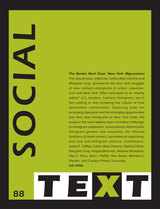 The Border Next Door: New York Migraciones, Volume 24
Carlos Ulises Decena and Margaret Gray, eds.
Duke University Press Addressing how national immigration concerns play out at urban, rural, and suburban levels in the state of New York, this special issue of Social Text offers new insight into an area of study that has long been focused primarily on cities. As new Latino/a immigrants change the culture and social fabric of small communities and reshape policy concerns, suburban and rural regions are becoming key locations for anti-immigrant acts and immigrant social justice organizing. This special issue presents immigrant stories and community and advocacy responses that underscore the need to recognize the diversity of Latino/a immigrant experiences, and it explores the widely varying responses of towns, counties, and both new and established immigrant groups to the race, ethnic, and class tensions usually associated with cities. While focusing on Central American and Mexican immigrants in New York state, the contributors to this issue—scholars, activists, artists, and filmmakers—situate their work within a national context and consider the paradox of the experience of Latino/a immigrants, who face increasing repression on the one hand and emerging opportunities on the other. Essays address the experience of transnational mothers who leave their children in the care of extended family to pursue low-wage U.S. jobs; the politics of gender and sexuality in immigrant communities; the social practices of day laborers as they wait for work on street corners; and the unlikely pairing of the Virgen de Guadalupe and New York State attorney general Eliot Spitzer as figures to whom Mexican immigrants appeal in their demands for rights and dignity. Other articles address the upsurge of immigrant mobility, anti-immigrant activities, and immigrant advocacy in non-urban locations. Contributors. James E. Claffey, Carlos Ulises Decena, Alyshia Gálvez, Margaret Gray, Angela Martínez, Melanie Nicholson, Pilar A. Parra, Max J. Pfeffer, Michele G. Shedlin, Carolyn Pinedo Turnovsky
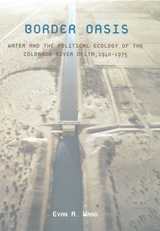 Border Oasis: Water and the Political Ecology of the Colorado River Delta, 1940–1975
Evan R. Ward
University of Arizona Press, 2003 The environmental history of the Colorado River delta during the past century is one of the most important—and most neglected—stories of the U.S.-Mexico Borderlands. Thanks to entrepreneurs such as William E. Smythe, the surrounding desert in Arizona, California, Sonora, and Baja California has been transformed into an agricultural oasis, but not without significant ecological, political, economic, and social consequences.
Evan Ward explores the rapid development of this region, examining the ways in which regional politics and international relations created a garden in the Mexicali, Yuma, and Imperial Valleys while simultaneously threatening the life of the Colorado River. Tracing the transformation of the delta by irrigated agribusiness through the twentieth century, he draws on untapped archival resources from both sides of the border to offer a new look at one of the world's most contested landscapes.
Border Oasis tells how two very different nations developed the delta into an agricultural oasis at enormous environmental cost. Focusing on the years 1940 to 1975—including the disastrous salinity crisis of the 1960s and 1970s—it combines Mexican, Native American, and U.S. perspectives to demonstrate that the political and diplomatic influences on the delta played as much a part in the region's transformation as did irrigation. Ward reveals how mistrust among political and economic participants has been fueled by conflict between national and local officials on both sides of the border, by Mexican nationalism, and by a mutual recognition that water is the critical ingredient for regional economic development.
With overemphasis on development in both nations leading to an ecological breaking point, Ward demonstrates that conflicting interests have made sound binational management of the delta nearly impossible. By weaving together all of these threads that have produced the fabric of today's lower Colorado, his study shows that the environmental history of the delta must be understood as a whole, not from the standpoint of only one of many competing interests.
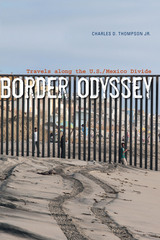 Border Odyssey: Travels along the U.S./Mexico Divide
By Charles D. Thompson, Jr.
University of Texas Press, 2015 “We were trying to change the vision and the conversation about border fears.” Border Odyssey takes us on a drive toward understanding the U.S./Mexico divide: all 1,969 miles—from Boca Chica to Tijuana—pressing on with the useful fiction of a map. “We needed to go to the place where countless innocent people had been kicked, cussed, spit on, arrested, detained, trafficked, and killed. It would become clear that the border, la frontera, was more multifaceted and profound than anything we could have invented about it from afar.” Along the journey, five centuries of cultural history (indigenous, French, Spanish, Mexican, African American, colonist, and U.S.), wars, and legislation unfold. And through observation, conversation, and meditation, Border Odyssey scopes the stories of the people and towns on both sides. “Stories are the opposite of walls: they demand release, retelling, showing, connecting, each image chipping away at boundaries. Walls are full stops. But stories are like commas, always making possible the next clause.” Among the terrain traversed: walls and more walls, unexpected roadblocks and patrol officers; a golf course (you could drive a ball across the border); a Civil War battlefield (you could camp there); the southernmost plantation in the United States; a hand-drawn ferry, a road-runner tracked desert, and a breathtaking national park; barbed wire, bridges, and a trucking-trade thoroughfare; ghosts with guns; obscured, unmarked, and unpaved roads; a Catholic priest and his dogs, artwork, icons, and political cartoons; a sheriff and a chain-smoking mayor; a Tex-Mex eatery empty of customers and a B&B shuttering its doors; murder-laden newspaper headlines at breakfast; the kindness of the border-crossing underground; and too many elderly, impoverished, ex-U.S. farmworkers, braceros, lined up to have Thompson take their photograph.
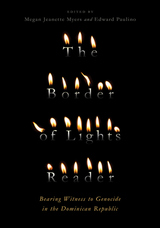 The Border of Lights Reader: Bearing Witness to Genocide in the Dominican Republic
Megan Jeanette Myers
Amherst College Press, 2021 Border of Lights, a volunteer collective, returns each October to Dominican-Haitian border towns to bear witness to the 1937 Haitian Massacre ordered by Dominican dictator Rafael Leónidas Trujillo. This crime against humanity has never been acknowledged by the Dominican government and no memorial exists for its victims. A multimodal, multi-vocal space for activists, artists, scholars, and others connected to the BOL movement, The Border of Lights Reader provides an alternative to the dominant narrative that positions Dominicans and Haitians as eternal adversaries and ignores cross-border and collaborative histories. This innovative anthology asks large-scale, universal questions regarding historical memory and revisionism that countries around the world grapple with today.
"By bringing together in one volume poetry, visual arts, literary analysis, in-depth interviews and historical analysis this volume will provide its readers with a comprehensive view of the causes and the aftermath of the massacre." —Ramón Antonio Victoriano-Martínez, University of British Columbia
Contributions by Julia Alvarez, Amanda Alcántara, DeAndra Beard, Nancy Betances, Jésula Blanc, Matías Bosch Carcuro, Cynthia Carrión, Raj Chetty, Catherine DeLaura, Magaly Colimon, Juan Colón, Robin Maria DeLugan, Lauren Derby, Rosa Iris Diendomi Álvarez, Polibio Díaz, Rana Dotson, Rita Dove, Rhina P. Espaillat, Maria Cristina Fumagalli, Saudi García, Scherezade García, Juan Carlos González Díaz, Kiran C. Jayaram, Pierre Michel Jean, Nehanda Loiseau Julot, Jake Kheel, Carlos Alomia Kollegger, Jackson Lorrain “Jhonny Rivas”, Radio Marién, Padre Regino Martínez Bretón, Sophie Maríñez, April J. Mayes, Jasminne Mendez, Komedi Mikal PGNE, Osiris Mosquea, Megan Jeanette Myers, Rebecca Osborne, Ana Ozuna, Edward Paulino, John Presimé, Laura Ramos, Amaury Rodríguez, Doña Carmen Rodríguez de Paulino, The DREAM Project, Silvio Torres-Saillant, Ilses Toribio, Deisy Toussaint, Évelyne Trouillot, Richard Turits, William Vazquez, Chiqui Vicioso, Bridget Wooding, and Óscar Zazo.
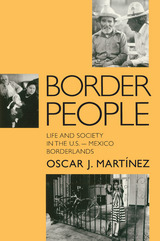 Border People: Life and Society in the U.S.-Mexico Borderlands
Oscar J. Martínez
University of Arizona Press, 1994 While the U.S.-Mexico borderlands resemble border regions in other parts of the world, nowhere else do so many millions of people from two dissimilar nations live in such close proximity and interact with each other so intensely. Borderlanders are singular in their history, outlook, and behavior, and their lifestyle deviates from the norms of central Mexico and the interior United States; yet these Mexicans, Mexican-Americans, and Anglo-Americans also differ among themselves, and within each group may be found cross-border consumers, commuters, and people who are inclined or disinclined to embrace both cultures. Based on firsthand interviews with individuals from all walks of life, Border People presents case histories of transnational interaction and transculturation, and addresses the themes of cross-border migration, interdependence, labor, border management, ethnic confrontation, cultural fusion, and social activism. Here migrants and workers, functionaries and activists, and "mixers" who have crossed cultural boundaries recall events in their lives related to life on the border. Their stories show how their lives have been shaped by the borderlands milieu and how they have responded to the situations they have faced. Border People shows that these borderlanders live in a unique human environment shaped by physical distance from central areas and constant exposure to transnational processes. The oral histories contained here reveal, to a degree that no scholarly analysis can, that borderlanders are indeed people, each with his or her own individual perspective, hopes, and dreams.
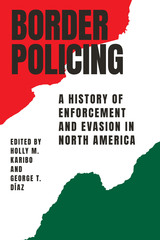 Border Policing: A History of Enforcement and Evasion in North America
Edited by Holly M. Karibo and George T. Díaz
University of Texas Press, 2020 An interdisciplinary group of borderlands scholars provide the first expansive comparative history of the way North American borders have been policed—and transgressed—over the past two centuries.
An extensive history examining how North American nations have tried (and often failed) to police their borders, Border Policing presents diverse scholarly perspectives on attempts to regulate people and goods at borders, as well as on the ways that individuals and communities have navigated, contested, and evaded such regulation. The contributors explore these power dynamics though a series of case studies on subjects ranging from competing allegiances at the northeastern border during the War of 1812 to struggles over Indian sovereignty and from the effects of the Mexican Revolution to the experiences of smugglers along the Rio Grande during Prohibition. Later chapters stretch into the twenty-first century and consider immigration enforcement, drug trafficking, and representations of border policing in reality television. Together, the contributors explore the powerful ways in which federal authorities impose political agendas on borderlands and how local border residents and regions interact with, and push back against, such agendas. With its rich mix of political, legal, social, and cultural history, this collection provides new insights into the distinct realities that have shaped the international borders of North America.
 Border Radio: Quacks, Yodelers, Pitchmen, Psychics, and Other Amazing Broadcasters of the American Airwaves, Revised Edition
By Gene Fowler and Bill Crawford
University of Texas Press, 2002 Before the Internet brought the world together, there was border radio. These mega-watt "border blaster" stations, set up just across the Mexican border to evade U.S. regulations, beamed programming across the United States and as far away as South America, Japan, and Western Europe. This book traces the eventful history of border radio from its founding in the 1930s by "goat-gland doctor" J. R. Brinkley to the glory days of Wolfman Jack in the 1960s. Along the way, it shows how border broadcasters pioneered direct sales advertising, helped prove the power of electronic media as a political tool, aided in spreading the popularity of country music, rhythm and blues, and rock, and laid the foundations for today's electronic church. The authors have revised the text to include even more first-hand information and a larger selection of photographs.
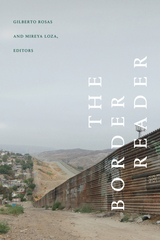 The Border Reader
Gilberto Rosas and Mireya Loza, editors
Duke University Press, 2023 The Border Reader brings together canonical and cutting-edge humanities and social science scholarship on the US-Mexico border region. Spotlighting the vibrancy of border studies from the field’s emergence to its enduring significance, the essays mobilize feminist, queer, and critical ethnic studies perspectives to theorize the border as a site of epistemic rupture and knowledge production. The chapters speak to how borders exist as regions where people and nation-states negotiate power, citizenship, and questions of empire. Among other topics, these essays examine the lived experiences of the diverse undocumented people who move through and live in the border region; trace the gendered and sexualized experiences of the border; show how the US-Mexico border has become a site of illegality where immigrant bodies become racialized and excluded; and imagine anti- and post-border futures. Foregrounding the interplay of scholarly inquiry and political urgency stemming from the borderlands, The Border Reader presents a unique cross section of critical interventions on the region.
Contributors. Leisy J. Abrego, Gloria E. Anzaldúa, Martha Balaguera, Lionel Cantú, Leo R. Chavez, Raúl Fernández, Rosa-Linda Fregoso, Roberto G. Gonzales, Gilbert G. González, Ramón Gutiérrez, Kelly Lytle Hernández, José E. Limón, Mireya Loza, Alejandro Lugo, Eithne Luibhéid, Martha Menchaca, Cecilia Menjívar, Natalia Molina, Fiamma Montezemolo, Américo Paredes, Néstor Rodríguez, Renato Rosaldo, Gilberto Rosas, María Josefina Saldaña-Portillo, Sonia Saldívar-Hull, Alicia Schmidt Camacho, Sayak Valencia Triana, Carlos G. Vélez-Ibáñez, Patricia Zavella
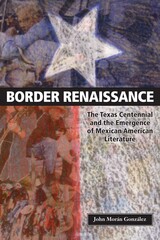 Border Renaissance: The Texas Centennial and the Emergence of Mexican American Literature
By John Morán González
University of Texas Press, 2009 The Texas Centennial of 1936, commemorated by statewide celebrations of independence from Mexico, proved to be a powerful catalyst for the formation of a distinctly Mexican American identity. Confronted by a media frenzy that vilified "Meskins" as the antithesis of Texan liberty, Mexican Americans created literary responses that critiqued these racialized representations while forging a new bilingual, bicultural community within the United States. The development of a modern Tejana identity, controversies surrounding bicultural nationalism, and other conflictual aspects of the transformation from mexicano to Mexican American are explored in this study. Capturing this fascinating aesthetic and political rebirth, Border Renaissance presents innovative readings of important novels by María Elena Zamora O'Shea, Américo Paredes, and Jovita González. In addition, the previously overlooked literary texts by members of the League of United Latin American Citizens (LULAC) are given their first detailed consideration in this compelling work of intellectual and literary history. Drawing on extensive archival research in the English and Spanish languages, John Morán González revisits the 1930s as a crucial decade for the vibrant Mexican American reclamation of Texas history. Border Renaissance pays tribute to this vital turning point in the Mexican American struggle for civil rights.
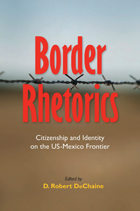 Border Rhetorics: Citizenship and Identity on the US-Mexico Frontier
Edited by D. Robert DeChaine
University of Alabama Press, 2012 Undertakes a wide-ranging examination of the US-Mexico border as it functions in the rhetorical production of civic unity in the United States A “border” is a powerful and versatile concept, variously invoked as the delineation of geographical territories, as a judicial marker of citizenship, and as an ideological trope for defining inclusion and exclusion. It has implications for both the empowerment and subjugation of any given populace. Both real and imagined, the border separates a zone of physical and symbolic exchange whose geographical, political, economic, and cultural interactions bear profoundly on popular understandings and experiences of citizenship and identity. The border’s rhetorical significance is nowhere more apparent, nor its effects more concentrated, than on the frontier between the United States and Mexico. Often understood as an unruly boundary in dire need of containment from the ravages of criminals, illegal aliens, and other undesirable threats to the national body, this geopolitical locus exemplifies how normative constructions of “proper”; border relations reinforce definitions of US citizenship, which in turn can lead to anxiety, unrest, and violence centered around the struggle to define what it means to be a member of a national political community.
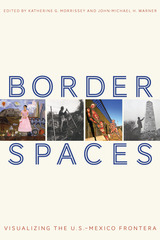 Border Spaces: Visualizing the U.S.-Mexico Frontera
Edited by Katherine G. Morrissey and John-Michael H. Warner
University of Arizona Press, 2018 The built environment along the U.S.-Mexico border has long been a hotbed of political and creative action. In this volume, the historically tense region and visually provocative margin—the southwestern United States and northern Mexico—take center stage. From the borderlands perspective, the symbolic importance and visual impact of border spaces resonate deeply.
In Border Spaces, Katherine G. Morrissey, John-Michael H. Warner, and other essayists build on the insights of border dwellers, or fronterizos, and draw on two interrelated fields—border art history and border studies. The editors engage in a conversation on the physical landscape of the border and its representations through time, art, and architecture.
The volume is divided into two linked sections—one on border histories of built environments and the second on border art histories. Each section begins with a “conversation” essay—co-authored by two leading interdisciplinary scholars in the relevant fields—that weaves together the book’s thematic questions with the ideas and essays to follow.
Border Spaces is prompted by art and grounded in an academy ready to consider the connections between art, land, and people in a binational region.
Contributors
Maribel Alvarez
Geraldo Luján Cadava
Amelia Malagamba-Ansótegui
Mary E. Mendoza
Sarah J. Moore
Katherine G. Morrissey
Margaret Regan
Rebecca M. Schreiber
Ila N. Sheren
Samuel Truett
John-Michael H. Warner
Border State
Tonu Onnepalu
Northwestern University Press, 2000 Winner of the 1993 Baltic Assembly Prize
An immediate sensation upon its 1993 publication in Europe, already translated into more than a dozen languages, Border State is a brilliantly realized account of a man in the grip of Western excess, emotionally crippled by a world that is subsuming his own and inhabiting a West in which "all countries have become imaginary deserts of ruins where crowds of nomads roam from one attraction to the other." His tale, in which disillusion and murder become inextricably linked, is a compelling exploration of scarcity, longing, and madness.
 Border Thinking: Latinx Youth Decolonizing Citizenship
Andrea Dyrness
University of Minnesota Press, 2020 Rich accounts of how Latinx migrant youth experience belonging across borders As anti-immigrant nationalist discourses escalate globally, Border Thinking offers critical insights into how young people in the Latinx diaspora experience belonging, make sense of racism, and long for change. Every year thousands of youth leave Latin America for the United States and Europe, and often the young migrants are portrayed as invaders and, if able to stay, told to integrate into their new society. Border Thinking asks not how to help the diaspora youth assimilate but what the United States and Europe can learn about citizenship from these diasporic youth. Working in the United States, Spain, and El Salvador, Andrea Dyrness and Enrique Sepúlveda III use participatory action research to collaborate with these young people to analyze how they make sense of their experiences in the borderlands. Dyrness and Sepúlveda engage them in reflecting on their feelings of belonging in multiple places—including some places that treat them as outsiders and criminals. Because of their transnational existence and connections to both home and host countries, diaspora youth have a critical perspective on national citizenship and yearn for new forms of belonging not restricted to national borders. The authors demonstrate how acompañamiento—spaces for solidarity and community-building among migrants—allow youth to critically reflect on their experiences and create support among one another. Even as national borders grow more restricted and the subject of immigration becomes ever more politically fraught, young people’s identities are increasingly diasporic. As the so-called migrant crisis continues, change in how citizenship and belonging are constructed is necessary, and urgent, to create inclusive and sustainable futures. In Border Thinking, Dyrness and Sepúlveda decouple citizenship from the nation-state, calling for new understandings of civic engagement and belonging.
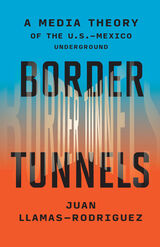 Border Tunnels: A Media Theory of the U.S.-Mexico Underground
Juan Llamas-Rodriguez
University of Minnesota Press, 2023 A comparative media analysis of the representation of the U.S.–Mexico border Border tunnels at the U.S.–Mexico border are ubiquitous in news, movies, and television, yet, because they remain hidden and inaccessible, the public can encounter them only through media. Analyzing the technologies, institutional politics, narrative tropes, and aesthetic decisions that go into showing border tunnels across multiple forms of media, Juan Llamas-Rodriguez argues that we cannot properly address border issues without attending to—and fully understanding—the fraught relationship between their representation and reality. Llamas-Rodriguez reveals that every media text about border tunnels, whether meant for entertainment, cable news, video games, or speculative design, implicitly takes a position on the politics of the border. The examples laid out in Border Tunnels will teach readers how to look differently at the border as it is commonly presented in various forms of media, from ABC’s Nightline and CNN’s Anderson Cooper 360º to reality TV, propaganda videos, and even digital effects in Hollywood action films. Llamas-Rodriguez examines how creative decisions in the production, promotion, and distribution of these media texts either emphasize or downplay issues such as border security, racial dynamics of migration, and sustainability of the borderlands. Focusing on tunnels to show how media representations can influence all kinds of audiences—even those physically near the border—Border Tunnels helps us make sense of this pressing social issue, ultimately advancing understanding of the U.S.–Mexico border in all of its complexity and precariousness.
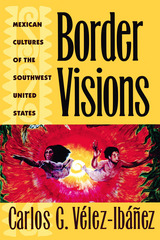 Border Visions: Mexican Cultures of the Southwest United States
Carlos G. Vélez-Ibáñez
University of Arizona Press, 1996 The U.S.-Mexico border region is home to anthropologist Carlos Vélez-Ibáñez. Into these pages he pours nearly half a century of searching and finding answers to the Mexican experience in the southwestern United States. He describes and analyzes the process, as generation upon generation of Mexicans moved north and attempted to create an identity or sense of cultural space and place. In today’s border fences he also sees barriers to how Mexicans understand themselves and how they are fundamentally understood. From prehistory to the present, Vélez-Ibáñez traces the intense bumping among Native Americans, Spaniards, and Mexicans, as Mesoamerican populations and ideas moved northward. He demonstrates how cultural glue is constantly replenished by strengthening family ties that reach across both sides of the border. The author describes ways in which Mexicans have resisted and accommodated the dominant culture by creating communities and by forming labor unions, voluntary associations, and cultural movements. He analyzes the distribution of sadness, or overrepresentation of Mexicans in poverty, crime, illness, and war, and shows how that sadness is balanced by creative expressions of literature and art, especially mural art, in the ongoing search for space and place. Here is a book for the nineties and beyond, a book that relates to NAFTA, to complex questions of immigration, and to the expanding population of Mexicans in the U.S.-Mexico border region and other parts of the country. An important new volume for social science, humanities, and Latin American scholars, Border Visions will also attract general readers for its robust narrative and autobiographical edge. For all readers, the book points to new ways of seeing borders, whether they are visible walls of brick and stone or less visible, infinitely more powerful barriers of the mind.
 Border Watch: Cultures of Immigration, Detention and Control
Alexandra Hall
Pluto Press, 2012 Questions over immigration and asylum face almost all Western countries. Should only economically useful immigrants be allowed? What should be done with unwanted or 'illegal' immigrants? In this bold and original intervention, Alexandra Hall shows that immigration detention centres offer a window onto society's broader attitudes towards immigrants.
Despite periodic media scandals, remarkably little has been written about the everyday workings of the grassroots immigration system, or about the people charged with enacting immigration policy at local levels. Detention, particularly, is a hidden side of border politics, despite its growing international importance as a tool of control and security. This book fills the gap admirably, analysing the everyday encounters between officers and immigrants in detention to explore broad social trends and theoretical concerns.
This highly topical book provides rare insights into the treatment of the 'other' and will be essential for policy makers and students studying anthropology and sociology.
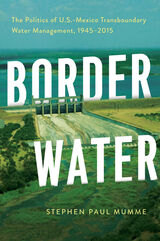 Border Water: The Politics of U.S.-Mexico Transboundary Water Management, 1945–2015
Stephen Paul Mumme
University of Arizona Press, 2023 The international boundary between the United States and Mexico spans more than 1,900 miles. Along much of this international border, water is what separates one country from the other. Border Water provides a historical account of the development of governance related to transboundary and border water resources between the United States and Mexico in the last seventy years. This work examines the phases and pivot points in the development of U.S.-Mexico border water resources and reviews the theoretical approaches and explanation that impart a better understanding of these events. Author Stephen Paul Mumme, a leading expert in water policy and border studies, describes three important periods in the chronology of transboundary water management. First, Mumme examines the 1944 Water Treaty, the establishment of the International Boundary and Water Commission (IBWC) in 1945, and early transborder politics between the two governments. Next, he describes the early 1970s and the rise of environmentalism. In this period, pollution and salinization of the Colorado River Delta come into focus. Mumme shows how new actors, now including environmentalists and municipalities, broadened and strengthened the treaty’s applications in transboundary water management. The third period of transborder interaction described covers the opening and restricting of borders due to NAFTA and then 9/11. Border Water places transboundary water management in the frame of the larger binational relationship, offering a comprehensive history of transnational water management between the United States and Mexico. As we move into the next century of transnational water management, this important work offers critical insights into lessons learned and charts a path for the future.
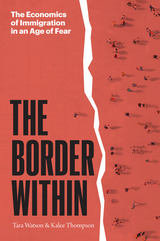 The Border Within: The Economics of Immigration in an Age of Fear
Tara Watson and Kalee Thompson
University of Chicago Press, 2021 An eye-opening analysis of the costs and effects of immigration and immigration policy, both on American life and on new Americans.
For decades, immigration has been one of the most divisive, contentious topics in American politics. And for decades, urgent calls for its policy reform have gone mostly unanswered. As the discord surrounding the modern immigration debate has intensified, border enforcement has tightened. Crossing harsher, less porous borders makes unauthorized entry to the United States a permanent, costly undertaking. And the challenges don’t end on the other side.
At once enlightening and devastating, The Border Within examines the costs and ends of America’s interior enforcement—the policies and agencies, including ICE, aimed at removing immigrants already living in the country. Economist Tara Watson and journalist Kalee Thompson pair rigorous analysis with deeply personal stories from immigrants and their families to assess immigration’s effects on every aspect of American life, from the labor force to social welfare programs to tax revenue. What emerges is a critical, utterly complete examination of what non-native Americans bring to the country, including immigration’s tendency to elevate the wages and skills of those who are native-born.
News coverage has prompted many to question the humanity of American immigration policies; The Border Within opens a conversation of whether it is effective. The United States spends billions each year on detention and deportation, all without economic gain and at a great human cost. With depth and discipline, the authors dissect the shock-and-awe policies that make up a broken, often cruel system, while illuminating the lives caught in the chaos. It is an essential work with far-reaching implications for immigrants and non-immigrants alike.
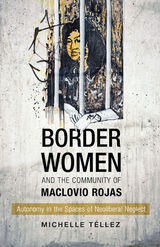 Border Women and the Community of Maclovio Rojas: Autonomy in the Spaces of Neoliberal Neglect
Michelle Téllez
University of Arizona Press, 2021 Near Tijuana, Baja California, the autonomous community of Maclovio Rojas demonstrates what is possible for urban place-based political movements. More than a community, Maclovio Rojas is a women-led social movement that works for economic and political autonomy to address issues of health, education, housing, nutrition, and security.
Border Women and the Community of Maclovio Rojas tells the story of the community’s struggle to carve out space for survival and thriving in the shadows of the U.S.-Mexico geopolitical border. This ethnography by Michelle Téllez demonstrates the state’s neglect in providing social services and local infrastructure. This neglect exacerbates the structural violence endemic to the border region—a continuation of colonial systems of power on the urban, rural, and racialized poor. Téllez shows that in creating the community of Maclovio Rojas, residents have challenged prescriptive notions of nation and belonging. Through women’s active participation and leadership, a women’s political subjectivity has emerged—Maclovianas. These border women both contest and invoke their citizenship as they struggle to have their land rights recognized, and they transform traditional political roles into that of agency and responsibility.
This book highlights the U.S.-Mexico borderlands as a space of resistance, conviviality, agency, and creative community building where transformative politics can take place. It shows hope, struggle, and possibility in the context of gendered violences of racial capitalism on the Mexican side of the U.S.-Mexico border.
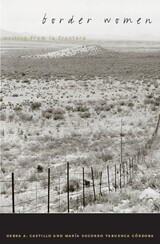 Border Women: Writing From La Frontera
Debra A. Castillo
University of Minnesota Press, 2002 The first study to foreground writing by women who live at the U.S.-Mexico Border. It is a peculiar fact that U.S.-Mexico border theory is dominated by those who write about, not from, the border. By looking at the work of women writers from both sides of the border, Debra A. Castillo and María-Socorro Tabuenca Córdoba open border studies to a truly transnational analysis while bringing questions of gender to the fore. Border Women rethinks border theory by emphasizing women writers whose work—in Spanish, English, or a mixture of the two languages—calls into question accepted notions of border identities. These writers include those who are already well recognized internationally (Helena María Viramontes, Sheila and Sandra Ortiz Taylor, and María Novaro); those who have become part of the Chicano canon (Norma Cantú, Alicia Gaspar de Alba, and Demetria Martínez); along with some of the lesser-known, yet most exciting, women’s voices from the Mexican border (Rosario Sanmiguel, Rosina Conde, and Regina Swain).
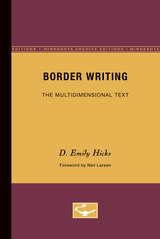 Border Writing: The Multidimensional Text
D. Emily HicksForeword by Neil Larsen
University of Minnesota Press, 1991 Border Writing was first published in 1991. Minnesota Archive Editions uses digital technology to make long-unavailable books once again accessible, and are published unaltered from the original University of Minnesota Press editions. Until recently, literary theory has been grounded in the histories of English, French, German, and Spanish literature. The terms and models for the production of literature and its function in culture and society were decided in Western Europe, and any deviations were immediately marginalized. This Eurocentric view has been widely attached by postmodern, feminist, and postcolonial political practices. Drawing on a variety of critical and theoretical sources, D. Emily Hicks employs the concept of border writing to consider the complexities of contemporary Latin American writing. With its emphasis on the multiplicity of languages and the problems of translation, border writing connotes a perspective that is no longer determined by neat distinctions. Hicks combines Deleuze and Guattari's notion of "deterritorialization" (the geographic, linguistic, or cultural displacement from one's own country, language, or native culture) with a holographic metaphor in provocative readings of Latin America writers, including Gabriel Garcia Marquez, Luisa Valenzuela, and Julio Cortazar. The result is a volume that forces the reader to consider the development of literature in terms of strategies and tactics that contribute to the production of meaning in culturally complex and politically repressive societies. D. Emily Hicks is associate professor of English and comparative literature and a member of the Latin American studies faculty at San Diego State University. Neil Larsen is associate professor of Spanish and Latin American literature at Northeastern University and the author of Modernism and Hegemony: A Materialist Critique of Aesthetic Agencies (Minnesota, 1990).
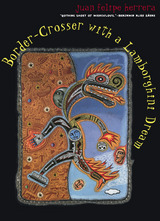 Border-Crosser with a Lamborghini Dream
Juan Felipe Herrera
University of Arizona Press, 1999 From one of the prominent Chicano poets writing today comes a collection of poems to take your breath away. With dazzling speed and energy, Juan Felipe Herrera sends readers rocketing through verbal space in a celebration of the rhythms and textures of words that will make you want to shout, dance, and read out loud. Like a wild ride in a fast car, Border-Crosser with a Lamborghini Dream moves at breakneck speed, a post-Lorca journey across the new millennium terrain. Words careen through space and time, through blighted urban landscapes, past banjos and bees, past AIDS faces and mad friars, past severed heads and steel-toed border-crosser boots.
To the rhythm of “The Blue Eyed Mambo that Unveils My Lover’s Belly”and the sounds of the Last Mayan Acid rock band, Herrera races through the hallucinations of a nation that remains just outside of paradise. With dazzling poems that roar from the darkest corners of our minds toward an ecstatic celebration of the lushness of language, Border-Crosser with a Lamborghini Dream is a celebration of a world that is both sacred and cruel, a world of “Poesy Chicano style undone wild” by one of the most daring poets of our time.
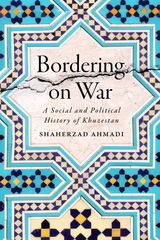 Bordering on War: A Social and Political History of Khuzestan
Shaherzad Ahmadi
University of Texas Press, 2024 A study of transnational identity, migration, and state loyalties told through the social and political history of Iran’s Khuzestan province. In 1980, Saddam Hussein’s Ba‘athist forces invaded Khuzestan, one of the oldest and richest provinces in Iran, triggering the Iran-Iraq War. Shaherzad Ahmadi’s Bordering on War examines the social history of Khuzestan and sheds light on how border dwellers, provincial leaders, and migrants in the region shaped Iran and Iraq's history before, during, and after the war. Drawing from a rich collection of Persian- and Arabic-language archival sources—rarely used by western scholars due to restrictions in Iran—Ahmadi’s research focuses on Arab Iranians and argues that Iranian border dwellers and migrants formed local, non-national loyalties, thereby eschewing bureaucratic pressures to confine loyalties to a single nation-state. The transnational character and ethnically diverse composition of Khuzestan, especially in the oil-rich towns on the southwestern border, led many, including Iraq’s Ba‘ath Party, to question the national belonging of Arab Iranians. Bordering on War contributes to a wider discussion about the ability of individuals and communities to exert agency through migration, trade, education, and other activities.
Bordering Tibetan Languages: Making and Marking Languages in Transnational High Asia
Gerald Roche
Amsterdam University Press, 2022 Bordering Tibetan Languages: Making and Marking Languages in Transnational High Asia examines the complex interactions between state, ethnic, and linguistic borders in the Himalayas. These case studies from Bhutan, China, India, and Nepal show how people in the Himalayas talk borders into existence, and also how those borders speak to them and their identities. These ‘talking borders’ exist in a world where state borders are contested, and which is being irrevocably transformed by rapid social and economic change. This book offers a new perspective on this dynamic region by centring language, and in doing so, also offers new ways of thinking about how borders and language influence each other.
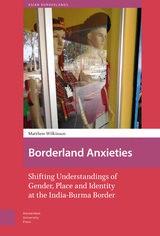 Borderland Anxieties: Shifting Understandings of Gender, Place and Identity at the India-Burma Border
Matthew Wilkinson
Amsterdam University Press, 2023 Borderland Anxieties explores the complex relationships between liberalization, gender and migration in Nagaland, a state in Northeast India that is emerging from decades of armed conflict. In the wake of Nagaland’s conflict, liberalization and an ‘opening up’ of the state to new connections and flows take place alongside ongoing militarization, nationalist insurgency, and political unrest. Nagaland’s complex peace-conflict continuum has encouraged a reordering of possibilities for men and for women in the state, but also, attempts to maintain fundamental social roles that are seen as defining an ethnic group, as foundations of identity, and for many as uncompromisable. In exploring the complex dynamics of peace, conflict, and tension in Nagaland, Borderland Anxieties offers a window to understanding how gender, politics and anxiety intersect in a borderland state experiencing rapid social, political, and economic changes.
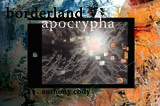 Borderland Apocrypha
Anthony Cody
Omnidawn, 2019 The 1848 Treaty of Guadalupe Hidalgo marked an end to the Mexican—American War, but it sparked a series of lynchings of Mexicans and subsequent erasures, and long-lasting traumas. This pattern of state-sanctioned violence committed towards communities of color continues to the present day. Borderland Apocrypha centers around the collective histories of these terrors, excavating the traumas born of turbulence at borderlands. In this debut collection, Anthony Cody responds to the destabilized, hostile landscapes and silenced histories of borderlands. His experimental poetic reinvents itself and shapeshifts in both form and space across the margin, the page, and the book in forms of resistance, signaling a reclamation and a re-occupation of what has been omitted. The poems ask the reader to engage in searching through the nested and cascading series of poems centered around familial and communal histories, structural racism, and natural ecosystems of borderlands. Relentless in its explorations, this collection shows how the past continues to inform actions, policies, and perceptions in North and Central America.
Rather than a proposal for re-imagining the US/Mexico border, Cody’s collection is an avant-garde examination of how borderlands have remained occupied spaces, and of the necessity of liberation to usher the earth and its people toward healing. Part auto-historia, part docu-poetic, part visual monument, part myth-making, Borderland Apocrypha unearths history in order to work toward survival, reckoning, and the building of a future that both acknowledges and moves on from tragedies of the past.
Borderland Apocrypha won Omnidawn's 2018 1st/2nd Book Prize.
Borderland City in New India: Frontier to Gateway
Duncan McDuie-Ra
Amsterdam University Press, 2016 While India has been a popular subject of scholarly analysis in the past decade, the majority of that attention has been focused on its major cities. This volume instead explores contemporary urban life in a smaller city located in India's Northeast borderland at a time of dramatic change, showing how this city has been profoundly affected by armed conflict, militarism, displacement, interethnic tensions, and the expansion of neoliberal capitalism.
A Borderland Confederate
Festus P. Summers
University of Pittsburgh Press, 1962 This book compiles the letters and Civil War diary of William Lyne Wilson, a confederate soldier who went on to become a state legislator, president of West Virginia University, and Postmaster General of the United States. Like many others from his region that would later became West Virginia, Wilson was torn between an allegiance to the confederacy, and the Unionist new-state movements. His writings are essentially a history of the War, from the John Brown incident through several major campaigns up to Appomattox. A private in the Twelfth Virginia Cavalry, Wilson participated in the Jackson campaign in the Shenandoah Valley in 1862, William E. (“Grumble”) Jones's campaign across the Alleghenies in 1863, and Jubal A. Early's Shenandoah Valley campaign of 1864, among others. On the day of Appomattox, his brigade reached Lynchburg and on April 10, 1865 he entered the last line in his diary.
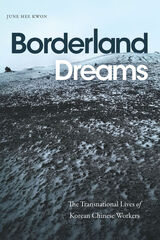 Borderland Dreams: The Transnational Lives of Korean Chinese Workers
June Hee Kwon
Duke University Press, 2023 In Borderland Dreams June Hee Kwon explores the trajectory of the “Korean dream” that has fueled the massive migration of Korean Chinese workers from the Yanbian Korean Autonomous Prefecture in northeast China to South Korea since the early 1990s. Charting the interplay of bodies, money, and time, the ethnography reveals how these migrant workers, in the course of pursuing their borderland dreams, are transformed into a transnational ethnicized class. Kwon analyzes the persistent desire of Korean Chinese to “leave to live better” at the intersection between the neoliberalizing regimes of post-socialist China and post–Cold War South Korea. Scrutinizing the tensions and affinities among the Korean Chinese, North and South Koreans, and Han Chinese whose lives intertwine in the borderland, Kwon captures the diverse and multifaceted aspirations of Korean Chinese workers caught between the ascendant Chinese dream and the waning Korean dream.
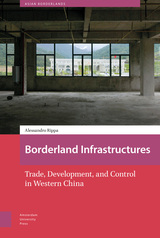 Borderland Infrastructures: Trade, Development, and Control in Western China
Alessandro Rippa
Amsterdam University Press, 2020 Across the Chinese borderlands, investments in large-scale transnational infrastructure such as roads and special economic zones have increased exponentially over the past two decades. Based on long-term ethnographic research, Borderland Infrastructures addresses a major contradiction at the heart of this fast-paced development: small-scale traders have lost their historic strategic advantages under the growth of massive Chinese state investment and are now struggling to keep their businesses afloat. Concurrently, local ethnic minorities have become the target of radical resettlement projects, securitization, and tourism initiatives, and have in many cases grown increasingly dependent on state subsidies. At the juncture of anthropological explorations of the state, border studies, and research on transnational trade and infrastructure development, Borderland Infrastructures provides new analytical tools to understand how state power is experienced, mediated, and enacted in Xinjiang and Yunnan. In the process, Rippa offers a rich and nuanced ethnography of life across China’s peripheries.
 Borderland Jaguars: Tigres de la Frontera
David E. Brown
University of Utah Press, 2001 "What is it about these borderland cats which has so fired up people? Scarcity combined with beauty explains some of the appeal. So does the animal’s legendary strength and power as befits its role as the region’s top predator. The jaguar’s neotropical origins also add to its mystique...But there is something more. That such a large cat is out there somewhere...invokes the depths of our imagination. Nor does it matter one whit that the chance of any one individual actually seeing one is almost nil. The thought of such a cat’s presence is enough in itself."—from the book
In 1996 a rancher hunting mountain lions just north of the Arizona-Mexico border treed a jaguar. Instead of reaching for a rifle, the rancher went for his camera. Later that year another party photographed a jaguar in Arizona’s Baboquivari Mountains. These compelling photographs sparked public interest in jaguars and have resulted in calls for listing jaguars as an endangered species.
Borderland Jaguars documents the human-jaguar contact in the Southwest and presents jaguar folklore from both sides of the border. But the book is primarily a natural history of the jaguar, and discusses its distribution, habitats, and hunting and breeding characteristics before concluding with a section on the status and management of borderland jaguars, and a proposed conservation plan. Written in an engaging style, and replete with a wealth of photographs, Borderland Jaguars is a wonderful introduction to this elusive resident of the Southwest.
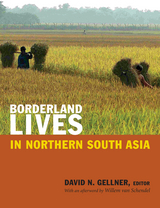 Borderland Lives in Northern South Asia
David N. Gellner, ed.
Duke University Press, 2013 Borderland Lives in Northern South Asia provides valuable new ethnographic insights into life along some of the most contentious borders in the world. The collected essays portray existence at different points across India's northern frontiers and, in one instance, along borders within India. Whether discussing Shi'i Muslims striving to be patriotic Indians in the Kashmiri district of Kargil or Bangladeshis living uneasily in an enclave surrounded by Indian territory, the contributors show that state borders in Northern South Asia are complex sites of contestation. India's borders with Bangladesh, Bhutan, Burma/Myanmar, China, and Nepal encompass radically different ways of life, a whole spectrum of relationships to the state, and many struggles with urgent identity issues. Taken together, the essays show how, by looking at state-making in diverse, border-related contexts, it is possible to comprehend Northern South Asia's various nation-state projects without relapsing into conventional nationalist accounts. Contributors. Jason Cons, Rosalind Evans, Nicholas Farrelly, David N. Gellner, Radhika Gupta, Sondra L. Hausner, Annu Jalais, Vibha Joshi, Nayanika Mathur, Deepak K. Mishra, Anastasia Piliavsky, Jeevan R. Sharma, Willem van Schendel
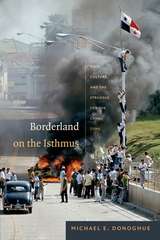 Borderland on the Isthmus: Race, Culture, and the Struggle for the Canal Zone
Michael E. Donoghue
Duke University Press, 2014 The construction, maintenance, and defense of the Panama Canal brought Panamanians, U.S. soldiers and civilians, West Indians, Asians, and Latin Americans into close, even intimate, contact. In this lively and provocative social history, Michael E. Donoghue positions the Panama Canal Zone as an imperial borderland where U.S. power, culture, and ideology were projected and contested. Highlighting race as both an overt and underlying force that shaped life in and beyond the Zone, Donoghue details how local traditions and colonial policies interacted and frequently clashed. Panamanians responded to U.S. occupation with proclamations, protests, and everyday forms of resistance and acquiescence. Although U.S. "Zonians" and military personnel stigmatized Panamanians as racial inferiors, they also sought them out for service labor, contraband, sexual pleasure, and marriage. The Canal Zone, he concludes, reproduced classic colonial hierarchies of race, national identity, and gender, establishing a model for other U.S. bases and imperial outposts around the globe.
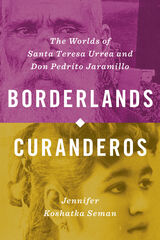 Borderlands Curanderos: The Worlds of Santa Teresa Urrea and Don Pedrito Jaramillo
By Jennifer Koshatka Seman
University of Texas Press, 2021 2022 Americo Paredes Award, Center for Mexican American Studies at South Texas College
A historical exploration of the worlds and healing practices of two curanderos (faith healers) who attracted thousands, rallied their communities, and challenged institutional powers.
Santa Teresa Urrea and Don Pedrito Jaramillo were curanderos—faith healers—who, in the late nineteenth and early twentieth centuries, worked outside the realm of "professional medicine," seemingly beyond the reach of the church, state, or certified health practitioners whose profession was still in its infancy. Urrea healed Mexicans, Indigenous people, and Anglos in northwestern Mexico and cities throughout the US Southwest, while Jaramillo conducted his healing practice in the South Texas Rio Grande Valley, healing Tejanos, Mexicans, and Indigenous people there. Jennifer Koshatka Seman takes us inside the intimate worlds of both "living saints," demonstrating how their effective healing—curanderismo—made them part of the larger turn-of-the century worlds they lived in as they attracted thousands of followers, validated folk practices, and contributed to a modernizing world along the US-Mexico border. While she healed, Urrea spoke of a Mexico in which one did not have to obey unjust laws or confess one's sins to Catholic priests. Jaramillo restored and fed drought-stricken Tejanos when the state and modern medicine could not meet their needs. Then, in 1890, Urrea was expelled from Mexico. Within a decade, Jaramillo was investigated as a fraud by the American Medical Association and the US Post Office. Borderlands Curanderos argues that it is not only state and professional institutions that build and maintain communities, nations, and national identities but also those less obviously powerful.
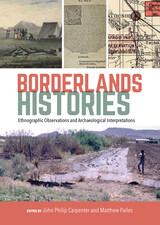 Borderlands Histories: Ethnographic Observations and Archaeological Interpretations
Edited by John Philip Carpenter and Matthew Pailes
University of Utah Press, 2021 What are the connections between past and present peoples in the U.S. Southwest and Northwest Mexico? How were the ancient societies that occupied this landscape interconnected? Contributors leverage diverse source materials rooted in classic ethnography, oral tradition, and historical documents to offer novel answers to these questions. Running throughout the discussions is a metanarrative that reflects the tensions between disciplines such as anthropology and history and the rapidly evolving dynamic between scholars and the Indigenous subjects of past and present research. With chapters written by scholars from the U.S. and Mexico, including Indigenous coauthors, Borderlands Histories offers diverse perspectives and illustrates the range of methods and interpretive approaches employed by some of the most respected and experienced names in the field of borderlands archaeology today.
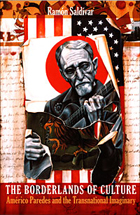 The Borderlands of Culture: Americo Paredes and the Transnational Imaginary
Ramón Saldívar
Duke University Press, 2006 Poet, novelist, journalist, and ethnographer, Américo Paredes (1915–1999) was a pioneering figure in Mexican American border studies and a founder of Chicano studies. Paredes taught literature and anthropology at the University of Texas, Austin for decades, and his ethnographic and literary critical work laid the groundwork for subsequent scholarship on the folktales, legends, and riddles of Mexican Americans. In this beautifully written literary history, the distinguished scholar Ramón Saldívar establishes Paredes’s preeminent place in writing the contested cultural history of the south Texas borderlands. At the same time, Saldívar reveals Paredes as a precursor to the “new” American cultural studies by showing how he perceptively negotiated the contradictions between the national and transnational forces at work in the Americas in the nascent era of globalization. Saldívar demonstrates how Paredes’s poetry, prose, and journalism prefigured his later work as a folklorist and ethnographer. In song, story, and poetry, Paredes first developed the themes and issues that would be central to his celebrated later work on the “border studies” or “anthropology of the borderlands.” Saldívar describes how Paredes’s experiences as an American soldier, journalist, and humanitarian aid worker in Asia shaped his understanding of the relations between Anglos and Mexicans in the borderlands of south Texas and of national and ethnic identities more broadly. Saldívar was a friend of Paredes, and part of The Borderlands of Culture is told in Paredes’s own words. By explaining how Paredes’s work engaged with issues central to contemporary scholarship, Saldívar extends Paredes’s intellectual project and shows how it contributes to the remapping of the field of American studies from a transnational perspective.
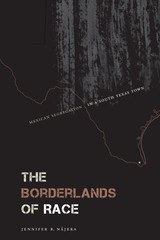 The Borderlands of Race: Mexican Segregation in a South Texas Town
By Jennifer R. Nájera
University of Texas Press, 2015 Throughout much of the twentieth century, Mexican Americans experienced segregation in many areas of public life, but the structure of Mexican segregation differed from the strict racial divides of the Jim Crow South. Factors such as higher socioeconomic status, lighter skin color, and Anglo cultural fluency allowed some Mexican Americans to gain limited access to the Anglo power structure. Paradoxically, however, this partial assimilation made full desegregation more difficult for the rest of the Mexican American community, which continued to experience informal segregation long after federal and state laws officially ended the practice. In this historical ethnography, Jennifer R. Nájera offers a layered rendering and analysis of Mexican segregation in a South Texas community in the first half of the twentieth century. Using oral histories and local archives, she brings to life Mexican origin peoples’ experiences with segregation. Through their stories and supporting documentary evidence, Nájera shows how the ambiguous racial status of Mexican origin people allowed some of them to be exceptions to the rule of Anglo racial dominance. She demonstrates that while such exceptionality might suggest the permeability of the color line, in fact the selective and limited incorporation of Mexicans into Anglo society actually reinforced segregation by creating an illusion that the community had been integrated and no further changes were needed. Nájera also reveals how the actions of everyday people ultimately challenged racial/racist ideologies and created meaningful spaces for Mexicans in spheres historically dominated by Anglos.
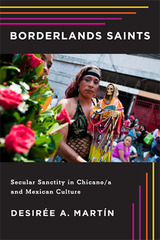 Borderlands Saints: Secular Sanctity in Chicano/a and Mexican Culture
Martín, Desirée A
Rutgers University Press, 2013 Winner of the 2014 Latina/o Studies Section - LASA Outstanding Book Award
In Borderlands Saints, Desirée A. Martín examines the rise and fall of popular saints and saint-like figures in the borderlands of the United States and Mexico. Focusing specifically on Teresa Urrea (La Santa de Cabora), Pancho Villa, César Chávez, Subcomandante Marcos, and Santa Muerte, she traces the intersections of these figures, their devotees, artistic representations, and dominant institutions with an eye for the ways in which such unofficial saints mirror traditional spiritual practices and serve specific cultural needs. Popular spirituality of this kind engages the use and exchange of relics, faith healing, pilgrimages, and spirit possession, exemplifying the contradictions between high and popular culture, human and divine, and secular and sacred. Martín focuses upon a wide range of Mexican and Chicano/a cultural works drawn from the nineteenth century to the present, covering such diverse genres as the novel, the communiqué, drama, the essay or crónica, film, and contemporary digital media. She argues that spiritual practice is often represented as narrative, while narrative—whether literary, historical, visual, or oral—may modify or even function as devotional practice.
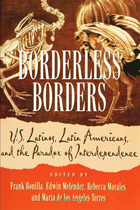 Borderless Borders
edited by Frank Bonilla, Edwin Meléndez, Rebecca Morales and María de los Angeles Torres
Temple University Press, 2000 This new reality -- the Latinization of the United States -- is driven by forces that reach well beyond U.S. borders. It asserts itself demographically, politically, in the workplace, and in daily life. The perception that Latinos are now positioned to help bring about change in the Americas from within the United States has taken hold, sparking renewed interest and specific initiatives by hemispheric governments to cultivate new forms of relationships with emigrant communities.
Borderless Borders describes the structural processes and active interventions taking place inside and outside U.S. Latino communities. After a context-setting introduction by urban planner Rebecca Morales, the contributors focus on four themes. Economist Manuel Pastor Jr., urban sociologist Saskia Sassen, and political scientist Carol Wise look at emerging forms of global and transnational interdependence and at whether they are likely to produce individuals who are economically independent or simply more dependent. Sociologist Jorge Chapa, social anthropologist Maria P. Fernandez Kelly, and economist Edwin Melendez examine the negative impact of economic and political restructuring within the United States,especially within Latino communities. Performance artist Guillermo Gomez-Pena, legal scholar Gerald Torres, political scientist Maria de los Angeles Torres, and modern language specialist Silvio Torres-Saillant consider the implications -- for community formation, citizenship, political participation, and human rights -- of the fact that individuals are forced to construct identities for themselves in more than one sociopolitical setting. Finally, sociologist Jeremy Brecher, sociologist Frank Bonilla, and political scientist Pedro Caban speculate on new paths into international relations and issue-oriented social movements and organizations among these mobile populations. To supplement the written contributions, Painter Bibiana Suarez has chosen several artworks that contribute to the interdisciplinary scope of the book.
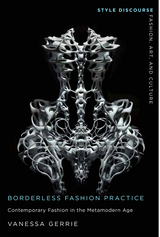 Borderless Fashion Practice: Contemporary Fashion in the Metamodern Age
Vanessa Gerrie
Rutgers University Press, 2023 Twenty-first century fashion practice has become increasingly borderless and diverse in the digital era, calling into question the very boundaries that define fashion in the Western cultural context. Borderless Fashion Practice: Contemporary Fashion in the Metamodern Age principally engages the work of four fashion designers -- Virgil Abloh, Aitor Throup, Iris Van Herpen, and Eckhaus Latta -- whose work intersects with other creative disciplines such as art, technology, science, architecture, and graphic design. They do their work in what Vanessa Gerrie calls the metamodern age -- the time and place where the polarization between the modern and the postmodern collapses. Used as a framework to understand the current Western cultural zeitgeist, Gerrie's exploration of the work of contemporary practitioners and theorists finds blurred borders and seeks to blur them further, to the point of erasure.
 Borderline Americans: Racial Division and Labor War in the Arizona Borderlands
Katherine Benton-Cohen
Harvard University Press, 2011 “Are you an American, or are you not?” This was the question Harry Wheeler, sheriff of Cochise County, Arizona, used to choose his targets in one of the most remarkable vigilante actions ever carried out on U.S. soil. And this is the question at the heart of Katherine Benton-Cohen’s provocative history, which ties that seemingly remote corner of the country to one of America’s central concerns: the historical creation of racial boundaries.
It was in Cochise County that the Earps and Clantons fought, Geronimo surrendered, and Wheeler led the infamous Bisbee Deportation, and it is where private militias patrol for undocumented migrants today. These dramatic events animate the rich story of the Arizona borderlands, where people of nearly every nationality—drawn by “free” land or by jobs in the copper mines—grappled with questions of race and national identity. Benton-Cohen explores the daily lives and shifting racial boundaries between groups as disparate as Apache resistance fighters, Chinese merchants, Mexican-American homesteaders, Midwestern dry farmers, Mormon polygamists, Serbian miners, New York mine managers, and Anglo women reformers.
Racial categories once blurry grew sharper as industrial mining dominated the region. Ideas about home, family, work and wages, manhood and womanhood all shaped how people thought about race. Mexicans were legally white, but were they suitable marriage partners for “Americans”? Why were Italian miners described as living “as no white man can”? By showing the multiple possibilities for racial meanings in America, Benton-Cohen’s insightful and informative work challenges our assumptions about race and national identity.
 Borderman: Memoirs of Federico José María Ronstadt
Edited by Edward F. Ronstadt; Forewords by Bernard L. Fontana and Ernesto Portillo, Jr.
University of Arizona Press, 2003 Born in Sonora in 1868 to a Mexican mother and a German father, Federico Ronstadt was the quintessential borderman. He came to Arizona Territory as a young man to learn a trade and eventually became an American citizen; but with many relatives on both sides of the border, Federico was equally at home in Mexico and in his adopted country.
Writing proudly of his Mexican and American heritages, Ronstadt offers readers an extraordinary portrait of the Arizona-Mexico borderlands during the late nineteenth century. His memoirs provide a richness of detail and insight unmatched by traditional histories, relating such scenarios as the hardships of Yaqui hardrock miners working under primitive conditions, the travails of pearl divers in the Gulf of California, and the insurrection of Francisco Serna in 1875 Sonora. They also depict the simple activities of childhood, with its schooling and musical training, its games and mischief. Ronstadt relates his apprenticeship to a wagon- and carriage-maker in Tucson, recalling labor relations in the shop, the establishment of his own business, and the joys and anguish of his personal life. He tells of how he drew on talents nurtured in childhood to become a musician and bandleader, playing weekly concerts with Club Filarmónica Tucsonense for nine years—musical talents that were eventually passed on to his children, his grandchildren (including Linda), and great-grandchildren.
Through Ronstadt's memories, we are better able to understand the sense of independence and self-reliance found today among many lifelong residents of Sonora and Baja California—people isolated from major supply sources and centers of power—and to appreciate a different view of Tucson's past. Enhanced by 22 historical photos, Borderman is a treasure trove of historical source material that will enlighten all readers interested in borderlands history.
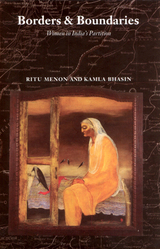 Borders and Boundaries: How Women Experienced the Partition of India
Ritu Menon
Rutgers University Press, 1998 As an event of shattering consequence, the Partition of India remains significant today. While Partition sounds smooth on paper, the reality was horrific. More than eight million people migrated and one million died in the process. The forced migration, violence between Hindus and Muslims, and mass widowhood were unprecedented and well-documented. What was less obvious but equally real was that millions of people had to realign their identities, uncertain about who they thought they were. The rending of the social and emotional fabric that took place in 1947 is still far from mended.
While there are plenty of official accounts of Partition, there are few social histories and no feminist histories. Borders and Boundaries changes that, providing first-hand accounts and memoirs, juxtaposed alongside official government accounts. The authors make women not only visible but central. They explore what country, nation, and religious identity meant for women, and they address the question of the nation-state and the gendering of citizenship.
In the largest ever peace-time mass migration of people, violence against women became the norm. Thousands of women committed suicide or were done to death by their own kinsmen. Nearly 100,000 women were "abducted" during the migration. A young woman might have been separated from her family when a convoy was ambushed, abducted by people of another religion, forced to convert, and forced into marriage or cohabitation. After bearing a child, she would be offered the opportunity to return only if she left her child behind and if she could face shame in her natal community. These stories do not paint their subjects as victims. Theirs are the stories of battles over gender, the body, sexuality, and nationalism-stories of women fighting for identity.
 Borders and Boundaries in and around Dutch Jewish History
Edited by Judith Frishman, David J. Wertheim, Ido de Haan, and Joël Cahen
Amsterdam University Press, 2011 The widespread and long-held preconception that all Jews lived in ghettos and were relentlessly subject to discrimination prior to the Enlightenment has only slowly eroded. Geographically speaking, Jews rarely lived in ghettos and have never been confined within the borders of one nation or country. Power struggles and wars often led to the creation of new national borders that divided communities once united. But if identity formation is subject to change and negotiation, it does not depend solely on shifting geographical borders.
A variety of boundaries were and are still being constructed and maintained between ethnic and other collective identities. The contributors to this book, like other post-modernist historians, turn their gaze to a wide range of identities once taken for granted, identities located on the border lines between one country and the next, between Jews and non-Jews as well as on those between one group of Jews and another.
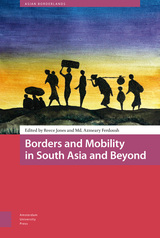 Borders and Mobility in South Asia and Beyond
Edited by Reece Jones and Md. Azmeary Ferdoush
Amsterdam University Press, 2018 Migration and borders are at the center of political debates in South Asia and around the world as more people migrate in search of safety and opportunity. This book brings a deep engagement with individuals whose lives are shaped by encounters with borders by telling the stories of a poor Bangladeshi women who regularly crosses the India border to visit family, of Muslims from India living in Gulf countries for work, and the harrowing journey of a young Afghan man as he sets off on foot to Germany. The international and interdisciplinary work in this book contributes to this moment by analyzing how borders are experienced by migrants and borderlanders in South Asia, how mobility and diaspora are engaged in literature and media, and how the lives of migrants are transformed during their journey to new homes in South Asia, the Middle East, North America, and Europe.
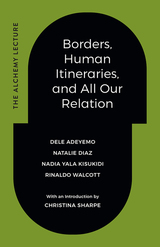 Borders, Human Itineraries, and All Our Relation
Dele Adeyemo, Natalie Diaz, Nadia Yala Kisukidi, and Rinaldo Walcott. With a Foreword by Christina Sharpe
Duke University Press, 2024 The first annual Alchemy Lecture brings four deep and agile writers from different geographies and disciplines into vibrant conversation on a topic of urgent relevance: humans and borders. Borders, Human Itineraries, and All Our Relation captures and expands those conversations in insightful, passionate ways. Architect, artist, and urban theorist Dele Adeyemo (UK/Nigeria) calls attention to the complexity of Black infrastructures, questioning how “the environments that surround us condition the possibility of our being.” Poet Natalie Diaz (US/Mojave/Akimel O’otham) writes, “Like story, migration is the sensual movement of knowledge,” and asks, “What is the language we need to live right now?” Philosopher Nadia Yala Kisukidi (France) suggests there is no diasporic life “without the dynamics of fabulation, where we pass down, from generation to generation, the stories of our ancestors who walked barefoot for many months.” And cultural theorist Rinaldo Walcott (Canada) asks us to consider inheritances beyond white supremacist logics: “What might it mean to live a life, if we can’t risk desiring and working towards utopia?” As each alchemist considers the legacies of anticolonial struggle, the future of the planet, and the textures of Black and Indigenous life, their essays speak to each other in multiple ways, creating something startling and revelatory: a vision of the world as it is, and as it could be.
 The Borders of America: Migration, Control, and Resistance Across Latin America and the Caribbean
Soledad Álvarez Velasco, Nicholas De Genova, Gustavo Dias, and Eduardo Domenech, editors
Duke University Press, 2026 The Borders of America examines the tension between human migration and the diverse formations of border control and immigration and asylum policy that have arisen across the Americas since the start of the twenty-first century. The collection develops a single analytical framework that is hemispheric in scope, encompassing the United States, Canada, the Caribbean, and the full extent of Latin America. The contributors offer the concept of a “border regime” as an epistemological and methodological approach that comprehends borders not merely as physical demarcations between state territories and jurisdictions but rather as expansive, uneven, and heterogeneous spaces of constant encounter, exchange, dispute, tension, conflict, and contestation. Presenting detailed empirical research into contemporary intra-regional and transcontinental mobilities across the hemisphere, The Borders of America scrutinizes an array of critical nodes in the larger configuration of the trans-American border regime.
Contributors. Soledad Álvarez Velasco, Tanya Basok, Janneth Clavijo, Nicholas De Genova, Gustavo Dias, Eduardo Domenech, Roberto Dufraix-Tapia, Jonathan Echeverri Zuluaga, Valentina Glockner Fagetti, Luin Goldring, Patricia Landolt, Carolina Moulin, Margarita Luz Núñez Chaim, Juan Ordóñez, Daniel Quinteros, Romina Ramos, Martha Rojas-Wiesner, Fabio Santos, Amarela Varela-Huerta, and Laura Velasco Ortiz
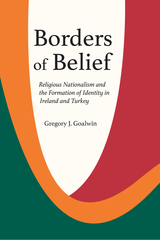 Borders of Belief: Religious Nationalism and the Formation of Identity in Ireland and Turkey
Gregory J. Goalwin
Rutgers University Press, 2022 Religion and nationalism are two of the most powerful forces in the world. And as powerful as they are separately, humans throughout history have fused religious beliefs and nationalist politics to develop religious nationalism, which uses religious identity to define membership in the national community. But why and how have modern nationalists built religious identity as the foundational signifier of national identity in what sociologists have predicted would be a more secular world? This book takes two cases - nationalism in both Ireland and Turkey in the 20th century - as a foundation to advance a new theory of religious nationalism. By comparing cases, Goalwin emphasizes how modern political actors deploy religious identity as a boundary that differentiates national groups This theory argues that religious nationalism is not a knee-jerk reaction to secular modernization, but a powerful movement developed as a tool that forges new and independent national identities.
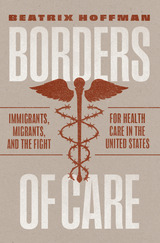 Borders of Care: Immigrants, Migrants, and the Fight for Health Care in the United States
Beatrix Hoffman
University of Chicago Press, 2025 Probes the relationship between the immigration and health care systems in the United States.
For the roughly ten million undocumented immigrants living in the United States, federal health care coverage is out of reach. Barred from Medicare, Medicaid, and the Affordable Care Act, most rely on hospital emergency rooms when they get sick, or clinics that don’t inquire about immigration status. Further obstacles to health care, including discrimination and the fear of deportation, mean that immigrants, undocumented or not, seek and receive less medical attention than any other population in the country. Yet immigrants haven’t always been ostracized from health care in the United States—providers and activists have for over a century worked to make medical services available to newcomers and migrants, including, at times, the undocumented.
Drawing together stories from diverse communities from the mid-nineteenth century to the present, Borders of Care examines how health care in the United States has both included and excluded immigrants. Beatrix Hoffman analyzes both the health and immigration systems, adding to our understanding of why these structures, and the policies that support them, have resisted reform. Moreover, she shows that immigrants, often scapegoated as burdens on the health-care system, have strengthened it through their responses to systemic exclusion. By creating hospitals and clinics, serving as practitioners, fighting for safer workplaces, filing lawsuits, organizing and protesting, immigrants and migrants have improved medical access for everybody and advanced the idea of health care as a universal right. As accessible as it is authoritative, Hoffman’s survey could not be more timely.
 Borders of Care: Immigrants, Migrants, and the Fight for Health Care in the United States
Beatrix Hoffman
University of Chicago Press, 2025 This is an auto-narrated audiobook version of this book.
Probes the relationship between the immigration and health care systems in the United States.
For the roughly ten million undocumented immigrants living in the United States, federal health care coverage is out of reach. Barred from Medicare, Medicaid, and the Affordable Care Act, most rely on hospital emergency rooms when they get sick, or clinics that don’t inquire about immigration status. Further obstacles to health care, including discrimination and the fear of deportation, mean that immigrants, undocumented or not, seek and receive less medical attention than any other population in the country. Yet immigrants haven’t always been ostracized from health care in the United States—providers and activists have for over a century worked to make medical services available to newcomers and migrants, including, at times, the undocumented.
Drawing together stories from diverse communities from the mid-nineteenth century to the present, Borders of Care examines how health care in the United States has both included and excluded immigrants. Beatrix Hoffman analyzes both the health and immigration systems, adding to our understanding of why these structures, and the policies that support them, have resisted reform. Moreover, she shows that immigrants, often scapegoated as burdens on the health-care system, have strengthened it through their responses to systemic exclusion. By creating hospitals and clinics, serving as practitioners, fighting for safer workplaces, filing lawsuits, organizing and protesting, immigrants and migrants have improved medical access for everybody and advanced the idea of health care as a universal right. As accessible as it is authoritative, Hoffman’s survey could not be more timely.
 The Borders of Chinese Architecture
Nancy Shatzman Steinhardt
Harvard University Press, 2022 An internationally acclaimed expert explains why Chinese-style architecture has remained so consistent for two thousand years, no matter where it is built.
For the last two millennia, an overwhelming number of Chinese buildings have been elevated on platforms, supported by pillars, and covered by ceramic-tile roofs. Less obvious features, like the brackets connecting the pillars to roof frames, also have been remarkably constant. What makes the shared features more significant, however, is that they are present in Buddhist, Daoist, Confucian, and Islamic milieus; residential, funerary, and garden structures; in Japan, Korea, Mongolia, and elsewhere. How did Chinese-style architecture maintain such standardization for so long, even beyond China’s borders?
Nancy Shatzman Steinhardt examines the essential features of Chinese architecture and its global transmission and translation from the predynastic age to the eighteenth century. Across myriad political, social, and cultural contexts within China and throughout East Asia, certain design and construction principles endured. Builders never abandoned perishable wood in favor of more permanent building materials, even though Chinese engineers knew how to make brick and stone structures in the last millennium BCE. Chinese architecture the world over is also distinctive in that it was invariably accomplished by anonymous craftsmen. And Chinese buildings held consistently to the plan of the four-sided enclosure, which both afforded privacy and differentiated sacred interior space from an exterior understood as the sphere of profane activity. Finally, Chinese-style buildings have always and everywhere been organized along straight lines.
Taking note of these and other fascinating uniformities, The Borders of Chinese Architecture offers an accessible and authoritative overview of a tradition studiously preserved across time and space.
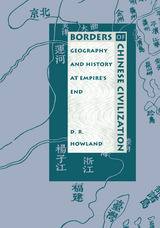 Borders of Chinese Civilization: Geography and History at Empire's End
D. R. Howland
Duke University Press, 1996 D. R. Howland explores China’s representations of Japan in the changing world of the late nineteenth century and, in so doing, examines the cultural and social borders between the two neighbors. Looking at Chinese accounts of Japan written during the 1870s and 1880s, he undertakes an unprecedented analysis of the main genres the Chinese used to portray Japan—the travel diary, poetry, and the geographical treatise. In his discussion of the practice of “brushtalk,” in which Chinese scholars communicated with the Japanese by exchanging ideographs, Howland further shows how the Chinese viewed the communication of their language and its dominant modes—history and poetry—as the textual and cultural basis of a shared civilization between the two societies.
With Japan’s decision in the 1870s to modernize and westernize, China’s relationship with Japan underwent a crucial change—one that resulted in its decisive separation from Chinese civilization and, according to Howland, a destabilization of China’s worldview. His examination of the ways in which Chinese perceptions of Japan altered in the 1880s reveals the crucial choice faced by the Chinese of whether to interact with Japan as “kin,” based on geographical proximity and the existence of common cultural threads, or as a “barbarian,” an alien force molded by European influence.
By probing China’s poetic and expository modes of portraying Japan, Borders of Chinese Civilization exposes the changing world of the nineteenth century and China’s comprehension of it. This broadly appealing work will engage scholars in the fields of Asian studies, Chinese literature, history, and geography, as well as those interested in theoretical reflections on travel or modernism.
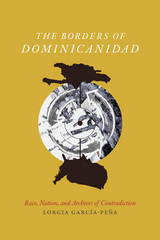 The Borders of Dominicanidad: Race, Nation, and Archives of Contradiction
Lorgia García Peña
Duke University Press, 2016 In The Borders of Dominicanidad Lorgia García-Peña explores the ways official narratives and histories have been projected onto racialized Dominican bodies as a means of sustaining the nation's borders. García-Peña constructs a genealogy of dominicanidad that highlights how Afro-Dominicans, ethnic Haitians, and Dominicans living abroad have contested these dominant narratives and their violent, silencing, and exclusionary effects. Centering the role of U.S. imperialism in drawing racial borders between Haiti, the Dominican Republic, and the United States, she analyzes musical, visual, artistic, and literary representations of foundational moments in the history of the Dominican Republic: the murder of three girls and their father in 1822; the criminalization of Afro-religious practice during the U.S. occupation between 1916 and 1924; the massacre of more than 20,000 people on the Dominican-Haitian border in 1937; and the 2010 earthquake in Haiti. García-Peña also considers the contemporary emergence of a broader Dominican consciousness among artists and intellectuals that offers alternative perspectives to questions of identity as well as the means to make audible the voices of long-silenced Dominicans.
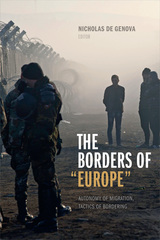 The Borders of "Europe": Autonomy of Migration, Tactics of Bordering
Nicholas De Genova, editor
Duke University Press, 2017 In recent years the borders of Europe have been perceived as being besieged by a staggering refugee and migration crisis. The contributors to The Borders of "Europe" see this crisis less as an incursion into Europe by external conflicts than as the result of migrants exercising their freedom of movement. Addressing the new technologies and technical forms European states use to curb, control, and constrain what contributors to the volume call the autonomy of migration, this book shows how the continent's amorphous borders present a premier site for the enactment and disputation of the very idea of Europe. They also outline how from Istanbul to London, Sweden to Mali, and Tunisia to Latvia, migrants are finding ways to subvert visa policies and asylum procedures while negotiating increasingly militarized and surveilled borders. Situating the migration crisis within a global frame and attending to migrant and refugee supporters as well as those who stoke nativist fears, this timely volume demonstrates how the enforcement of Europe’s borders is an important element of the worldwide regulation of human mobility.
Contributors. Ruben Andersson, Nicholas De Genova, Dace Dzenovska, Evelina Gambino, Glenda Garelli, Charles Heller, Clara Lecadet, Souad Osseiran, Lorenzo Pezzani, Fiorenza Picozza, Stephan Scheel, Maurice Stierl, Laia Soto Bermant, Martina Tazzioli
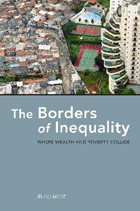 The Borders of Inequality: Where Wealth and Poverty Collide
Íñigo Moré
University of Arizona Press, 2011 Recently U.S. media, policymakers, and commentators of all stripes have been preoccupied with the nation’s border with Mexico. Airwaves, websites, and blogs are filled with concerns over border issues: illegal immigrants, drug wars, narcotics trafficking, and “securing the border.” While this is a valid conversation, it’s rarely contrasted with the other U.S. border, with Canada—still the longest unguarded border on Earth.
In this fascinating book, originally published in Spain to much acclaim, researcher Íñigo Moré looks at the bigger picture. With a professionally trained eye, he examines the world’s “top twenty most unequal borders.” What he finds is that many of these border situations share similar characteristics. There is always illegal immigration from the poor country to the wealthy one. There is always trafficking in illegal substances. And the unequal neighbors usually regard each other with suspicion or even open hostility.
After surveying the “top twenty,” Moré explores in depth the cases of three borders: between Germany and Poland, Spain and Morocco, and the United States and Mexico. The core problem, he concludes, is not drugs or immigration or self-protection. Rather, the problem is inequality itself. Unequal borders result, he writes, from a skewed interaction among markets, people, and states. Using these findings, Moré builds a useful new framework for analyzing border dynamics from a quantitative view based on economic inequality.
The Borders of Inequality illustrates how longstanding “multidirectional misunderstandings” can exacerbate cross-border problems—and consequent public opinion. Perpetuating these misunderstandings can inflame and complicate the situation, but purposeful efforts to reduce inequality can produce promising results.
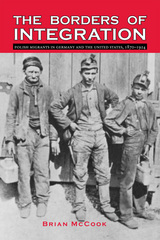 The Borders of Integration: Polish Migrants in Germany and the United States, 1870–1924
Brian McCook
Ohio University Press, 2011 The issues of immigration and integration are at the forefront of contemporary politics. Yet debates over foreign workers and the desirability of their incorporation into European and American societies too often are discussed without a sense of history. McCook’s examination questions static assumptions about race and white immigrant assimilation a hundred years ago, highlighting how the Polish immigrant experience is relevant to present-day immigration debates on both sides of the Atlantic. Further, his research shows the complexity of attitudes toward immigration in Germany and the United States, challenging historical myths surrounding German national identity and the American “melting pot.” In a comparative study of Polish migrants who settled in the Ruhr Valley and northeastern Pennsylvania, McCook shows that in both regions, Poles become active citizens within their host societies through engagement in social conflict within the public sphere to defend their ethnic, class, gender, and religious interests. While adapting to the Ruhr and northeastern Pennsylvania, Poles simultaneously retained strong bonds with Poland, through remittances, the exchange of letters, newspapers, and frequent return migration. In this analysis of migration in a globalizing world, McCook highlights the multifaceted ways in which immigrants integrate into society, focusing in particular on how Poles created and utilized transnational spaces to mobilize and attain authentic and more permanent identities grounded in newer broadly conceived notions of citizenship.
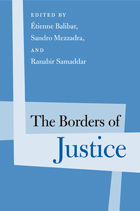 The Borders of Justice
Etienne Balibar
Temple University Press, 2013 International in scope and featuring a diverse group of contributors, The Borders of Justice investigates the complexities of transitional justice that emerge from its “social embeddedness.” This original and provocative collection of essays, which stem from a collective research program on social justice undertaken by the Calcutta Research Group, confronts the concept and practices of justice. The editors and contributors question the relationship between geography, methodology, and justice—how and why justice is meted out differently in different places. Expanding on Michael Walzer's idea of the “spheres of justice,” the contributors argue that justice is burdened with our notions of social realities and expectations, in addition to the influence of money, law, and government. Chapters provide close readings of Pascal, Plato and Marx, theories on global justice, the relationship between liberalism and multiculturalism, struggles of social injustice, and how and where we draw the borders of justice.
 The Borders of Responsibility: Migration Control in the Mediterranean Sea
Kiri Olivia Santer
Duke University Press, 2026 While migrants face many dangers in attempting to reach Europe by crossing the Mediterranean Sea—from drowning to dying of dehydration—they also confront an elaborate legal system that is designed to return them to their countries of origin. In The Borders of Responsibility, Kiri Olivia Santer outlines the architecture of these legal systems and how they help Europe evade legal responsibility for rescuing migrants. Focusing on legal agreements between Italy and Libya that have resulted in the systematic interception of migrants, Santer shows how Europe’s liberal identity is belied by legal agreements that let migrants die at sea or that send them back to dangerous, exploitative situations in post-Gaddafi Libya or their home countries. Law, she argues, is the tool that enables states to affect control beyond territory, whilst disappearing their responsibility for violence across border assemblages. Through ethnographic fieldwork with migrants, lawyers, policy makers, and humanitarian workers, Santer shows how the law is too often used as an instrument of violence against migrants, who fall outside of conventional structures of legal rights.
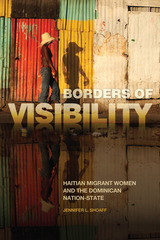 Borders of Visibility: Haitian Migrant Women and the Dominican Nation-State
by Jennifer L. Shoaff
University of Alabama Press, 2018 An anthropological study of Haitian migrant women in the Dominican Republic.
Borders of Visibility offers extremely timely insight into the Dominican Republic’s racist treatment of Haitian descendants within its borders. Jennifer L. Shoaff employs multisited feminist research to focus on the geographies of power that intersect to inform the opportunities and constraints that migrant women must navigate to labor and live within a context that largely denies their human rights, access to citizenship, and a sense of security and belonging.
Paradoxically, these women are both hypervisible because of the blackness that they embody and invisible because they are marginalized by intersecting power inequalities. Haitian women must contend with diffuse legal, bureaucratic and discursive state-local practices across “border” sites that situate them as a specific kind of threat that must be contained. Shoaff examines this dialectic of mobility and containment across various sites in the northwest Dominican Republic, including the official border crossing, transborder and regional used-clothing markets, migrant settlements (bateyes), and other rural-urban contexts.
Shoaff combines ethnographic interviews, participant observation, institutional analyses of state structures and nongovernmental agencies, and archival documentation to bring this human rights issue to the fore. Although primarily grounded in critical ethnographic practice, this work contributes to the larger fields of transnational feminism, black studies, migration and border studies, political economy, and cultural geography. Borders of Visibility brings much needed attention to Haitian migrant women’s economic ingenuity and entrepreneurial savvy, their ability to survive and thrive, their often impossible choices whether to move or to stay, returning them to a place of visibility, while exposing the very structures that continue to render them invisible and, thus, expendable over time.
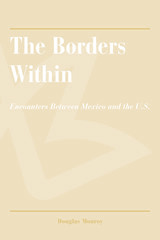 The Borders Within: Encounters Between Mexico and the U.S.
Douglas Monroy
University of Arizona Press, 2008 Throughout its history, the nation that is now called the United States has been inextricably entwined with the nation now called Mexico. Indeed, their indigenous peoples interacted long before borders of any kind were established. Today, though, the border between the two nations is so prominent that it is front-page news in both countries.
Douglas Monroy, a noted Mexican American historian, has for many years pondered the historical and cultural intertwinings of the two nations. Here, in beautifully crafted essays, he reflects on some of the many ways in which the citizens of the two countries have misunderstood each other.
Putting himself— and his own quest for understanding—directly into his work, he contemplates the missions of California; the differences between “liberal” and “traditional” societies; the meanings of words like Mexican, Chicano, and Latino; and even the significance of avocados and bathing suits. In thought-provoking chapters, he considers why Native Americans didn’t embrace Catholicism, why NAFTA isn’t working the way it was supposed to, and why Mexicans and their neighbors to the north tell themselves different versions of the same historical events.
In his own thoughtful way, Monroy is an explorer. Rather than trying to conquer new lands, however, his goal is to gain new insights. He wants to comprehend two cultures that are bound to each other without fully recognizing their bonds. Along with Monroy, readers will discover that borders, when we stop and really think about it, are drawn more deeply in our minds than on any maps.
 Borderscapes: Hidden Geographies and Politics at Territory’s Edge
Prem Kumar Rajaram
University of Minnesota Press, 2007 Connecting critical issues of state sovereignty with empirical concerns, Borderscapes interrogates the limits of political space. The essays in this volume analyze everyday procedures, such as the classifying of migrants and refugees, security in European and American detention centers, and the DNA sampling of migrants in Thailand, showing the border as a moral construct rich with panic, danger, and patriotism. Conceptualizing such places as immigration detention camps and refugee camps as areas of political contestation, this work forcefully argues that borders and migration are, ultimately, inextricable from questions of justice and its limits. Contributors: Didier Bigo, Institut d’Études Politiques, Paris; Karin Dean; Elspeth Guild, U of Nijmegen; Emma Haddad; Alexander Horstmann, U of Münster; Alice M. Nah, National U of Singapore; Suvendrini Perera, Curtin U of Technology, Australia; James D. Sidaway, U of Plymouth, UK; Nevzat Soguk, U of Hawai‘i; Decha Tangseefa, Thammasat U, Bangkok; Mika Toyota, National U of Singapore. Prem Kumar Rajaram is assistant professor of sociology and social anthropology at the Central European University, Budapest, Hungary. Carl Grundy-Warr is senior lecturer of geography at the National University of Singapore.
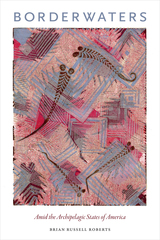 Borderwaters: Amid the Archipelagic States of America
Brian Russell Roberts
Duke University Press, 2021 Conventional narratives describe the United States as a continental country bordered by Canada and Mexico. Yet, since the late twentieth century the United States has claimed more water space than land space, and more water space than perhaps any other country in the world. This watery version of the United States borders some twenty-one countries, particularly in the archipelagoes of the Pacific and the Caribbean. In Borderwaters Brian Russell Roberts dispels continental national mythologies to advance an alternative image of the United States as an archipelagic nation. Drawing on literature, visual art, and other expressive forms that range from novels by Mark Twain and Zora Neale Hurston to Indigenous testimonies against nuclear testing and Miguel Covarrubias's visual representations of Indonesia and the Caribbean, Roberts remaps both the fundamentals of US geography and the foundations of how we discuss US culture.
Borealis
Jeff Humphries
University of Minnesota Press, 2002
 Bored, Lonely, Angry, Stupid: Changing Feelings about Technology, from the Telegraph to Twitter
Luke Fernandez and Susan J. Matt
Harvard University Press, 2020 An Entrepreneur Best Book of the Year
Facebook makes us lonely. Selfies breed narcissism. On Twitter, hostility reigns. Pundits and psychologists warn that digital technologies substantially alter our emotional states, but in this lively investigation of changing feelings about technology, we learn that the gadgets we use don’t just affect how we feel—they can profoundly change our sense of self. When we say we’re bored, we don’t mean the same thing as a Victorian dandy. Could it be that political punditry has helped shape a new kind of anger? Luke Fernandez and Susan Matt take us back in time to consider how our feelings of loneliness, boredom, vanity, and anger have evolved in tandem with new technologies.
“Technologies have been shaping [our] emotional culture for more than a century, argue computer scientist Luke Fernandez and historian Susan Matt in this original study. Marshalling archival sources and interviews, they trace how norms (say, around loneliness) have shifted with technological change.”
—Nature
“A powerful story of how new forms of technology are continually integrated into the human experience.”
—Publishers Weekly
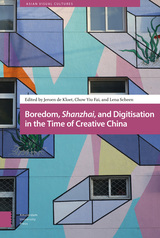 Boredom, Shanzhai, and Digitisation in the Time of Creative China
Jeroen de Kloet
Amsterdam University Press, 2019 With its emergence as a global power, China aspires to transform from made in China to created in China. Mobilised as a crucial source for solid growth and soft power, creativity has become part of the new China Dream. Boredom, Shanzhai, and Digitisation in the Time of Creative China engages with the imperative of creativity by aligning it to three interrelated phenomena: boredom, shanzhai, and digitisation. How does creativity help mitigate boredom? Does boredom incubate creativity? How do shanzhai practices and the omnipresence of fake goods challenge notions of the original and the authentic? Which spaces for expressions and contestations has China’s fast-developing digital world of Weixin, Taobao, Youku, and Internet Plus Policy opened up? Are new technologies serving old interests? Essays, dialogues, audio-visual documents, and field notes, from thinkers, researchers, practitioners, and policy-makers, examine what is going on in China now, ultimately to tease out its implication to our understanding of creativity.
Boredom: The Literary History of a State of Mind
Patricia Meyer Spacks
University of Chicago Press, 1994 This book offers a witty explanation of why boredom both haunts and motivates the literary imagination. Moving from Samuel Johnson to Donald Barthelme, from Jane Austen to Anita Brookner, Spacks shows us at last how we arrived in a postmodern world where boredom is the all-encompassing name we give our discontent. Her book, anything but boring, gives us new insight into the cultural usefulness—and deep interest—of boredom as a state of mind.
 Borges: An Introduction
Julio Premat
Vanderbilt University Press, 2021 This book, available for the first time in English, offers a thorough introductory reading of Jorge Luis Borges, one of the most remarkable and influential writers of the twentieth century. Julio Premat, a specialist in the field of Borges studies, presents the main questions posed by Borges's often paradoxical writing, and leads the novice through the complexity and breadth of Borges's vast literary production.
Originally published in French by an Argentine ex-pat living in Paris, Borges includes the Argentine specificities of Borges’s work—specificities that are often unrecognized or glossed over in Anglophone readings.
This book is a boon for university students of philosophy and literature, teachers and researchers in these fields who are looking to better understand this complex author, and anyone interested in the advanced study of literature. Somewhere between a guidebook and an exhaustive work of advanced research, Borges is the ultimate stepping-stone into the deeper Borgesian world.
 Borges and Europe Revisited
Edited by Evelyn Fishburn
University of London Press, 1998 This compilation of essays takes a fresh look at Borges's work. A wide variety of topics, ranging from the European avant-garde to the impact of European science upon Argentine literature, is discussed from a mutiplicity of angles - the only unifying factor being the year 1996, when nearly all the essays were written. Most of them were presented as papers at a one-day conference held at the Institute of Romance Studies, in conjunction with the Institute of Latin American Studies. The purpose was to re-examine the work of Borges in the wake of the great changes in reading that 'theory' had brought about and which Borges had somehow foreshadowed, though of course not systematised. Contributors Include: Daniel Balderston, University of Iowa; Malcolm Bowie, University of Oxford; Gabriel Josipovici, University of Sussex; Bernard McGuirk, University of Nottingham; Sylvia Molloy, New York University; Eduardo L. Ortiz, Imperial College; William Rowe, Birkbeck College, London; Jason Wilson, University College, London.
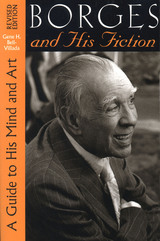 Borges and His Fiction: A Guide to His Mind and Art
By Gene H. Bell-Villada
University of Texas Press, 2000 From reviews of the first edition: "A compulsively readable account of the life and works of our greatest...writer of fantasy. With a keen appreciation of Borges himself and a pleasant disregard for the critical clichés, Bell-Villada tells us all we really want to know about the modern master-from pronouncing his name to understanding the stories." —New York Daily News "Of the scores of Borges studies by now published in English, Bell-Villada's excellent book stands out as one of the freshest and most generally helpful.... Lay readers and specialists alike will find his book a valuable and highly readable companion to Ficciones and El Aleph." —Choice Since its first publication in 1981, Borges and His Fiction has introduced the life and works of this Argentinian master-writer to an entire generation of students, high school and college teachers, and general readers. Responding to a steady demand for an updated edition, Gene H. Bell-Villada has significantly revised and expanded the book to incorporate new information that has become available since Borges' death in 1986. In particular, he offers a more complete look at Borges and Peronism and Borges' personal experiences of love and mysticism, as well as revised interpretations of some of Borges' stories. As before, the book is divided into three sections that examine Borges' life, his stories in Ficciones and El Aleph, and his place in world literature.
 Borges and Kafka, Bolaño and Bloom: Latin American Authors and the Western Canon
Juan E. De Castro
Vanderbilt University Press, 2022 At a time in which many in the United States see Spanish America as a distinct and, for some, threatening culture clearly differentiated from that of Europe and the US, it may be of use to look at the works of some of the most representative and celebrated writers from the region to see how they imagined their relationship to Western culture and literature. In fact, while authors across stylistic and political divides—like Gabriela Mistral, Jorge Luis Borges, or Gabriel García Márquez—see their work as being framed within the confines of a globalized Western literary tradition, their relationship, rather than epigonal, is often subversive.
Borges and Kafka, Bolaño and Bloom is a parsing not simply of these authors' reactions to a canon, but of the notion of canon writ large and the inequities and erasures therein. It concludes with a look at the testimonial and autobiographical writings of Rigoberta Menchú and Lurgio Gavilán, who arguably represent the trajectory of Indigenous testimonial and autobiographical writing during the last forty years, noting how their texts represent alternative ways of relating to national and, on occasion, Western cultures. This study is a new attempt to map writers' diverse ways of thinking about locality and universality from within and without what is known as the canon.
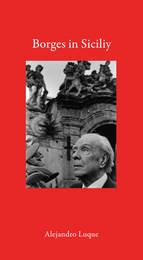 Borges in Sicily: Journey with a Blind Guide
Alejandro Luque
Haus Publishing, 2017 When Alejandro Luque receives a book of photographs taken in Sicily by the Argentinian writer, essayist, and poet Luis Borges, he decides to trace the writer’s journey, setting off with a group of friends on his own Sicilian odyssey. Meticulously identifying the location of each photograph, Luque uses Borges’s pictures to imagine the range of emotions that the renowned writer felt as he experienced the same views. As his hunt for the locations of the original photographs unfolds, Luque chronicles the ways in which he begins to fall in love with both the island itself and with his friend, Ro.
This winding journey features literati both past and present, indigenous and foreign. These characters live alongside Luque’s own comments and observations in a narrative that is rich in historical and personal detail. The writer who inspired this great journey, Borges himself, becomes a character in this narrative that is infused with extracts and reflections from his essays and poetry. Borges in Sicily acts as a travel diary, a guide to the most fascinating places in Sicily, a recounting of Borges’s journey around the island, and a deeply poetic story of Luque’s own adventures. The book also includes twenty-three photographs from the renowned Magnum photographer Ferdinando Scianna, and it won the 1st Premio International del Libros de Viajes.
Borgo Of The Holy Ghost
Stephen McLeod foreword by Richard Howard
Utah State University Press, 2002 An accomplished poet with credits in such literary magazines as APR, Paris Review, Ploughshares, and many others, Stephen McLeod is the 2001 recipient of the May Swenson Poetry Award. Judge for the competition was Richard Howard, internationally known poet and winner of the Pulitzer and many other poetry awards.
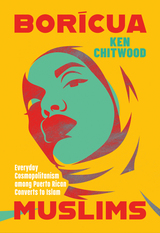 Borícua Muslims: Everyday Cosmopolitanism among Puerto Rican Converts to Islam
Ken Chitwood
University of Texas Press, 2025 The stories and struggles of Puerto Rican Muslims in modern day America. Among Puerto Rican converts to Islam, marginalization is a fact of daily life. Their “authenticity” is questioned by other Muslims and by fellow Borícua on the island and in the United States. At the same time, they exist under the shadow of US colonization and as Muslims in the context of American empire. To be a Puerto Rican Muslim, then, is to negotiate identity at numerous intersections of diversity and difference. Drawing on years of ethnographic research and more than a hundred interviews conducted in Puerto Rico, New York, Florida, Texas, New Jersey, and online, Ken Chitwood tells the story of Puerto Rican Muslims as they construct a shared sense of peoplehood through everyday practices. Borícua Muslims thus provides a study of cosmopolitanism not as a political ideal but as a mundane social reality—a reality that complicates scholarly and public conversations about race, ethnicity, and religion in the Americas. Expanding the geography of global Islam and recasting the relationship between religion and Puerto Rican culture, Borícua Muslims is an insightful reckoning with the manifold entanglements of identity amid late-modern globalization.
 Boris Pasternak: The Poet and His Politics
Lazar Fleishman
Harvard University Press, 1990 Boris Pasternak has generally been regarded as an artist who was indifferent to the literary and political storms of his time. Lazar Fleishman gives the great writer's life a new perspective. He shows that Pasternak's entire literary career should be regarded as a complex and passionate response to constant changes in Russian cultural and social life.
Drawing on a vast array of sources, Fleishman's chronicle encompasses both the familiar and the little-known aspects of the poet's life and work. He describes the formative role played by Pasternak's father, a prominent Russian painter, and the intellectual endeavors of the young man before his literary debut. He explores the intricate relations of Pasternak to the main movements of literary modernism, including symbolism and futurism.
Particularly informative are the chapters devoted to the postrevolutionary years. Fleishman untangles the poet's contacts with leading political figures (Stalin, Trotsky, Bukharin) and fellow writers (Gorky, Mayakovsky, Tsvetaeva, Akhmatova, Mandelshtam), and examines his changes in fortune during the purges and World War II. He shows how Pasternak was perceived by Western contemporaries and how significant their moral support was for him during the darkest years of Stalin's regime. He provides explanations for the Christian themes in Pasternak's later work, as well as the poet's peculiar view of Jewry. Finally, Fleishman recreates the vicissitudes of the publication of Doctor Zhivago and the ensuing Nobel Prize scandal in 1958. A fascinating description of the writer's career in broad context, this book will be welcomed by everyone interested in Pasternak and in twentieth-century literature.
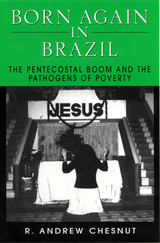 Born Again in Brazil: The Pentecostal Boom and the Pathogens of Poverty
R. Andrew Chesnut
Rutgers University Press, 1997 A spiritual revolution is transforming the religious landscape of Latin America. Evangelical Protestantism, particularly Pentecostalism, has replaced Catholicism as the leading religion in thousands of barrios on the urban periphery. But in few Latin American nations have Protestants multiplied as rapidly as in Brazil. What accounts for this rise? Combining historical, political, and ethnographic research, R. Andrew Chestnut shows that the relationship between faith healing and illness in the conversion process is integral to the popularity of Pentecostalism among Brazil's poor. He augments his analysis of the economic and political factors with extensive interview material to capture his informants' conversion experience. In doing so, he presents both a historical framework for a broad understanding of Pentecostalism in Latin America and insight into the personal motivations and beliefs of the crentes themselves.
Born Again: The Christian Right Globalized
Jennifer S. Butler
Pluto Press, 2006 The Christian Right wields massive political power in the United States and beyond. This is the first book to reveal the growing influence of the Christian Right within the United Nations.
This book reveals how Christian conservative groups are able to shape policy in every corner of the world. Drawing on interviews with religious leaders, it reveals how today's most powerful Christian Right organisations are building interfaith coalitions, connecting Catholic, Mormon and Muslim allies to advance a conservative agenda.
The US under Bush Jr. has given them a significant voice in shaping US policy on issues including women's rights, reproductive health, human cloning, children's rights and AIDS.
In short, the Christian Right is globalising -- a phenomenon that promises to challenge progressive social policy on a world-wide scale - as well as transform the Christian Right itself.
 Born in Bondage: Growing Up Enslaved in the Antebellum South
Marie Jenkins Schwartz
Harvard University Press, 2000 Each time a child was born in bondage, the system of slavery began anew. Although raised by their parents or by surrogates in the slave community, children were ultimately subject to the rule of their owners. Following the life cycle of a child from birth through youth to young adulthood, Marie Jenkins Schwartz explores the daunting world of slave children, a world governed by the dual authority of parent and owner, each with conflicting agendas.
Despite the constant threats of separation and the necessity of submission to the slaveowner, slave families managed to pass on essential lessons about enduring bondage with human dignity. Schwartz counters the commonly held vision of the paternalistic slaveholder who determines the life and welfare of his passive chattel, showing instead how slaves struggled to give their children a sense of self and belonging that denied the owner complete control.
Born in Bondage gives us an unsurpassed look at what it meant to grow up as a slave in the antebellum South. Schwartz recreates the experiences of these bound but resilient young people as they learned to negotiate between acts of submission and selfhood, between the worlds of commodity and community.
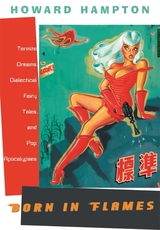 Born in Flames: Termite Dreams, Dialectical Fairy Tales, and Pop Apocalypses
Howard Hampton
Harvard University Press, 2008 Twenty years as an outsider scouring the underbelly of American culture has made Howard Hampton a uniquely hard-nosed guide to the heart of pop darkness. Bridging the fatalistic, intensely charged space between Apocalypse Now Redux and Nirvana’s “Smells Like Teen Spirit,” his writing breaks down barriers of ignorance and arrogance that have segregated art forms from each other and often from the world at large.
In the freewheeling spirit of Pauline Kael, Lester Bangs, and Manny Farber, Hampton calls up the extremist, underground tendencies and archaic forces simmering beneath the surface of popular forms. Ranging from the kinetic poetry of Hong Kong cinema and the neo–New Wave energy of Irma Vep to the punk heroines of Sleater-Kinney and Ghost World, Born in Flames plays odd couples off one another: pitting Natural Born Killers against Forrest Gump, contrasting Jean-Luc Godard with Steven Spielberg, defending David Lynch against aesthetic ideologues, invoking The Curse of the Mekons against Fredric Jameson’s Postmodernism, and introducing D. H. Lawrence to Buffy the Vampire Slayer. “We are born in flames,” sang the incandescent Lora Logic, and here those flames are a source of illumination as well as destruction, warmth as well as consumption.
From the scorched-earth works of action-movie provocateurs Seijun Suzuki and Sam Peckinpah to the cargo cult soundscapes of Pere Ubu and the Czech dissidents Plastic People of the Universe, Born in Flames is a headlong plunge into the passions and disruptive power of art.
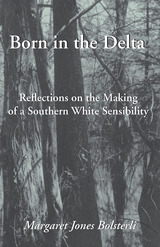 Born in the Delta: Reflections on the Making of a Southern White Sensibility
Margaret Bolsterli
University of Arkansas Press, 2000 In this gracefully written memoir, Margaret Jones Bolsterli recounts her experiences as a lively, observant girl coming of age on an Arkansas cotton farm during the 1930s and 1940s. The Mississippi River's broad, flat floodplain provides the setting for her vivid strokes of memory and history each portraying key elements of the "southern sensibility." Bolsterli's themes include the southerner's strong sense of place, the penchant for stories rather than true dialog, a caste system based on formality and race, the underlying current of violence, and the repressive function of evangelical religion. She also examines manners, the patriarchal family structure, the "southern belle" concept, and the persistence of the memory of the Civil War. A fascinating chapter on food indicates how African and European customs are melded in southern cuisine to include chicken, pork, "cracklin' bread," gravy and biscuits, field peas, turnip greens, butter beans, devil's food cake, and dill pickles. Comparable to Shirley Abbott's Womenfolks, Born in the Delta is a valuable resource for those interested in southern history and culture, as well as readers who just enjoy a good story, well-told.
The Born in the Spring: A Collection of Spring Wildflowers
June Carver Roberts
Ohio University Press, 2024 A must for flower and art lovers, Born in the Spring is a unique collection of line drawings and magnificent watercolors of spring wildflowers. All of the drawings and paintings were done from living plants, in minute detail, with complete botanical accuracy. There are over 90 illustrations, 46 of which are in full color. The text accompanying each plate enables the reader to easily locate the flower in its natural setting. The text also includes the origins of the common and botanical names, and bits of history and lore connected with the flowers. Some are hardy aliens that have come from all over the world, while others are fragile natives described by the earliest settlers; some are now becoming rare.
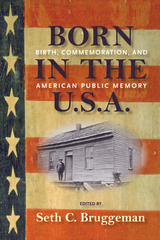 Born in the U.S.A.: Birth, Commemoration, and American Public Memory
Seth C. Bruggeman
University of Massachusetts Press, 2012 Scores of birthplace monuments and historic childhood homes dot the American landscape. These special places, many dating to the early years of the last century, have enshrined nativity alongside patriotism and valor among the key pillars of the nation's popular historical imagination. The essays in this volume suggest that the way Americans have celebrated famous births reflects evolving expectations of citizenship as well as a willingness to edit the past when those hopes go unfulfilled. The contributors also demonstrate that the reinvention of origin myths at birthplace monuments still factors in American political culture and the search for meaning in an ever-shifting global order.
Beyond asking why it is that Americans care about birthplaces and how they choose which ones to commemorate, Born in the U.S.A. offers insights from historians, curators, interpretive specialists, and others whose experience speaks directly to the challenges of managing historical sites. Each essay points to new ways of telling old stories at these mainstays of American memory. The case of the modern house museum receives special attention in a provocative concluding essay by Patricia West.
In addition to West and the editor, contributors include Christine Arato, Dan Currie, Keith A. Erekson, David Glassberg, Anna Thompson Hajdik, Zachary J. Lechner, Paul Lewis, Hilary Iris Lowe, Cynthia Miller, Laura Lawfer Orr, Robert Paynter, Angela Phelps, and Paul Reber.
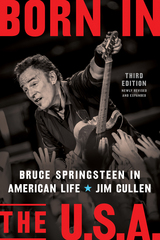 Born in the U.S.A.: Bruce Springsteen in American Life, 3rd edition, Revised and Expanded
Jim Cullen
Rutgers University Press, 2024 Pioneering the field of Springsteen scholarship when it first appeared in 1997, Born in the U.S.A. remains one of the definitive studies of Springsteen’s work and its impact on American culture. Moving beyond journalistic and biographical approaches, Jim Cullen situates the artist in a wider historical canvas that stretches from the Puritans to Barack Obama, showing how he has absorbed, refracted, and revitalized American mythology, including the American Dream, the work ethic, and the long quest for racial justice. Exploring difficult questions about Springsteen’s politics, he finds a man committed to both democratic and republican principles, as well as a patriot dedicated to revealing the lapses of a country he loves.
This third edition of Born in the U.S.A. is fully revised and updated, incorporating discussion of Springsteen’s wide output in the 21st century. While addressing Springsteen’s responses to events like 9/11, it also considers the evolution of his attitudes towards religion, masculinity, and his relationship with his audience. Whether a serious Springsteen fan or simply an observer of American popular culture, Born in the U.S.A. will give you a new appreciation for The Boss.
 Born Losers: A History of Failure in America
Scott A. Sandage
Harvard University Press, 2006 What makes somebody a Loser, a person doomed to unfulfilled dreams and humiliation? Nobody is born to lose, and yet failure embodies our worst fears. The Loser is our national bogeyman, and his history over the past two hundred years reveals the dark side of success, how economic striving reshaped the self and soul of America.
From colonial days to the Columbine tragedy, Scott Sandage explores how failure evolved from a business loss into a personality deficit, from a career setback to a gauge of our self-worth. From hundreds of private diaries, family letters, business records, and even early credit reports, Sandage reconstructs the dramas of real-life Willy Lomans. He unearths their confessions and denials, foolish hopes and lost faith, sticking places and changing times. Dreamers, suckers, and nobodies come to life in the major scenes of American history, like the Civil War and the approach of big business, showing how the national quest for success remade the individual ordeal of failure.
Born Losers is a pioneering work of American cultural history, which connects everyday attitudes and anxieties about failure to lofty ideals of individualism and salesmanship of self. Sandage's storytelling will resonate with all of us as it brings to life forgotten men and women who wrestled with The Loser--the label and the experience--in the days when American capitalism was building a nation of winners.
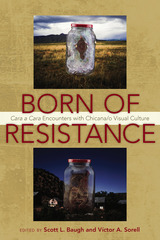 Born of Resistance: Cara a Cara Encounters with Chicana/o Visual Culture
Edited by Scott L. Baugh and Víctor A. Sorell
University of Arizona Press, 2015 This collection of essays interrogates the most contested social, political, and aesthetic concept in Chicana/o cultural studies—resistance.
If Chicana/o culture was born of resistance amid assimilation and nationalistic forces, how has it evolved into the twenty-first century? This groundbreaking volume redresses the central idea of resistance in Chicana/o visual cultural expression through nine clustered discussions, each coordinating scholarly, critical, curatorial, and historical contextualizations alongside artist statements and interviews. Landmark artistic works—illustrations, paintings, sculpture, photography, film, and television—anchor each section. Contributors include David Avalos, Mel Casas, Ester Hernández, Nicholas Herrera, Luis Jiménez, Ellen Landis, Yolanda López, Richard Lou, Delilah Montoya, Laura Pérez, Lourdes Portillo, Luis Tapia, Chuy Treviño, Willie Varela, Kathy Vargas, René Yañez, Yvonne Yarbro-Bejarano, and more. Cara a cara, face-to-face, encounters across the collection reveal the varied richness of resistant strategies, movidas, as they position crucial terms of debate surrounding resistance, including subversion, oppression, affirmation, and identification.
The essays in the collection represent a wide array of perspectives on Chicana/o visual culture. Editors Scott L. Baugh and Víctor A. Sorell have curated a dialog among the many voices, creating an important new volume that redefines the role of resistance in Chicana/o visual arts and cultural expression.
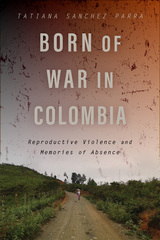 Born of War in Colombia: Reproductive Violence and Memories of Absence
Tatiana Sanchez Parra
Rutgers University Press, 2024 Born of War in Colombia addresses why people born of conflict-related sexual violence remain unseen within transitional justice agendas. In Colombia, there are generations of children born of conflict-related sexual violence across the country. Whispers of their presence have traveled outside their communities. They also exist within the country’s domestic reparations program, which entitles them to reparations. Drawing on an immersive feminist ethnography with a community that endured a paramilitary confinement, the book reveals how a past-oriented and harm-centered model of transitional justice has converged with a restricted notion of gendered victimhood and the patriarchal politics of reproduction to render the bodies and experiences of people born of conflict-related sexual violence unintelligible to those seeking to understand and address the consequences of war in Colombia.
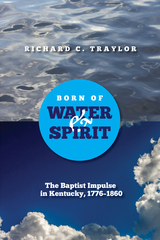 Born of Water and Spirit: The Baptist Impulse in Kentucky, 1776-1860
Richard Traylor
University of Tennessee Press, 2015 "I know of no other work like Born of Water and Spirit. Its contributions are threefold: it describes Baptist life in Kentucky in the formative period of the American Republic, it utilizes excellent primary material, and, most importantly, it interprets developments in light of what the writer successfully describes as the ‘Baptist impulse.’”
—Walter B. Shurden, author of Turning Points in Baptist History
Between 1776 and the mid-1800s, the number of Baptists in the United States grew at a staggering rate, rising from fifty thousand at the outbreak of revolution to more than a million as the nation edged toward civil war. As the Second Great Awakening swept through the Old Southwest, it generated religious enthusiasm among Methodist and Baptist converts who were intent upon replacing old forms of Protestantism with an evangelical vibrancy that reflected and often contributed to the unsettled social relations of the new republic. No place was better suited to embrace this enthusiasm than Kentucky. In Born of Water and Spirit, Richard C. Traylor explores the successes and failures of Baptists in this area, using it as a window into the elements of Baptist life that transcended locale.
Traylor argues that the achievements of Baptists in Kentucky reflect, in many ways, their success and coming of age in the early national period of America. The factionalism that characterized frontier Baptists, he asserts, is an essential key to understanding who the colonial Baptists had been, who they were becoming in the late eighteenth through the mid-nineteenth centuries, and who they would become after the Civil War.
In this highly nuanced study, Traylor looks at the denomination in light of what he calls its “Baptist impulse”—the movement’s fluid structure and democratic spirit. These characteristics have proven to be its greatest strength as well as the source of its most terrible struggles. Yet, confronting theological clashes, along with the challenges that come with growth, forged the Baptist identity and shaped its future.
The first three chapters examine the primary elements of the impulse: rituals of conversion, baptism, and communion; the Baptist preacher; and the significance of the local church to the sect. Following these chapters are explorations of the reformations and forces of change in the early to mid-1800s, the role of women and African Americans in developing the group, and the refinement and reorientation of priorities from 1840 to 1860. This important denominational history will be of great value to scholars of American religious history and the history of the early American republic.
Richard C. Traylor is a professor of history at Hardin-Simmons University in Abilene, Texas. His articles have been published in Baptist HistoryandHeritage and Missouri Historical Review.
Born Palestinian, Born Black: & The Gaza Suite
Suheir Hammad
UpSet Press, 2012 UpSet Press has restored to print Suheir Hammad's first book of poems, Born Palestinian, Born Black, originally published by Harlem River Press in 1996. The new edition is augmented with a new author's preface, and new poems, under the heading, The Gaza Suite, as well as a new publisher's note by Zohra Saed, an introduction by Marco Villalobos, and an afterword by Kazim Ali.
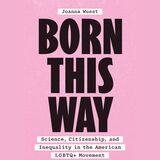 Born This Way: Science, Citizenship, and Inequality in the American LGBTQ+ Movement
Joanna Wuest
University of Chicago Press, 2023 This is an auto-narrated audiobook version of this book.
The story of how a biologically driven understanding of gender and sexuality became central to US LGBTQ+ political and legal advocacy. Across protests and courtrooms, LGBTQ+ advocates argue that sexual and gender identities are innate. Oppositely, conservatives incite panic over “groomers” and a contagious “gender ideology” that corrupts susceptible children. Yet, as this debate rages on, the history of what first compelled the hunt for homosexuality’s biological origin story may hold answers for the queer rights movement’s future. Born This Way tells the story of how a biologically based understanding of gender and sexuality became central to LGBTQ+ advocacy. Starting in the 1950s, activists sought out mental health experts to combat the pathologizing of homosexuality. As Joanna Wuest shows, these relationships were forged in subsequent decades alongside two broader, concurrent developments: the rise of an interest-group model of rights advocacy and an explosion of biogenetic and bio-based psychological research. The result is essential reading to fully understand LGBTQ+ activism today and how clashes over science remain crucial to equal rights struggles.
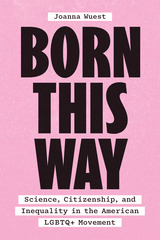 Born This Way: Science, Citizenship, and Inequality in the American LGBTQ+ Movement
Joanna Wuest
University of Chicago Press, 2023 The story of how a biologically driven understanding of gender and sexuality became central to US LGBTQ+ political and legal advocacy. Across protests and courtrooms, LGBTQ+ advocates argue that sexual and gender identities are innate. Oppositely, conservatives incite panic over “groomers” and a contagious “gender ideology” that corrupts susceptible children. Yet, as this debate rages on, the history of what first compelled the hunt for homosexuality’s biological origin story may hold answers for the queer rights movement’s future. Born This Way tells the story of how a biologically based understanding of gender and sexuality became central to LGBTQ+ advocacy. Starting in the 1950s, activists sought out mental health experts to combat the pathologizing of homosexuality. As Joanna Wuest shows, these relationships were forged in subsequent decades alongside two broader, concurrent developments: the rise of an interest-group model of rights advocacy and an explosion of biogenetic and bio-based psychological research. The result is essential reading to fully understand LGBTQ+ activism today and how clashes over science remain crucial to equal rights struggles.
Born to Belonging: Writings on Spirit and Justice
Mab Segrest
Rutgers University Press, 2002 Veteran activist Mab Segrest takes readers along on her travels to view a world experiencing extraordinary change. As she moves from place to place, she speculates on the effects of globalization and urban development on individuals, examines the struggles for racial, economic, and sexual equality, and narrates her own history as a lesbian in the American South. From the principle that we all belong to the human community, Segrest uses her personal experience as a filter for larger political and cultural issues. Her writings bring together such groups as the Ku Klux Klan in North Carolina, fledging gay rights activists in Zimbabwe, and resistance fighters in El Salvador. Segrest expertly plumbs her own personal experiences for organizing principles and maxims to combat racism, homophobia, sexism, and economic exploitation.
Born to Pull: The Glory of Sled Dogs
Bob Cary
University of Minnesota Press, 1999 For centuries, sled dogs pulled the people of northern climates over otherwise impassable distances of snow and ice, guiding them home through trackless wilderness. These burly, strong dogs were the lifeblood of the northern winter world. Today, from races like the famed Iditarod and the John Beargrease Sled Dog Marathon to sled dog tours, people from all climates are rediscovering the joy of this dog-powered sport. Born to Pull is a celebration of sled dogs who love to run in cold and snowy Minnesota, including lively stories from veteran mushers, insider information on dog care and training, and breathtaking watercolor illustrations that make the dogs come to life on the page.
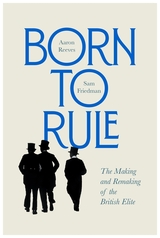 Born to Rule: The Making and Remaking of the British Elite
Aaron Reeves and Sam Friedman
Harvard University Press, 2024 The Economist, Best Books of 2024
The Times, Best Ideas Books of 2024
A uniquely data-rich analysis of the British elite from the Victorian era to today: who gets in, how they get there, what they like and look like, where they go to school, and what politics they perpetuate.
Are Britain’s power brokers a conservative chumocracy, born to privilege and anointed at Eton and Oxford? Or is a new progressive elite emerging with different values and political instincts? In search of answers, Aaron Reeves and Sam Friedman scrutinized the profiles of over 125,000 members of the British elite from the late 1890s to today. At the heart of this meticulously researched study is the historical database of Who’s Who, but Reeves and Friedman also mined genealogical records, examined probate data, and interviewed over 200 leading figures from a wide range of backgrounds to uncover who runs Britain.
What they found is that there is less movement at the top than we think. Yes, there has been some progress on including women and Black and Asian Brits, but those born into the top 1 percent are just as likely to get into the elite today as they were 125 years ago. What has changed is how elites present themselves. Today’s elite pedal hard to convince us they are perfectly ordinary.
Why should we care? Because the elites we have affect the politics we get. While scholars have long proposed that the family you are born into, and the schools you attend, leave a mark on the exercise of power, the empirical evidence has been thin—until now.
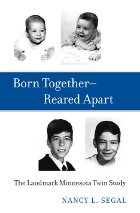 Born Together—Reared Apart: The Landmark Minnesota Twin Study
Nancy L. Segal
Harvard University Press, 2012 The identical “Jim twins” were raised in separate families and met for the first time at age thirty-nine, only to discover that they both suffered tension headaches, bit their fingernails, smoked Salems, enjoyed woodworking, and vacationed on the same Florida beach. This example of the potential power of genetics captured widespread media attention in 1979 and inspired the Minnesota Study of Twins Reared Apart. This landmark investigation into the nature-nurture debate shook the scientific community by demonstrating, across a number of traits, that twins reared separately are as alike as those raised together.
As a postdoctoral fellow and then as assistant director of the Minnesota Study, Nancy L. Segal provides an eagerly anticipated overview of its scientific contributions and their effect on public consciousness. The study’s evidence of genetic influence on individual differences in traits such as personality (50%) and intelligence (70%) overturned conventional ideas about parenting and teaching. Treating children differently and nurturing their inherent talents suddenly seemed to be a fairer approach than treating them all the same. Findings of genetic influence on physiological characteristics such as cardiac and immunologic function have led to more targeted approaches to disease prevention and treatment. And indications of a stronger genetic influence on male than female homosexuality have furthered debate regarding sexual orientation.
 A Born Writer: Juanita Harrison and Her Beautiful World
Cathryn Halverson
University of Massachusetts Press, 2025 The first biography of a best-selling travel writer dedicated to the pursuit of leisure, freedom, and experience
Despite the challenges she faced as an average southern Black woman of her time, Juanita Harrison transcended expectations, earning a unique place in African American and literary history. Over the course of more than four decades, she traveled constantly, first throughout the US and then throughout the world. To fund her trips, she took on short-term jobs as housekeeper, cook, and nurse, never committing to any one household. Always on the move, she made it a rule to travel alone, and she had a penchant for “passing,” not as white but as local. Her wanderlust was less aspirational and upwardly mobile than dedicated to the pursuit of leisure, freedom, and experience. “It’s my life to see and enjoy,” she declared.
In 1936, she published My Great, Wide, Beautiful World, a travelogue that charts her life between 1927 and 1935. A compilation of letters she sent to friends, employers, and patrons during her travels, the book was an immediate success, running through nine printings within ten months and becoming a bestseller for that year. The illustrious Atlantic Monthly published excerpts, the book was reviewed in newspapers and magazines nationwide, and it attracted a remarkably diverse readership, sparking the enthusiasm of Black working-class library patrons, white women’s book clubs, Japanese American journalists, Harlem Renaissance luminaries, and many others. It came back into print in 1996, ensuring her legacy would endure.
A Born Writer is the first biography of this fascinating woman who found a uniquely rewarding way to live and work that many would envy today. Combining micro histories, literary criticism, and biography—and despite limited archival records—Cathryn Halverson skillfully traces Harrison from her birth in the bitterly divided South to her death in Hawai’i, tracking her varied experiences along the way in New York, Havana, Paris, Madrid, Cairo, Mumbai, Kobe, Buenos Aires, and many other places. The resulting portrait shows a woman who transcended all kinds of borders—political, social, and cultural—to experience a freedom rarely available to women, and especially women of color, in the early-to-mid twentieth century, an achievement that continues to resonate.
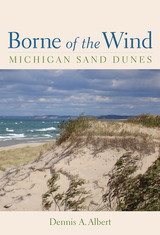 Borne of the Wind: Michigan Sand Dunes
Dennis A. Albert
University of Michigan Press, 2006 Sand dunes are among the most rugged and beautiful natural wonders of Michigan's shorelines. These sandy edifices-at once substantial and ephemeral-are the most extensive freshwater dunes in the world, so immense they are visible from outer space. The coastal dunes are also extraordinarily fertile, supporting a multitude of plants and animals.
Borne of the Wind describes the environmental factors necessary for dune creation in an easy-to-understand format, introducing readers to the rich ecology of Michigan's dunes. Each of the distinct types of dunes encountered along the Great Lakes shoreline is explained and illustrated with color photographs and line drawings, while color photographs of the plants and animals found in duneland areas complement the story of these fragile, ever-changing landscapes.
For scholars and enthusiasts alike, Borne of the Wind provides a comprehensive and colorful introduction to one of our finest yet least-understood natural features.
 Borodin: Stalin’s Man in China
Dan Jacobs
Harvard University Press, 1981 It is almost too much for one man to have experienced in a single lifetime, but it did happen. Mikhail Markovich Gruzenberg (1884–1951), alias Michael Borodin, had an astounding career: in the Russian revolution of 1905; a student, teacher, and socialist in Chicago, 1908–1918; a delegate of the Comintern in the United States, Mexico, England, and a dozen other countries; and finally Moscow's representative and a leader of the Chinese revolution, 1923–1927. His experiences brought him into contact with such political and cultural figures as Lenin, Stalin, Sun Vat-sen, Chiang Kai-shek, Chou En-Iai, M. N. Roy, Anna Louise Strong, Carl Sandburg, Isadora Duncan, Clare Sheridan, and scores of other luminaries of that time.
Who was Borodin? As a professional revolutionary, he kept the details of his life purposefully vague. Vincent Sheean recounted an interview: “When I asked him if he wanted to give me some facts—some of the ‘Who's Who’ sort of facts—he smiled his slow expansive grin and shrugged. ‘I was born in the snow,’ he said, ‘and I live in the sun—yes? What good are facts?’” The great merit of Dan Jacobs’ wonderfully readable biography is that he has collected, sifted, and arranged the facts—as many of them as we are apt to find until Soviet archives are opened—about this fascinating man, who for a few years in the middle 1920s was spearheading the forces of the Kuomintang to victory in China.
With great magnetism and organizational skill Borodin assembled and held together the disparate parts of the Chinese revolutionary movement until the coalition disintegrated after the death of Sun Vat-sen. In recounting the rise of Chiang Kai-shek, his turn to the right, Moscow's efforts to placate the new leader, and the final break between Stalin and Chiang, Jacobs clarifies the complex and often misinterpreted events of the period. The end of the Soviet venture in China is also the end of Borodin, and Jacobs tells of his last melancholy years in the Soviet Union under the shadow of the failed Chinese revolution. Although Borodin is almost forgotten today, his experiences in China and elsewhere were among the first to set the patterns of communist takeover that are as relevant today as they were in the early part of the twentieth century.
 Borromini
Anthony Blunt
Harvard University Press Francesco Borromini is one of the great geniuses of Baroque architecture, perhaps the greatest in inventiveness and in use of spatial effects. Here is the first book in English to survey the whole work of the master. The author, former Director of the Courtauld Institute of Art, is known internationally for his many works on French and Italian architecture and painting.
In this lucid and fully illustrated account, Anthony Blunt charts Borromini’s career and analyzes and assesses his art. Mr. Blunt tells of Borromini’s training, relating his style to that of Bernini, under whom he worked, and to the architecture from which he learned, for example Michelangelo’s. Borromini’s patrons allowed him freedom to evolve his own ideas, and his originality and imagination in inventing new architectural forms become apparent as the author studies individual commissions. His imagination was apparently limitless, but his inventions evolved in terms of rigidly controlled geometry. It is this combination of revolutionary inventiveness and intellectual control that gives Borromini’s work particular appeal in the twentieth century.
Borrowed Bones: New Poems from the Poet Laureate of Los Angeles
Luis J. Rodriguez
Northwestern University Press, 2016 Foreword by Martín Espada This chapbook collection offers new poems from the prolific career of a community leader, activist, and healer. Luis J. Rodríguez’s work asks profound questions of us as readers and fellow humans, such as, "If society cooperates, can we nurture the full / and healthy development of everyone?" In his introductory remarks, Martín Espada describes the poet as a man engaged in people and places: "Luis Rodríguez is a poet of many tongues, befitting a city of many tongues. He speaks English, Spanish, ‘Hip Hop,’ ‘the Blues,’ and ‘cool jazz.’ He speaks in ‘mad solos.’ He speaks in ‘People’s Sonnets.’ He speaks in the language of protest. He speaks in the language of praise."
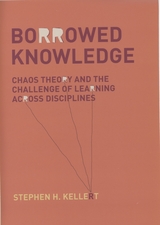 Borrowed Knowledge: Chaos Theory and the Challenge of Learning across Disciplines
Stephen H. Kellert
University of Chicago Press, 2008 What happens to scientific knowledge when researchers outside the natural sciences bring elements of the latest trend across disciplinary boundaries for their own purposes? Researchers in fields from anthropology to family therapy and traffic planning employ the concepts, methods, and results of chaos theory to harness the disciplinary prestige of the natural sciences, to motivate methodological change or conceptual reorganization within their home discipline, and to justify public policies and aesthetic judgments.
Using the recent explosion in the use (and abuse) of chaos theory, Borrowed Knowledge and the Challenge of Learning across Disciplines examines the relationship between science and other disciplines as well as the place of scientific knowledge within our broader culture. Stephen H. Kellert’s detailed investigation of the myriad uses of chaos theory reveals serious problems that can arise in the interchange between science and other knowledge-making pursuits, as well as opportunities for constructive interchange. By engaging with recent debates about interdisciplinary research, Kellert contributes a theoretical vocabulary and a set of critical frameworks for the rigorous examination of borrowing.
Borrowed Power: Essays on Cultural Appropriation
Edited by Bruce Ziff
Rutgers University Press, 1997 This book was a really informative and insightful collection of essays over cultural appropriation in our society today, mostly focusing on America's appropriation and use of Native American culture specifically more or less. The topics in this book covers a lot of ground from arts, land, and artifacts to ideas, knowledge, and symbols. The book doesn't try and point fingers blaming anyone rather then stating facts of the matter over the gray area of cultural appropriation. Overall a really nice read.
Borrowed Time: Photographs by Caroline Vaughan
Caroline Vaughan
Duke University Press, 1996 Caroline Vaughan’s photographs offer inspired and surprising visions of landscapes, still lifes, and the human form. In Borrowed Time, her images of nature and people, sometimes surreal and often arresting, follow each other to create a visual poem of opposition and likeness, physical beauty and balance. Compelling the viewer’s attention with delicate rich tones and meticulous technique, she holds the viewer’s gaze even when her subject is difficult. Most highly acclaimed for her psychologically complex but subtle portraits of family, friends, loved ones, and strangers, Vaughan’s work, though widely published and displayed, is collected here for the first time.
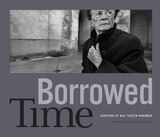 Borrowed Time: Survivors of Nazi Terezín Remember
Dennis Carlyle Darling
University of Texas Press, 2024 Honorable Mention — The International Photography Awards 2024 Book Category
Documentation, through photographs and interviews, of those who survived the unique Nazi ghetto/camp located at Terezín, Czech Republic.
Dennis Carlyle Darling has photographed and interviewed hundreds of Holocaust survivors who spent time at the German transit camp and ghetto at Terezín, a former eighteenth-century military garrison located north of Prague. Many of the prisoners were kept there until they could be transported to Auschwitz or other camps, but unlike German captives elsewhere, they were allowed to participate in creative activities that the Nazis used for propaganda purposes to show the world how well they were treating Jews. Although it was not classified as a “death camp,” more than 33,000 prisoners died at Terezín from hunger, disease, and mistreatment. In Borrowed Time, Darling reveals Terezín as a place of painful contradictions, through striking and intimate portraits that retrace time and place with his subjects, the last remnants of those who survived the experience. Returning to sites of painful memories with his interview subjects to photograph them, Darling respectfully depicts these survivors and tells their stories.
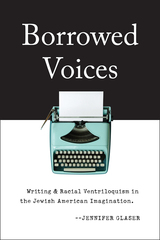 Borrowed Voices: Writing and Racial Ventriloquism in the Jewish American Imagination
Glaser, Jennifer
Rutgers University Press, 2016 In the decades following World War II, many American Jews sought to downplay their difference, as a means of assimilating into Middle America. Yet a significant minority, including many prominent Jewish writers and intellectuals, clung to their ethnic difference, using it to register dissent with the status quo and act as spokespeople for non-white America. In this provocative book, Jennifer Glaser examines how racial ventriloquism became a hallmark of Jewish-American fiction, as Jewish writers asserted that their own ethnicity enabled them to speak for other minorities. Rather than simply condemning this racial ventriloquism as a form of cultural appropriation or commending it as an act of empathic imagination, Borrowed Voices offers a nuanced analysis of the technique, judiciously assessing both its limitations and its potential benefits. Glaser considers how the practice of racial ventriloquism has changed over time, examining the books of many well-known writers, including Bernard Malamud, Cynthia Ozick, Philip Roth, Michael Chabon, Saul Bellow, and many others. Bringing Jewish studies into conversation with critical race theory, Glaser also opens up a dialogue between Jewish-American literature and other forms of media, including films, magazines, and graphic novels. Moreover, she demonstrates how Jewish-American fiction can help us understand the larger anxieties about ethnic identity, authenticity, and authorial voice that emerged in the wake of the civil rights movement.
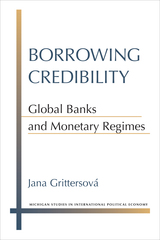 Borrowing Credibility: Global Banks and Monetary Regimes
Jana Grittersová
University of Michigan Press, 2017 Nations with credible monetary regimes borrow at lower interest rates in international markets and are less likely to suffer speculative attacks and currency crises. While scholars typically attribute credibility to domestic institutions or international agreements, Jana Grittersová argues that when reputable multinational banks headquartered in Western Europe or North America open branches and subsidiaries within a nation, they enhance that nation’s monetary credibility.
These banks enhance credibility by promoting financial transparency in the local system, improving the quality of banking regulation and supervision, and by serving as private lenders of last resort. Reputable multinational banks provide an enforcement mechanism for publicized economic policies, signaling to international financial markets that the host government is committed to low inflation and stable currency.
Grittersová examines actual changes in government behavior of nations trying to gain legitimacy in international financial markets, and the ways in which perceptions of these nations change in relation to multinational banks. In addition to quantitative analysis of over 80 emerging-market countries, she offers extensive case studies of credibility building in the transition countries of Eastern Europe, Argentina in 2001, and the global financial crisis of 2008. Grittersová illuminates the complex interactions between multinational banks and national policymaking that characterize the process of financial globalization to reveal the importance of market confidence in a world of mobile capital.
 Borscht Belt Bungalows: Memoirs Of Catskill Summers
Irwin Richman
Temple University Press, 2003 Every year between 1920 and 1970, almost one million of New York City's Jewish population summered in the Catskills. Hundreds of thousands still do. While much has been written about grand hotels like Grossinger's and the Concord, little has appeared about the more modest bungalow colonies and kuchaleins ("cook for yourself" places) where more than 80 percent of Catskill visitors stayed.
These were not glamorous places, and middle-class Jews today remember the colonies with either aversion or fondness. Irwin Richman's narrative, anecdotes, and photos recapture everything from the traffic jams leaving the city to the strategies for sneaking into the casinos of the big hotels. He brings to life the attitudes of the renters and the owners, the differences between the social activities and swimming pools advertised and what people actually received. He reminisces about the changing fashion of the guests and owners—everything that made summers memorable.
The author remembers his boyhood: what it was like to spend summers outside the city, swimming in the Neversink, "noodling around," and helping with the bungalow operation, while Grandpa charged the tenants and acted as president of Congregation B'nai Israel of Woodbourne, N.Y. He also traces the changes in the Catskills, including the influx of Hasidic families. Richman talks about what it's like to go back and to see the ghosts of resorts along the roads he once traveled.
 Bosnia: Faking Democracy After Dayton
David Chandler
Pluto Press, 2000 The Dayton Accords brought the Bosnian war to an end in November 1995, establishing a detailed framework for the reconstitution of the Bosnian state and its consolidation through a process of democratisation. In Bosnia David Chandler makes the first in-depth critical analysis of the policies and impact of post-Dayton democratisation. Drawing on interviews with key officials within the OSCE in Bosnia and extensive original research exploring the impact of policies designed to further political pluralism, develop multi-ethnic administrations, protect human rights and support civil society, Chandler reveals that the process has done virtually nothing to develop democracy in this troubled country. Political autonomy and accountability are now further away than at any time since the outbreak of the Bosnian war. The Afterword to this new edition updates Bosnian developments and adds an analysis of the structures and problems of the international protectorate in Kosovo.
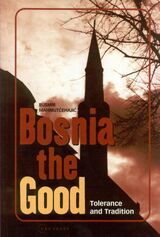 Bosnia the Good: Tolerance and Tradition
Rusmir Mahmutcehajic
Central European University Press, 2000 Bosnia the Good is an indictment of the partition of Bosnia, formalized in 1995 by the Dayton Accord. This unequalled volume is a plea from one of Bosnia-Herzegovina's most prominent dissidents appealing for Bosnia's communities to reject ethnic segregation and restore mutual trust. The author argues for the history and reality of a Bosnia-Herzegovina based upon a model of 'unity in diversity'. He shows that ethnic and religious cultures co-existed in Bosnia for centuries and that Croatian and Serbian leaders determined to enact their own nationalist programs are to be blamed for the conflicts that devastated a nation. He points out the decisive moment when the international community accepted the Serb/Croat argument that ancient ethnic hatreds were endemic to Bosnia and that ethnic segregation became not only acceptable but desirable. He examines the reasons why Western liberal democracies have regarded with sympathy the struggles of Serbia and Croatia for national recognition, while viewing Bosnia's multicultural society with suspicion. Bosnia the Good confronts the religious dimension of the Bosnian dilemmas from the perspective of a Bosniak committed to inter-religious dialogue. The author argues that the only way Bosnia will reclaim its unique civilization is more than simple tolerance among Serbs, Croats and Bosnians. They have to recognize that Judaism, Christianity and Islam all share the same deity and it is this common transcendent perspective that should open the door to the acceptance and celebration of religious diversity. Bosnia is at present divided and shaken to its foundations, but the author argues it could become a model for European progress. The greatest danger is for Bosnia to be declared just another ethnoreligious entity, in this case a 'Muslim State' ghettoized inside Europe. If protected and allowed to develop however, the author explains how Bosnia could find a place in a new European order.
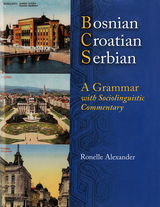 Bosnian, Croatian, Serbian, a Grammar: With Sociolinguistic Commentary
Ronelle Alexander
University of Wisconsin Press, 2006 Bosnian, Croatian, Serbian, a Grammar analyzes and clarifies the complex, dynamic language situation in the former Yugoslavia. Addressing squarely the issues connected with the splintering of Serbo-Croatian into component languages, this volume provides teachers and learners with practical solutions and highlights the differences among the languages as well as the communicative core that they all share. The first book to cover all three components of the post-Yugoslav linguistic environment, this reference manual features: · Thorough presentation of the grammar common to Bosnian, Croatian, and Serbian, with explication of all the major differences
· Examples from a broad range of spoken language and literature
· New approaches to accent and clitic ordering, two of the most difficult points in BCS grammar
· Order of grammar presentation in chapters 1–16 keyed to corresponding lessons in Bosnian, Croatian, Serbian, a Textbook
· "Sociolinguistic commentary" explicating the cultural and political context within which Bosnian, Croatian, and Serbian function and have been defined
· Separate indexes of the grammar and sociolinguistic commentary, and of all words discussed in both
 Bosnian, Croatian, Serbian, a Textbook: With Exercises and Basic Grammar
Ronelle Alexander and Ellen Elias-Bursac
University of Wisconsin Press, 2006 With the disintegration of Yugoslavia has come a shifting of linguistic boundaries, chiefly along political lines. Out of this complex situation three official languages have emerged: Croatian in Croatia, Serbian in Serbia, and both these languages plus Bosnian in Bosnia-Herzegovina. Bosnian, Croatian, Serbian, a Textbook introduces the student to all three. Dialogues and exercises appear in each language, presented side by side for easy comparison; in addition, Serbian is rendered in both its Latin and its Cyrillic spellings. Teachers may choose a single language to use in the classroom, or they may want to familiarize students with all three. Features of the textbook include: •All dialogues, exercises, and homework assignments available in Bosnian, Croatian, or Serbian
•Classroom exercises designed for both small-group and full-class work, allowing for maximum oral participation
•Reading selections written by Bosnian, Croatian, and Serbian authors especially for this book
•Vocabulary lists for each individual section and full glossaries at the end of the book
•A short animated film, on an accompanying DVD, for use with chapter 15
•Brief grammar explanations after each dialogue, with cross-reference to more detailed grammar chapters in Bosnian, Croatian, Serbian, a Grammar
Available separately, the audio supplement (ISBN 0-299-22110-5) offers audio recordings of all dialogues in Bosnian, Croatian, and Serbian, a Textbook.
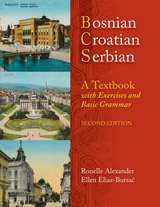 Bosnian, Croatian, Serbian, a Textbook: With Exercises and Basic Grammar
Ronelle Alexander
University of Wisconsin Press, 2010 Three official languages have emerged in the Balkan region that was formerly Yugoslavia: Croatian in Croatia, Serbian in Serbia, and both of these languages plus Bosnian in Bosnia-Herzegovina. Bosnian, Croatian, Serbian, a Textbook introduces the student to all three. Dialogues and exercises are presented in each language, shown side by side for easy comparison; in addition, Serbian is rendered in both its Latin and its Cyrillic spellings. Teachers may choose a single language to use in the classroom, or they may familiarize students with all three. This popular textbook is now revised and updated with current maps, discussion of a Montenegrin language, advice for self-study learners, an expanded glossary, and an appendix of verb types. It also features:
• All dialogues, exercises, and homework assignments available in Bosnian, Croatian, and Serbian
• Classroom exercises designed for both small-group and full-class work, allowing for maximum oral participation
• Reading selections written by Bosnian, Croatian, and Serbian authors especially for this book
• Vocabulary lists for each individual section and full glossaries at the end of the book
• A short animated film, on an accompanying DVD, for use with chapter 15
• Brief grammar explanations after each dialogue, with a cross-reference to more detailed grammar chapters in the companion book, Bosnian, Croatian, Serbian, a Grammar.
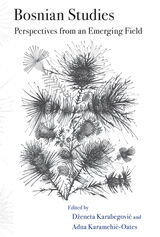 Bosnian Studies: Perspectives from an Emerging Field
Dzeneta Karabegovic
University of Missouri Press, 2023 It has been 27 years since the end of the war in Bosnia and Herzegovina, and the history of the conflict, its consequences, and long-term implications for the politics and lives of its citizens has remained a source of interest for scholars across the globe and across disciplines. This scholarship has included works by historians and political scientists seeking to explain the war’s origins with a view to Bosnia’s traditional multi-ethnic character and background. The country has been used as a case study in state- and peace-building, as well as to study the implications of ongoing transitional justice processes. Other scholars within the fields of human rights and genocide studies have focused on documenting the war crimes committed against the people of Bosnia and Herzegovina during the conflict and the mass-scale displacement of people, mostly Bosnian Muslims, from their homes and homelands. International law scholars have carried this work further, tracing the development of courts created in response to war crimes in Bosnia and their effectiveness in generating justice for victims.
Diaspora communities have formed in North America (especially in St. Louis), Europe, and Australia because of war and displacement, and have themselves become a considerable topic of study spanning the disciplines of anthropology, migration studies, political science, memory studies, conflict and security studies, psychology, and geography.
This volume seeks to illuminate how Bosnian migrant and diaspora scholars are contributing to the development of Bosnian Studies. The authors included in this volume are either writing from their (new) home bases in Australia, Austria, Canada, Switzerland, the United Kingdom, and the United States, among others, or they have returned to Bosnia after a period of migration. Their chapters have distinct entry points of inquiry, demonstrating how scholars have integrated Bosnia as a theme across the range of disciplines in which they are situated. The selections included in the volume range from literary analysis to personal memoirs of the conflict, from studies of heritage and identity to political science analysis of diaspora voting, to genocide studies and questions of (or lack of) ethics in the growing field of Bosnian Studies.
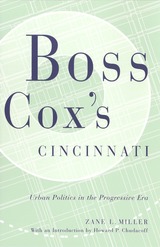 Boss Cox’s Cincinnati: Urban Politics in the Progressive Era
Zane L. Miller
Ohio State University Press, 2000 In the late nineteenth century, a new era began in American urban history, characterized by an explosion of both the populations and the proportions of cities, obliterating their traditional social and physical characteristics. Commercial businesses relocated, slums emerged around the core, and new residential areas were established along the periphery. The period was one of extreme disorder—labor and ethnic unrest, election violence, rising crime rates—but it was also a time of political innovation and civic achievement.
In documenting the changes Cincinnati experienced during the Progressive Era, Zane L. Miller provides a clear perspective on the processes of urbanization that transformed the American city. His focus is political because politics provided continuity amid the diversity of city life. The most important aspect of political continuity in Cincinnati and in other cities was "bossism," often depicted as an example of corruption, but which was in many cities part of the quest for a new urban order. In Cincinnati, Boss George B. Cox's machine was a response to the disorder of the times; interestingly, the machine actually helped to control disorder, paving the way for later reforms. Miller carefully explores both the nature and the significance of bossism, showing how it and municipal reform were both essential components of the modern urban political system.
Originally published in 1968, Boss Cox's Cincinnati is considered a classic in the field of urban studies.
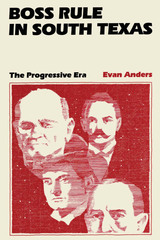 Boss Rule in South Texas: The Progressive Era
By Evan Anders
University of Texas Press, 1982 Four men played leading roles in the political drama that unfolded in South Texas during the first decades of this century: - James B. Wells, who ruled as boss of Cameron County and served as leading conservative spokesman of the Democratic Party in Texas;
- Archer (Archie) Parr, whose ruthless tactics and misuse of public funds in Duval County established him as one of the most notoriously corrupt politicians in Texas history;
- Manuel Guerra, Mexican American rancher and merchant whose domination of Starr County mirrored the rule of his Anglo counterparts in the border region;
- John Nance Garner, who served the interests of these bosses of South Texas as he set forth on the road that would lead him to the United States vice-presidency.
Evan Anders's Boss Rule in South Texas tells the story of these men and the county rings they shaped in South Texas during the Progressive Era. Power was the byword of the bosses of the Lower Rio Grande Valley, and Anders explores the sources of that power. These politicos did not shirk from using corrupt and even violent means to attain their goals, but Anders demonstrates that their keen sensitivity to the needs of their diverse constituency was key to their long-term success. Patronage and other political services were their lifeblood, and the allies gained by these ranged from developers and businessmen to ranchers and Mexican Americans, wealthy and poor. Besides examining the workings of the Democratic machines of four South Texas counties, Anders explores the role of the Hispanic populace in shaping the politics of the border region, the economic development of the Lower Rio Grande Valley and its political repercussions, the emergence and nature of progressive movements at both local and state levels, and the part played by the Texas Rangers in supporting bossism in South Texas.
Boss Rule in the Gilded Age: Matt Quay of Pennsylvania
James A. Kehl
University of Pittsburgh Press, 1981 Matt Quay was called “the ablest politician this country has ever produced.” He served as a United States senator representing Pennsylvania from 1887 to 1904. His career as a Republican Party boss, however, spanned nearly half a century, during which numerous governors and one president owed their election success to his political skills. James A. Kehl was given the first public access to Quay's own papers, and herein presents the inside story of this controversial man who was considered a political Robin Hood for his alleged bribe-taking, misappropriations of funds, and concern for the underprivileged-yet he emerged as the most powerful member of the Republican Party in his state.
 Boss-Busters and Sin Hounds: Kansas City and Its Star
Harry Haskell
University of Missouri Press, 2007 At the turn of the twentieth century, the Kansas City Star was a trust-busting newspaper acclaimed for its crusading progressive spirit; fifty years later it was a busted trust, targeted in the most important antitrust action ever brought against an American daily. Now Harry Haskell tells the tale of the Star’s rise and decline against the richly textured backdrop of Kansas City—the story of how a newspaper and a city grew together and ultimately grew apart. Boss-Busters and Sin Hounds takes readers into the city room and executive offices of one of the most respected American newspapers, whose influence extended beyond its own community to international affairs. Re-creating life at the Star from the inside, the book traces the shifting fortunes of a great newspaper and the compelling “power of purpose” it exerted from the birth of the progressive movement in the 1880s to the 1950s. This fascinating tale—with underlying themes of sin and redemption, high-minded ideals and gutter politics—is populated by a cast of larger-than-life characters, ranging from power brokers to presidents and including such Kansas City notables as Tom Pendergast, J. C. Nichols, and Frank Walsh. But at heart this is the story of three men with contrasting personalities and agendas who shaped the newspaper over more than three-quarters of a century: William Rockhill Nelson, among the last of the great “personal” editors from journalism’s golden age; the scholarly Henry J. Haskell, who led the Star to its peak of influence in the 1930s and ’40s; and Roy A. Roberts, who went on to combine the roles of newspaper publisher and political kingmaker. Along the way, Haskell recounts such milestones as the Star’s role in the City Beautiful movement that helped transform America’s urban centers; the nation’s entry into two global wars; a bold but ill-starred experiment in employee ownership; and the paper’s on-again, off-again battle with Boss Pendergast’s legendary political machine. And he brings into focus issues that remain timely today, from social and political reform to the very role of newspapers in a democracy, while also drawing parallels with recent American history—disillusionment with liberalism, the hijacking of the GOP by the far right, America’s go-it-alone attitude—that are as alarming as they are instructive. As Haskell shows, the evolution of American journalism from crusading newspapers to pawns of corporate culture was already under way in the early 1900s and was substantially complete by midcentury. Boss-Busters and Sin Hounds chronicles the glory days of an illustrious newspaper as it opens new windows on a city’s history.
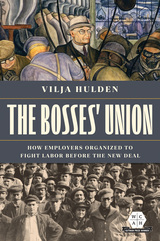 The Bosses' Union: How Employers Organized to Fight Labor before the New Deal
Vilja Hulden
University of Illinois Press, 2023 At the opening of the twentieth century, labor strife repeatedly racked the nation. Union organization and collective bargaining briefly looked like a promising avenue to stability. But both employers and many middle-class observers remained wary of unions exercising independent power. Vilja Hulden reveals how this tension provided the opening for pro-business organizations to shift public attention from concerns about inequality and dangerous working conditions to a belief that unions trampled on an individual's right to work. Inventing the term closed shop, employers mounted what they called an open-shop campaign to undermine union demands that workers at unionized workplaces join the union. Employer organizations lobbied Congress to resist labor's proposals as tyrannical, brought court cases to taint labor's tactics as illegal, and influenced newspaper coverage of unions. While employers were not a monolith nor all-powerful, they generally agreed that unions were a nuisance. Employers successfully leveraged money and connections to create perceptions of organized labor that still echo in our discussions of worker rights.
 Boston A to Z
Thomas H. O'Connor
Harvard University Press, 2000 From its origins as a Puritan settlement on the Shawmut Peninsula to the multicultural capital of the knowledge industry that it is today, the city of Boston has played a significant role in our nation's history. In this book, the preeminent historian of Boston, Thomas H. O'Connor, takes readers on a delightful tour of the city, past and present. Drawing on lifelong acquaintance as a native son and scholar, O'Connor has assembled a personal, informal, and eclectic series of essays about Boston's people, places, and events.
Along the way you will meet figures of national significance and local heroes (or rogues), from John Adams and Phillis Wheatley to "Honey Fitz" and the Brink's gang; visit spaces sacred and profane, from the African Meeting House and Holy Cross Cathedral to Filene's Basement and the L Street Bathhouse; learn about institutions of civic importance and local color, from the Museum of Fine Arts and Massachusetts General Hospital to private clubs and nightspots; and be enlightened about the lore surrounding such quintessentially Boston topics as baked beans, the Curse of the Bambino, and the Steaming Kettle.
Boston A to Z wears its learning lightly but never fails to inform as it entertains. While celebrating some of Boston's finest achievements, it doesn't shy away from darker episodes. Longtime residents will find enlightenment about familiar and arcane aspects of their city, and visitors or newcomers will enjoy an engaging introduction to the life, culture, and history of Boston.
Boston: A Topographical History, Second Enlarged Edition
Walter Muir Whitehill
Harvard University Press THIS EDITION HAS BEEN REPLACED BY A NEWER EDITION.
In this urbane and delightful book, Walter Muir Whitehill follows the course of Boston's history, describing the changing face of the city and the society that changed with it, through more than three hundred years. This edition includes a chapter describing the major changes of the city since 1958, as well as new pictures. Generously illustrated, written with a knowledge of and affection for a great city that are visible on every page, this book speaks equally to those who know Boston well and those who are discovering the city for the first time.
Boston: A Topographical History, Third Edition, Enlarged
Walter Muir Whitehill and Lawrence W. Kennedy
Harvard University Press, 2000 This urbane and delightful book covering more than 300 years of the course of Boston's history has now been enlarged with an account of the city's new urban design, architecture, and historic preservation and is richly illustrated with 32 additional photographs and drawings. In the last three decades momentous changes have visited this colonial city made modern. Lawrence Kennedy portrays the Boston that preserved much of the intimacy of the remembered place while creating a dramatic new skyline. Boston has been remarkably transformed while keeping human the features of a beloved city.
|
|
